
- Case Studies
- Schedule A Call

Luxury Buyer Personas In Luxury Travel
In this episode we discuss luxury buyer personas. What are they, why do you need them and how do they fit into a larger marketing strategy for a luxury travel brand?
What we cover in this episode:
- What are luxury buyer personas?
- How do they fit into a larger luxury travel marketing strategy?
- What are the most important elements of a luxury buyer persona?
- How you can use real world data to make your personas more accurate.
Why are luxury buyer personas an important part in every luxury marketing strategy?
Buyer personas are an integral part of the inbound philosophy and as such an important tool in the modern luxury marketers toolbox. Great personas should incorporate demographics, geo-targeting, psycho-graphics and other data sources. With accurate personas, a luxury travel marketer can create copy, branding materials, campaign and communication that resonates with their ideal HNWI buyer. Wealthy people are often quite unique and different, so it makes absolute sense to create multiple personas if your business tries to cover multiple high-net-worth segments. For example, if we are talking about a hotel marketing strategy, you might want to cover both high-net-worth families travelling with kids and affluent business travelers.
Creating personas can become a great kick-off project to get your sales and customer service teams on board as well. By leveraging their client-facing expertise you can imbue your personas with real life characteristics. Campaigns on average, will perform better if they are based on accurate personas and real-world data. So make sure not to skip persona creation as an important part in your planning phase.
Did you enjoy this podcast?
Do you want more? We also have a free Luxury Marketing Funnel Guide that you can download by clicking on the button below!
MARKHAT.COM
Marketing Hotels & Tourism | Research, News & Tutorials for Hospitality & Destinations
Marriott & Starwood Luxury Brands Travel Personas – Bloomberg
Nov 30, 2016 | personalization , travel persona | 1 comment
Travel Personas are in vogue as this thought-provoking interview reveals. Marriott & Starwood Luxury Brands Travel Personas include three (3) main Personality types of the Luxury Traveler. They match up well with the latest from PersonaHolidays, which we wrote about recently, as it implemented its personal vacation planner across the Barbados Tourism Encyclopedic website, Barbados.org. See this at Barbados Gets Personal .
The travel personas for Marriott/Starwood noted by Tina Edmundson, Marriott’s global brand officer, in her interview with Bloomberg can be compared to the pioneering work done by PersonaHolidays , which has created a personalized travel planning and recommendation engine that can be used by hotel marketers. According to Tina Edmundson, Marriott/Starwood luxury brands include “The Ritz-Carlton, Ritz-Carlton Reserve, Bvlgari, St. Regis, Edition, the Luxury Collection, JW Marriott and W”. She says the collection was designed to represent all luxury customers and adds that Marriott & Starwood Luxury Brands Travel Personas cover all these travelers, no matter their mood or preference.
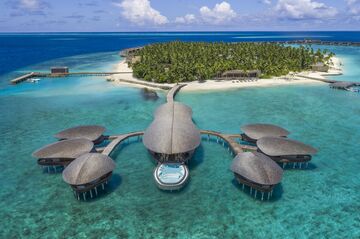
Tina Edmundson, Marriott’s global brand officer, gives Bloomberg a revealing first look at her vision of the Starwood/Marriot merger. Source: Marriott and Starwood Reveal Future of Their Luxury Brands – Bloomberg
Main Personas Represented by Marriott
Marriott has identified two main luxury travel personas. It has characterized the Ritz-Carlton, St. Regis, and JW Marriott as “ classic luxury ”, while the other five brands are considered purveyors of “ distinctive luxury ”. “This is largely an indication of style: traditional and business travel-friendly (“classic”) vs. modern and boutique-y.”
Tina adds that their are really more like the “ Autograph Collection” which is not accounted for in the above luxury groups. Properties like (Pier One Sydney Harbour; Atlantis Paradise Island) are being considered part of the “ distinct premium ” portfolio, alongside Le Meridien and Westin. She agreed that there are “some instances where a hotel that’s part of Autograph Collection could be a better fit for the Luxury Collection, and vice versa,” but said the company has “no plans to make any changes.”
Luxury Personas: Classical, Distinctive and Autograph
Tina clarifies as follows: “With Ritz-Carlton, this consumer is really leaning toward discovery. And for St. Regis, it’s really about status and connoisseurship.” Each brand caters to these mindsets—”and those can be blown up to help articulate the differences more clearly.”
Ritz-Carlton, she says, is “for facilitation” and those personas like “to explore a new place”. Ritz, she says, connects people to places, while St. Regis is the place where people want to see and be seen. “The St. Regis customer is looking for the hotel to serve up performances by jazz legends or signature rituals like midnight supper and St. Regis bloody marys.”
PersonaHolidays Comparison

In HowToFacinate terms, Brands Archetype are defined by the two main characteristics of how people express themselves and conversely, what determines what they like and need in a holiday experience . They may have one of 7 attributes as the primary attribute – that is, they are primarily power -driven, or motivated by passion , innovation , mystique , trust and mindfulness (alert) .
The Connoisseur is Prestige and Passion. Avant-Guard is Prestige and Innovation. The Archictect is Prestige and Mystique. Missing in the Prestige coupling is Power (the Victor), Trust (Blue Chip) and Alert (Scholar) – All have slightly different appeals that PersonaHolidays predicts and matches. You can see this in action on the world’s first implementation of the PersonaHoliday personal vacation planning at holidays.barbados.org/stay
Naturally, archetypes by themselves are not as restrictive as this might imply. For illustration purposes we show how Prestige is a determinant for many travelers looking for a luxury vacation.

Presige is a driving force for most who have high expectation and love elegance and luxury. But it need not be the primary determinant. The travelers who is say more innovative may have prestige as a second or third attribute. If they score higher on both innovation (first) and Prestige (second) that suggest they are something of a Trendsetter – the twin to Connoisseur. This has differences in predicting likes and preferences. Prestige may also not be a key determinant for travelers looking for a luxury holiday, but it often is. Typically is someone is seeking elegance and luxury you will find prestige ranking high in their attributes.
Predicting Travel Personas
The job of the PersonaHolidays Matchwords engine is to predict what hotels best suit the visitor, a job that it learns and perfects with every visitor. For example, the archetype defined by passion and innovation is the Catalyst and her twin is the Rockstar .
There are many travelers like Catalysts and Rockstars who like luxury and for them prestige is not their top characteristics. But if it is a significant parameter in their makeup we would predict that luxury and elegance may well appeal, though it may be tinged with their primary drivers. The personality who score high in Mystique and has a high sore in prestige ( Royal-Guard ) likes elegance, but typically are more understated, sort of like an understated Connoisseur.
Every personal recommendation engine has to account for these variables in human behavior and personality. That’s the work that the Persona Holidays Match words engine is perfecting with every travel click.
Archetypes are not Travel Personas
Archetypes by themselves are not predictors of travel persons. They are however indicators of aspects or attributes that define a travel-persona. That is why Personholidays uses a lot of behaviors triggers to analyze the travel related attributes of a traveler using the service. Detail behaviors analysis digs deep into Big Data to glean insights, make relations and predict outcomes. Persona-matchwords are the travel related words that are derived from archetypes in conjunction with actual search terms and options.
more about matchwords
As they say Persona is an expert system that analyzes behavior and delivers a product according to personality. It matches hotels with travelers based on compatibility of character using psychology and intelligent observation.
About PersonaHolidays
Travel Weekly reports that Marriott Starwood has created a new division to market their luxury properties – see http://www.travelweekly.com/Travel-News/Hotel-News/Marriott-creates-division-for-luxury-brands
Trackbacks/Pingbacks
- URL - ... [Trackback] [...] Read More here: marketinghotelsandtourism.com/marriott-starwood-luxury-brands-travel-personas/ [...]
- How Small Travel Brands Personalize Vacations | PhocusWire - MARKHAT.COM - […] not designed this way and instead gives traveller endless choice to wade through. Travelers want recommendations not more […]
- Personalizations Impact on Hotels - PhocusWire Webinar Video - MARKHAT.COM - […] May host a panel of industry leaders to discuss what is personalization for hotels and hospitality in the current…
Submit a Comment Cancel reply
You must be logged in to post a comment.

Post by date
Recent posts.
- Avid Travellers Barbados Guide
- A Spanish Treat Andalusia! Malaga & Sevilla
- Rogues in Paradise Turns Travel Literature Upside-down
- New York Time Featured Tourism Professional Reveals Winning Strategies
- SEO & RankBrain – Technology in Transition
Recent Comments
- Lesson From Thomas Cooks Failure - MARKHAT.COM on Book Preview Marketing Hotels and Tourism Series
- Lesson From Thomas Cooks Failure - MARKHAT.COM on DIGITALMEDIA Marketing Hotels & Tourism Online Book2
- How Social Media Changes Travellers Minds - MARKHAT.COM on Digital Media Chapter 4 Bonus – Spreading the Word
- Hotels Tourism Instagram Marketing Tutorials | WorldNews | Travel Wire News on The SEO Cycle | Backlinks, Tactics & Google Penalties
- Hotels Tourism Instagram Marketing Tutorials | WorldNews | Travel Wire News on PersonaHolidays Taps HowToFascinate FascinatingTravelers Technology
- Entries feed
- Comments feed
- WordPress.org
Related Posts Plugin
Personalization’s impact on hotels – insights from phocuswire webinar.

Source: VIDEO: Personalization and its impact on hotels – past, …
Mood MatchMaker.Travel – The New Frontier For Bookings

Personalization for Every Mood In the last few months there …
Expedia CEO Mark Okerstromon Personalization

TNOOZE – Source: Expedia CEO Mark Okerstrom on learnings from …
Try GuestRevu LITE Free forever

- What luxury travellers want, and how to attract them
28 February, 2024
The global luxury travel market is huge, not in the number of guests with substantial buying power but the astonishing level of buying power that these luxury travellers have. The good news for hoteliers targeting those top 5% of guests is that they seem to spending more every year. The global Luxury tourism market had an estimated total revenue of USD 1,308.15 billion in 2022, and is projected to be worth USD 3,023.78 billion by 2032.
In this article
- Millennials & Aspiring Luxury
Baby Boomers and Absolute Luxury
- Barefoot Luxury
- Multigenerational Travel & Grand Gatherings
- Sustainability
- Wellness tourism
Bleisure/Bluxury
- Staycations
- Offer unique experiences
Offer authenticity and immersive guest experiences
Offer instagrammable moments.
- Offer Hyperpersonalisation
Aside from these travellers being prepared to spend up to $3000 per night, with the average landing at a comfortable $500 per night according to a Bloomberg MLIV Pulse Survey , they are also taking more than double the number of trips that your regular traveller may take. A study by Resonance found that “the top five per cent take 14.3 trips per year (half for business and half for leisure, totalling an average of 29 days per year). U.S. travellers overall take an average of 4.8 trips.”
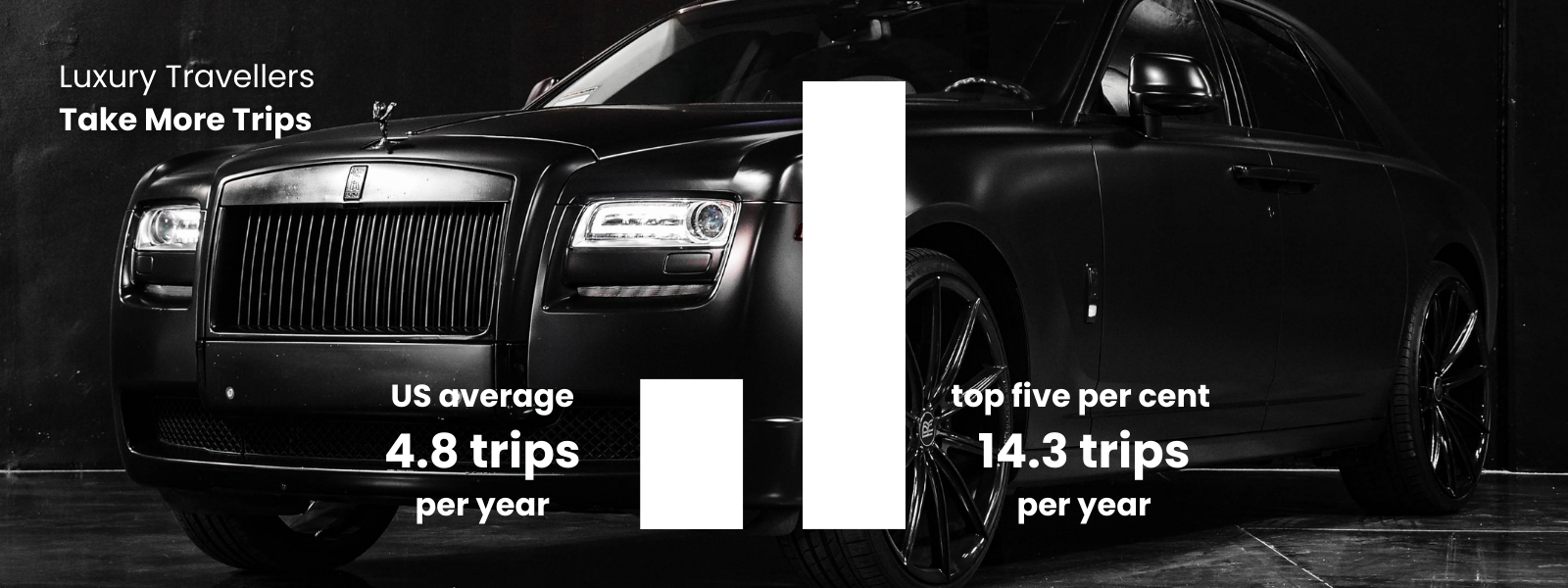
One of the biggest benefits of appealing to the luxury market is that while the rest of the world may be affected financially by global events (e.g. covid-19, the Russia-Ukraine War and the cost of living crisis) these most affluent travellers have the wealth to continue to spend despite global economic turmoil.
How do you attract this small but lucrative target segment to your property?
Step 1: Know who you are talking to
The luxury travel industry is fairly complex, with different demographic groups looking for different experiences from their luxury holiday. While they all have significant buying power, marketing to the different guest segments would look quite different.
By age group, the market is segregated into Millennials, Generation X, Baby Boomers, and the Silent Generation. Depending on the degree of wealth these types of luxury travellers will spend on travel, products are further segmented into absolute luxury, aspiring luxury and accessible luxury. The absolute luxury segment spends the most and most frequently. However, targeting aspiring and accessible luxury travellers could lead to a significant boost in your bottom line, as they are still frequent travellers who are looking for exceptional experiences in their next destination.
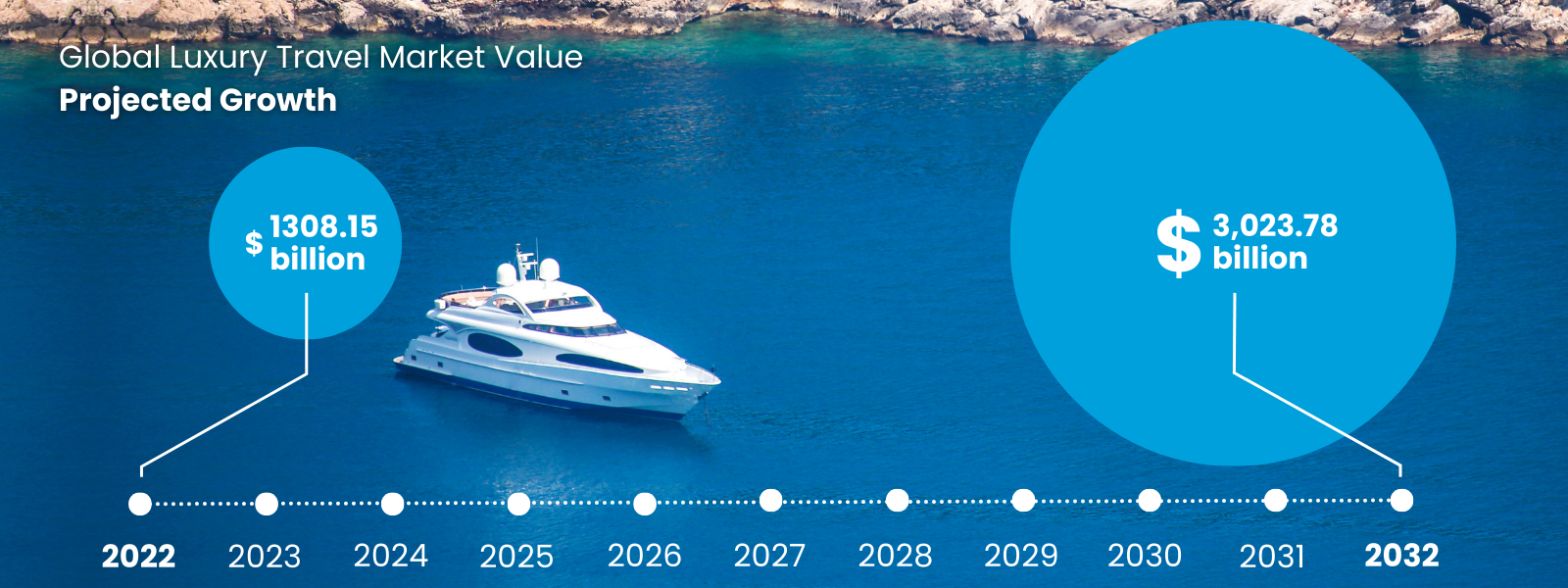
Millennials & Aspiring Luxury
One significant luxury demographic group are the Millennials, these are travellers between the ages of 28-43 who were born into the age of technology and use it to their advantage. They generally seem to be more active than the Baby Boomers and also seek unique experiences and culturally immersive trips over predictable luxury hotel stays.
These travellers tend to seek authenticity and want to become involved in the day-to-day living of the location they are visiting. They are also looking for the most ‘ Instagrammable ’ location for their vacation, to be able to share it with friends and family on their social media platforms. While Millennials encompass a large part of the luxury travel market, according to a report by Allied Market Research , Millennials “spend $527 a day on a trip which is 62% less than their older counterparts.”
In line with the findings from the Allied Market Research report, many of the Millennial travellers are often classified as ‘aspiring luxury’ and ‘newly rich’ travellers. These moderately wealthy individuals value travel and are willing to part with significant amounts of their disposable income for travel. On average, they take five business and leisure trips annually, which are generally shorter luxury breaks, in comparison to their older counterparts, due to financial constraints.
While there is still significant wealth attributed to the aspiring and accessible luxury travel market there is not much that can compare to the affluence of a small percentage of high-net-worth individuals (HNWIs). However, if you are catering to these guests you will know that they demand opulence, exclusivity, careful curation and innovation. They expect private yachts to remote locations, gastronomic journeys through foreign countries and a private butler to see to their every need.
Considering that 20% of over 65s in the UK are HNWIs, and that Baby Boomers control about half of the wealth in the United States (while only accounting for 20% of the population ), it’s not surprising that Baby Boomers had the highest share of the Luxury travel market in 2022 at about 41.57%.
These guests are often retired or soon to retire and have the disposable income and time to take extended luxury vacations, and they are generally seasoned travellers and know exactly what they expect from their next holiday. These travellers also have the means to employ someone else to do their research and running around, and they do. When it comes to booking, they often seek the advice of travel agents rather than going it alone online – 85% of luxury travellers told Deloitte that the best way to book personalised luxury travel was through a travel advisor.

Step 2: Keep Up to Date with Luxury Travel Trends
No matter which luxury segment you are marketing to, there are some clear trends across the luxury travel market. One of which is the significant change in consumer behaviour from seeking material possessions to spending disposable income on unique experiences.
“In 2022, luxury travel took on a new perspective, prioritizing experiences over material possessions. Travellers sought personalized and customized journeys, while also embracing sustainability and responsible travel practices.” – Global Data
Many of these travel trends are not exclusive to luxury travellers, but when done on a luxury budget many of these trends translate into something a lot more enticing and lucrative for property owners.
Barefoot Luxury
Barefoot luxury can be defined as experiencing comfort, sophistication and luxury in a laid-back environment. Traditional luxury often requires some input from the guest – they have to look, dress and act the part of the luxury tourist. Barefoot luxury gives the guest space to truly relax and quite literally let her hair down, while still being treated like a VIP.
It’s all about embracing comfort and encouraging guests to experience your surroundings while at the same time providing an excellent, exclusive and luxurious experience. Over the years, barefoot luxury has come to be associated with nature and local experiences together with comfort, making it a possibility regardless of where you find yourself. Barefoot luxury requires careful planning to ensure the right balance between authenticity and comfort.
Andrea Britt, the co-founder at Secret Getaway summarised it perfectly in an article for IOL “Barefoot luxury isn’t about being cheap, it is about the immersive experience that guests get to enjoy. These experiences are well out and different to what many have experienced before,” she explained.
Safari and adventure travel – the stereotypical barefoot luxury holiday – was the single largest luxury travel segment in 2022, accounting for 34.2% of market share and a revenue of USD 461.65 billion. Other variations on the barefoot luxury theme, such as wellness retreats, are also increasing in popularity.
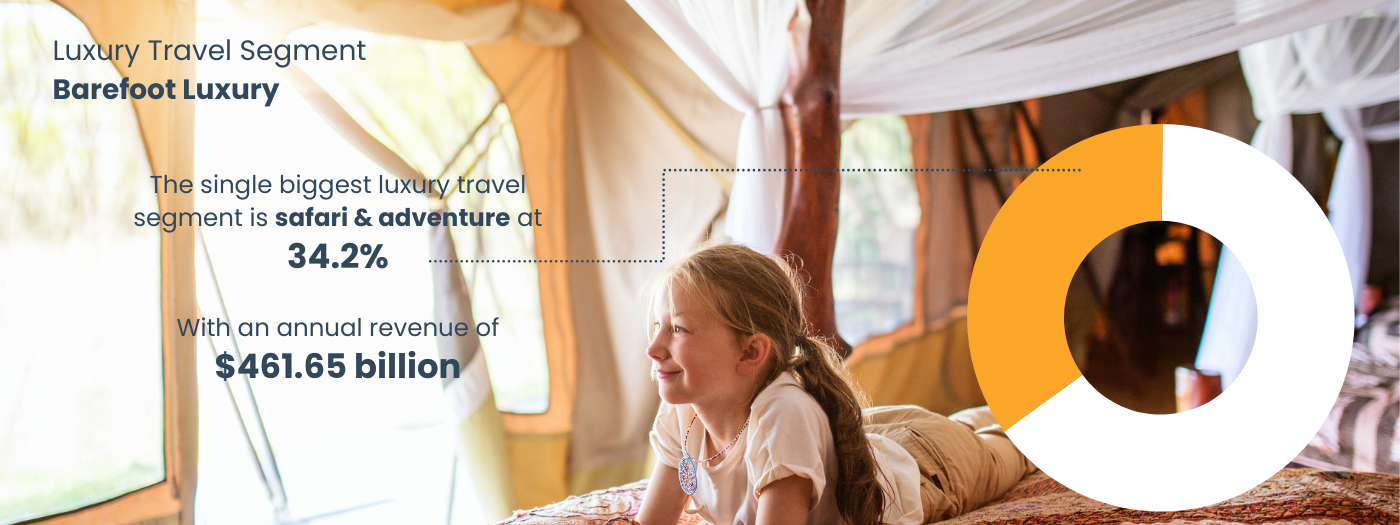
Multigenerational Travel & Grand Gatherings
Another two travel trends which have leaked into the luxury travel market include the increase in multigenerational family holidays and the newer concept of Grand Gatherings. Grand Gatherings refer to a large group of travellers who travel together for a special event or function. These groups may be somewhat related, for example, several family units travelling together to create a gathering.
Around 40% of the top five per cent of earners planned to take a multigenerational trip in the next year, according to an Altiant survey , and Jack Ezon, founder of Embark Beyond, a luxury travel group focussing on Ultra-HNWIs, told Forbes : “Multigenerational travel is still the biggest growth area for us, and has been consistently growing for years. In 2019 multigen experiences grew by 22% and now account for 32% of our transactions and 43% of our overall revenue”.
“In line with the continuous growth of multi-generational and group gathering demand, villa vacations continue to grow with the greatest growth in what we call the “mega-villa” segment. Families still account for the lion's share of villa sales with about 60% of villa requests. However, a huge emerging market segment accounts for almost 30% of villa demand, and that is small gatherings of non-family constituents. This is one of the most important market phenomena that has emerged from Covid.” – Embark Travel Trends 2023 report
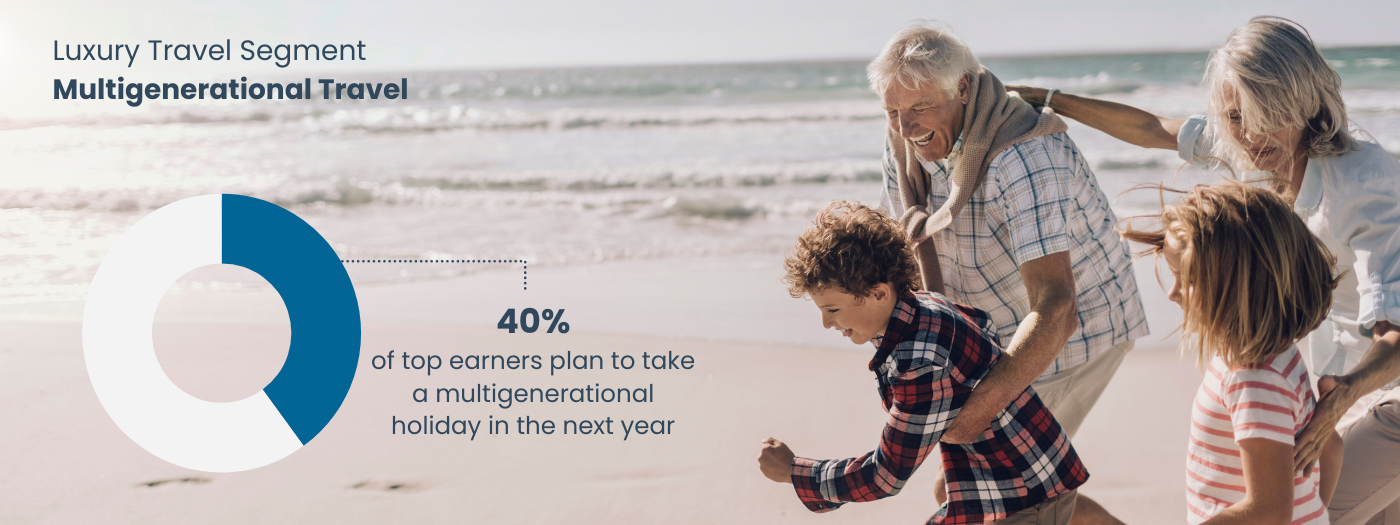
Sustainability
Sustainability is a hot topic in all industries, from the revolt against using single-use plastics to increasing scrutiny of the carbon output of delivery and manufacturing processes. Unsurprisingly, consumers are also looking for sustainable ways to travel.
Aside from doing your bit for the earth, you will be a more attractive option for many travellers if you have green credentials to flaunt - over 80% of respondents in a Statista survey said that sustainable travel was important to them.
“A business with a focus on sustainability is a business which actively seeks out engagement with people, community and planet.” — EHL
This may be especially true among those who don’t mind spending a little bit more to ease their conscience. Many affluent travellers want to know that their luxurious and extravagant trips are not coming at the expense of the environment and therefore many luxury travellers are searching for eco-conscious travelling. When luxury travel advisory group Virtuoso surveyed their clients, 74% of them said they were “willing to pay more to travel sustainably if they know where their money’s going.”
Post-pandemic sustainable travel has also come to include not only the preservation of the environment but the preservation of cultural heritage and local communities as well. This feeds back into the loop of luxury travellers looking to immersive themselves in a location, and experience all that it has to offer. The upside is that incorporating local cuisine, culturally immersive excursions and embracing the local environment means that much of the influx of wealth via travellers is dispersed into the local community.
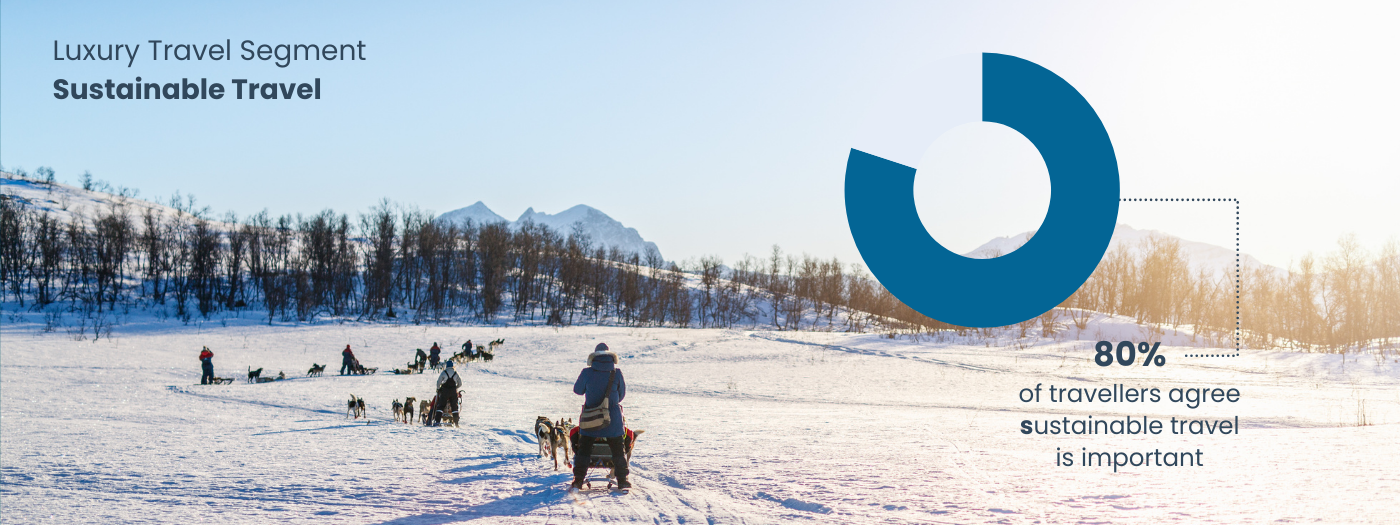
Sustainability should therefore not simply be seen in terms of once-off changes that can be made or a problem that can be fixed. It requires a long-term commitment to being sustainable. And when sustainability is committed to, it becomes not just a feature that you can advertise to your environmentally conscious clientele, but an investment in your, and your community’s, future.
Get started going green with insights from the WTTC [interview]
Wellness tourism
Wellness is one of the fastest-growing sectors in the hospitality industry, accounting for 476.1 billion in 2022, and predicted to be worth 1.02 trillion by 2030.
Travellers across the wealth spectrum appear to agree that travel can be beneficial for mental and physical wellness, and that this is something worth spending time and money on. When they were surveyed in 2022, 44% of Booking.com’s users were planning a meditation or mindfulness holiday in the coming year, and 42% wanted a break with a focus on physical or mental health.
In 2021, 88% of survey respondents told American Express they believed travel was good for mental health, and 76% said they wanted to spend more on travel that would improve thier wellbeing, and 55% said they would pay more for additional wellness activities. In an Altiant survey , 61% of the top five per cent of earners said that wellness played a major role in their travel plans.
Interestingly enough wellness tourism is experiencing many cross-overs with other key luxury niches such as sustainable travel and barefoot luxury as many travellers are foregoing the commercial spas and cookie-cutter retreat centres and rather looking at doing nature immersive experiences and reconnecting with Mother Earth.
“Luxury retreats that offer mountain hikes, forest bathing, and wild swimming even in cold waters adopting the Wim Hof cold therapy method, will be on the list of high-end travellers looking for a dive into the wild in 2024.” – Me Time Away Magazine
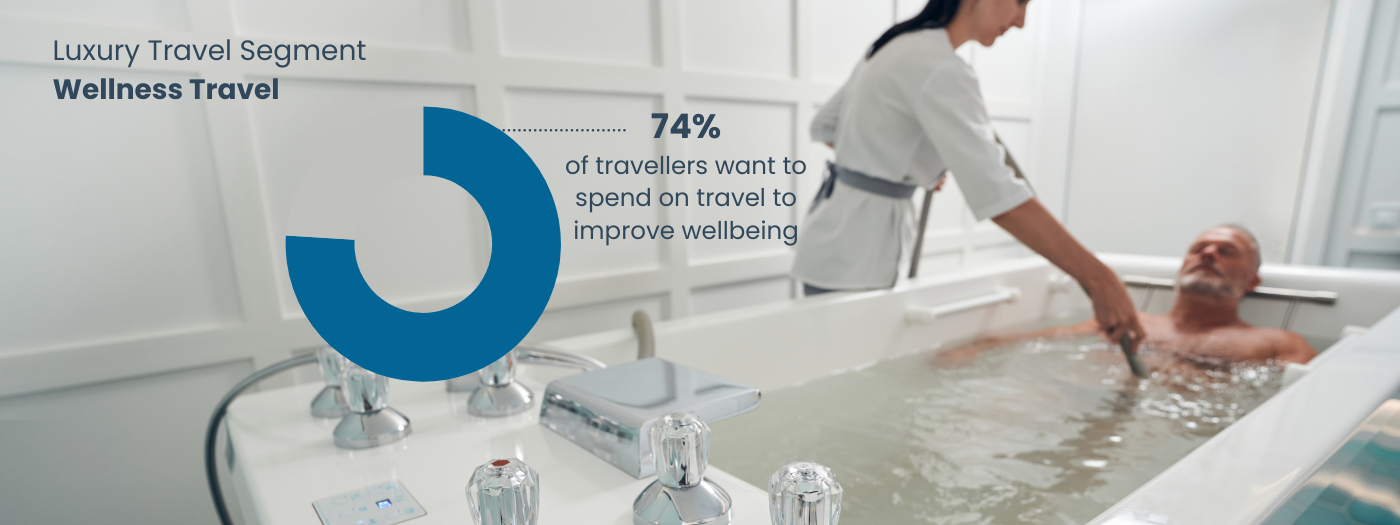
Bleisure travellers are those people who mix or combine travelling for business and pleasure – some do both at the same time and some go to places for business and then stay for a few days afterwards for a luxury vacation. Bluxury is a similar concept but with the addition of these business and leisure guests seeking absolute luxury.
Blesiure travel has been on the increase post-covid. With many employees working remotely or living ‘nomadically’, there is no reason to rush home after a work trip, as long as there is sufficient Wifi and other business-related amenities, remote workers are free to stay on and experience the local culture. In addition to this many employers are using travel to bring together teams who work remotely, trying to encourage team morale and communication.
“Growth in commercial flight bookings exceeded leisure travel for a portion of 2022 and is now recovering in tandem with leisure travel in 2023, up 42% year-over-year-to-date change from 2022 to 2023.” – Mastercard Economics Institute
Staycations
A trend that was borne out of necessity during the travel restrictions of 2020, the ‘staycation’ has evolved into an affordable and convenient way for travellers to get their taste of luxury. Whether they are on a tighter budget than the traditional luxury traveller or if they don’t have available time to take a long trip to new destinations you can offer them the same solutions to their problems of needing a rest, feeling pampered and feeling like they are experiencing exclusive luxury and they can do that around the corner from their home.
As we have mentioned before, the luxury traveller is looking for an experience, not just a lavish hotel room. With that in mind hoteliers looking to capitalise on the ‘staycation’ phenomenon need to think outside the box and create the same exclusive experiences that the luxury traveller is seeking but from a different perspective. Place focus on those elements that symbolise ‘luxury vacation’ in the mind's eye of your guest. When creating your staycation package, look to include a bottle of champagne, an upgrade to a suite, or maybe a cooking class.
The idea of a staycation is to get away from day-to-day life. You need to sell your guests on the fact that they can achieve this without travelling to a faraway place. To do this, you’ll need to create that sense of escape within the grounds of your own hotel. Consider creating a weekly or monthly event schedule focused on movies, music, wellness, and meditation.
Step 3: Adjust your offerings
Offer unique experiences .
According to MasterCard’s report on Travel Industry Trends , spending on things increased a measly 12% from 2019 to 2023, while travellers spent 65% more on experiences in the same period.
Luxury travellers are looking to spend their money, and lots of it, on unique, once-in-a-lifetime and culturally immersive experiences. It's no longer about fancy hotel rooms and top-of-the-line amenities, these travellers are looking for something unique.
“Luxury travellers are looking for experiences that are authentic, unique, and personal. They’re not interested in cookie-cutter vacations or one-size-fits-all solutions. They want something that is tailored specifically for them.” – Katie Dillon, Editor, La Jolla Mom
This trend is not confined to the luxury travel market, in fact, according to a Booking.com study , “73% of respondents are looking forward to experiencing ‘out of comfort zone’ travel that pushes them to the limit.”
We can see this in action as some of the larger brands are already taking huge strides in including experiences and not just hotel rooms into their offerings, for example, Marriott launched their first fleet of The Ritz Carlton yachts during the last quarter of 2022, offering a novel way to experience hidden gems and amazing places.
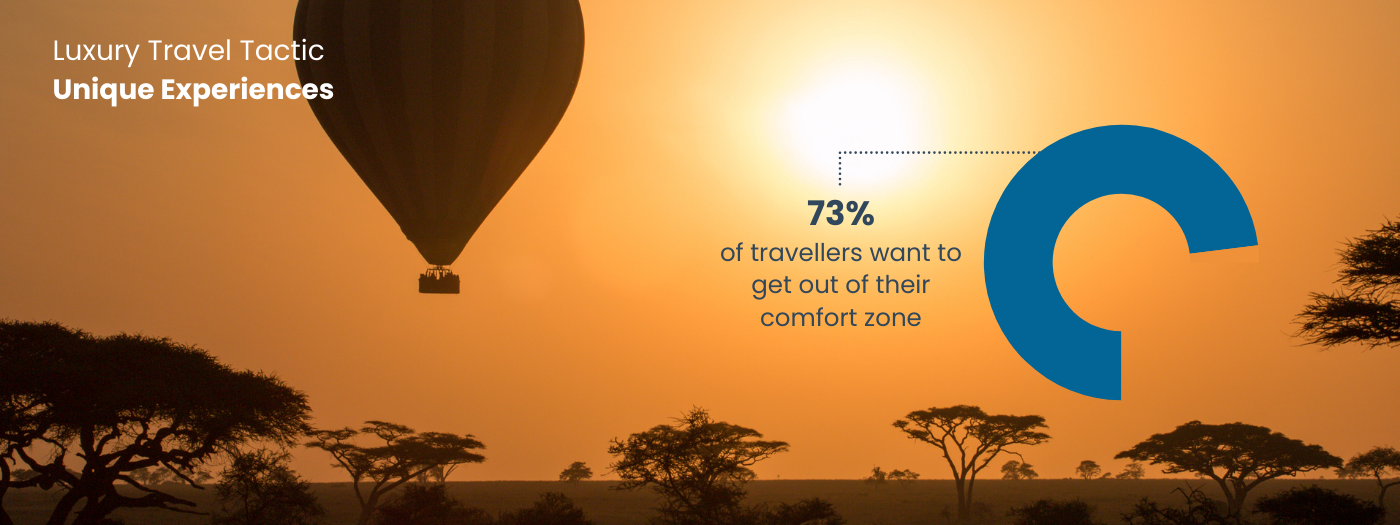
In practice:
Crafting tailored packages that centre around activities and experiences can be a compelling draw card for these discerning luxury travellers seeking unique adventures.
Even if your property doesn't host these activities directly, establishing partnerships with local providers can yield mutually beneficial arrangements. Furthermore, ensuring that your website features a curated list of nearby activities and experiences, along with showcasing them creatively in guest rooms, can elevate the overall guest experience.
Equipping your staff with thorough knowledge of the local area and its offerings will also contribute to making guests feel well-cared-for and their needs catered to.
Find out more about the “Barefoot Luxury” travel niche
With millennial travellers prioritising discovery and adventure, it's evident that they crave immersive experiences and authentic cultural encounters. Rather than opting for traditional luxury resorts, Millennials are drawn to unconventional experiences such as staying at a Berber camp in Morocco, dog sledging in Norway, or embarking on a helicopter ride over Victoria Falls.
“Experiential, or immersive, tourism typically attracts travellers seeking in-depth physical enrichment, emotional fulfilment, spiritual awareness, intellectual nourishment, or a combination of these.” – Future of Luxury Travel
Hoteliers can also strive to create an experience for potential guests online, using creative content and images to tell a story that allows potential guests to immerse themselves in the experience while they are still in the early stages of planning their travel.
Creating immersive experiences doesn't necessarily have to see the guest even leave the hotel. You can think of creative and culturally relevant fine dining experiences and sampling locally made spirits or wines. In addition, you can include novel and locally sourced amenities, such as artisanal soaps and naturally occurring flowers in the rooms.
With the rise in social media popularity and online travel influencers , the industry has seen a rise in guests looking for photographic moments to share online. This coupled with the idea of aspirational living means that many travellers are looking to go to places they've seen the rich and famous travel to, or just to one-up their social media friend circle.
According to a report written by The Olinger Group based on a survey of over 1500+ ‘luxury travellers’, 77% of them admitted to selecting “vacation destination based primarily on social media.”
They are also hugely impacted by online traveller reviews with 85% of the participants agreeing that they have read online reviews from review sites before booking their luxury trip.
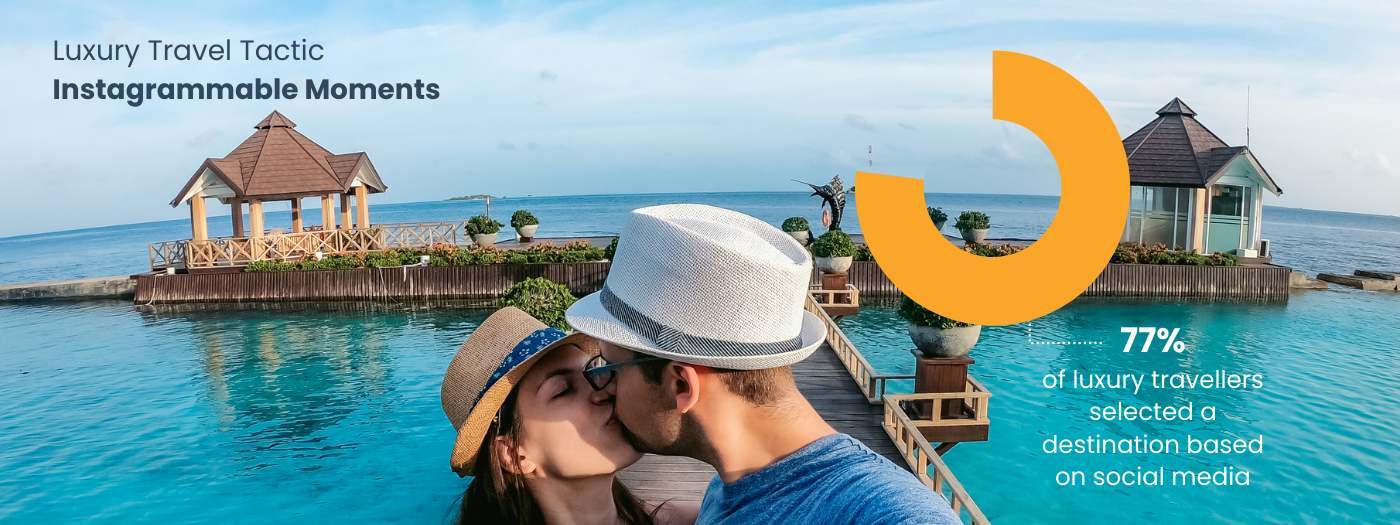
Making sure your hotel is ‘Instagrammable’ at all times can be a tall ask, but you can start to look at consolidated review data and learn what your guests love most about your property and work to highlight those areas even more.
“With social media an increasingly important channel for communicating guest preferences and recommendations, hoteliers would do well to focus on features that their guests are speaking most about – enhancing these features, without sacrificing other parts of the guest experience which lead to overall guest satisfaction and loyalty.” – Jonathan Barouch, Local Measure Founder and CEO
You can think about creating set ‘photographic locations’ for your guests, this way you start to control the narrative as to which areas of your hotel are photographed frequently. For the guest, it also takes out the mental effort to decide where to take their photos, and can instead just concentrate on enjoying themselves.
Curating these photo-worthy scenes also creates a trend, and potential guests who have seen friends and family or even influencers photographed in a particular location will book their trips around capturing those trending shots. Giving guests novel or creative welcome packages, creative cuisine or unique room decor are just a few examples of how you can help inspire guests to snap pictures in your hotel.
You can use your hotel's social media to market your hotel to potential guests, bringing in the idea of FOMO (Fear Of Missing Out) marketing . Think of Instagram as an image magazine that people browse through frequently – tell them stories to captivate their interest. Share stories about your staff, guests, and locals, and let your guests feel connected to and invested in your property and your location before they have even booked with you.
Here are some practical tips for getting your hotel Instagram-worthy
Offer Hyperpersonalisation
The luxury traveller expects individual attention privacy and exclusivity. Now more than ever luxury travellers want to feel that they are the only ones around. Think private yachts, private islands, custom tours and private excursions. Often this starts with travel advisors who are there to make guests’ trips completely tailored and one-of-a-kind.
“One of the simplest definitions of luxury goes like this: ‘Of course I can do it myself. I don’t want to.’ Travelers want to find somebody that really knows what they’re doing, has great connections, saves time, and has their back.” – Matthew Upchurch, chairman, Virtuoso
Having this ultra-personalisation even before you have embarked on your trip can set the stage for the holiday. Once the luxury traveller has decided on where to go it is important that the accommodation, excursions and added extras all exude the same level of exclusivity.
Starwood Hotels, for example, assigns personal assistants to guests who stay with them for 100 nights a year or more, and guests at The Portrait Roma hotel in Rome are invited to make use of their “lifestyle team”, who are on hand to personalise each guest’s stay and help them to explore Rome. Don’t think you need to offer a personal assistant to achieve a personalised experience, however; proving personalisation is becoming easier and easier with the right technology.
In practice:
Personalisation can and should start long before a guest arrives at your hotel, and it can begin before a traveller has even decided to book with you with targeted advertising and dynamic website content, websites that adapt to the client's language and show them content based on their location or even search history.
Once you have received a booking, you should send guests a pre-stay questionnaire to ask them the questions you need to make their stays memorable. Not only can you ask them the basics (do they have any food allergies or physical special needs), but you can also ask whether they would prefer a mountain or a pool view, which floor they would like to stay on, and which brand of tea you should leave in their rooms.
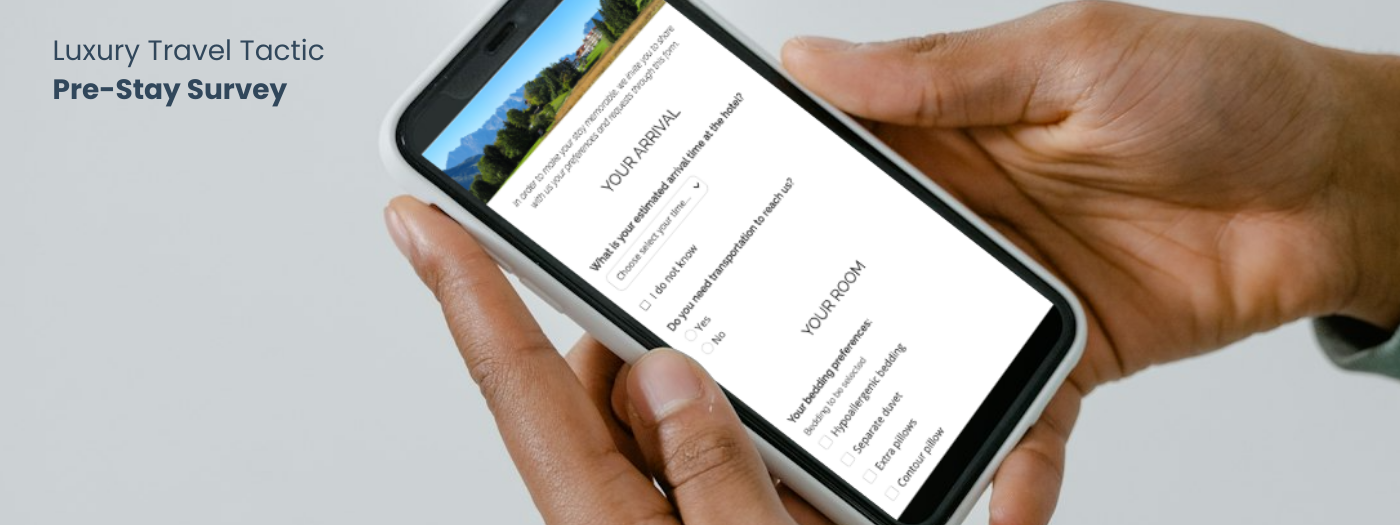
Getting to know key details about your guests before they arrive gives you the opportunity to make them feel even more valued when they check in and discover everything they need is already prepared. Again this can be further enhanced by offering clients the ability to customise their in-room experience through mobile-controlled in-room technology via the use of hotel apps and in-room tablets, think of the guest being able to remotely adjust the temperature of their room before they have even stepped foot inside.
Read about five pre-stay communication techniques to help improve your guest experience
A post-stay questionnaire should be a staple in any establishment, but this questionnaire needn’t just be used to improve your offerings and guest experience – information collected in your post-stay questionnaire can be added to a guest's profile so that, as he or she stays with you more frequently, you can get a fuller picture of their likes and dislikes and make their holidays more specialised and memorable, and you can make your marketing correspondence with them more relevant to their interests.
Whether targeting Baby Boomers, Millennials or any other luxury travel demographic, the key lies in offering unique, authentic, and hyper-personalised experiences that resonate with the luxury traveller's desire for exploration, authenticity, and exclusivity. Look at what your property or location has that is unique and tell your story to those potential high-end travellers, let them know what they can do, the images they can capture and how a trip to your hotel can enrich their lives.
Related Articles

GuestRevu takes on the World (Travel Awards)
The World Travel Awards have been recognising excellence in the travel, tourism and hospitality industries for the past 24 years. This year, GuestRevu has been nominated...
Trend digest: Emerging market segments
New generations are coming of age, others are entering retirement, people’s opinions on what makes for a good work-life balance, and what a “good life” and “health”...
Read the complete Guide to TripAdvisor
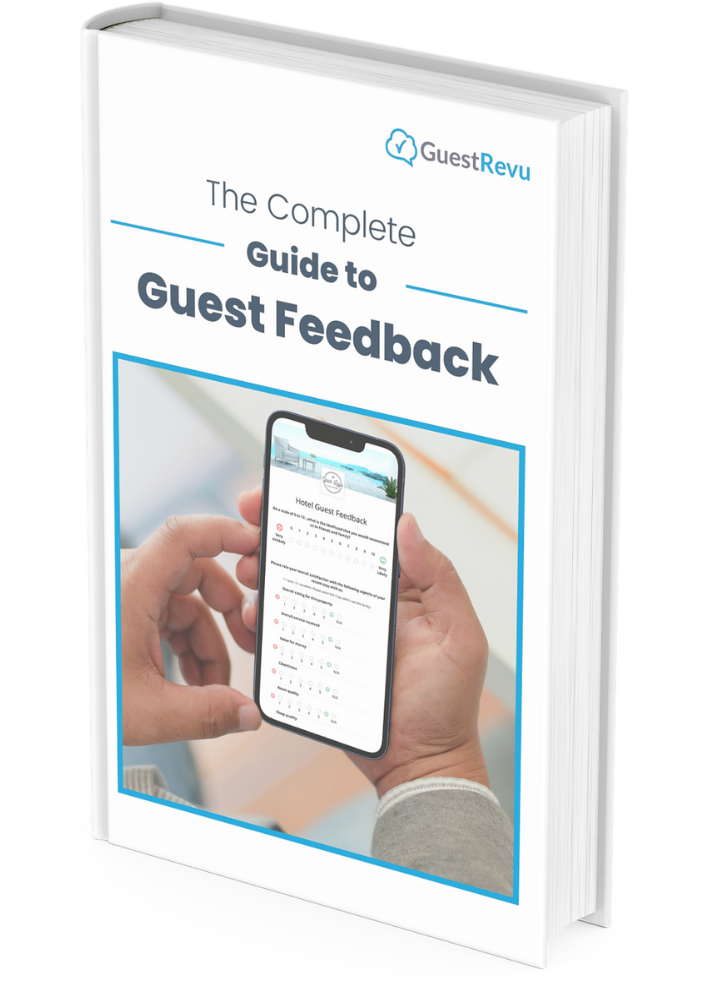
Read the complete Guide to Guest Feedback
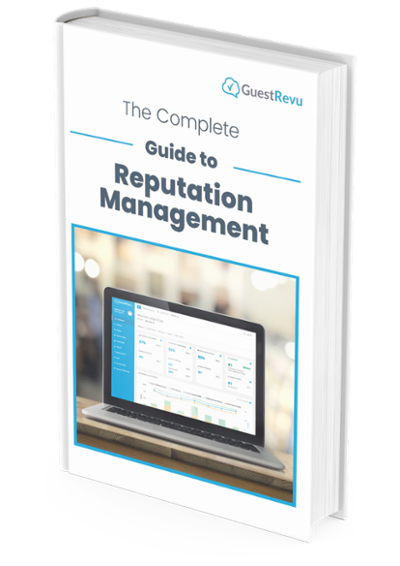
Read the complete Guide to Online Reputation Management
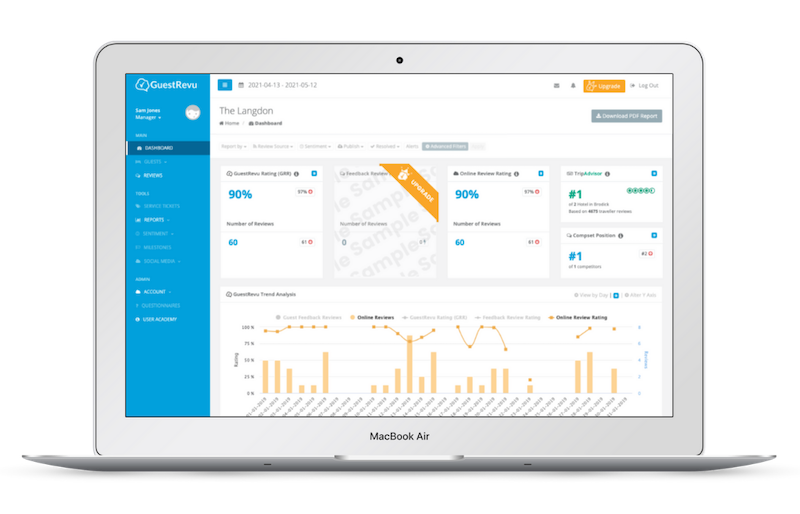
Get it free forever GuestRevu LITE
- How your TripAdvisor ranking is calculated (and how to improve it)
- The Rules of Online Reviews: tips for hoteliers
- How to respond to Tripadvisor reviews (with real-life examples)
- How TripAdvisor keeps fake reviews in check
- Review collection with TripAdvisor’s partners
- 5 Tips To Get More Hotel Reviews
- How top hotels get great guest feedback
- 3 Keys to excellent housekeeping
- Understanding guest experience with GuestRevu
- How to use your hotel’s reviews to successfully package your offerings
- Four factors to consider when updating your hotel’s compset
- Manage negative guest reviews with the 4 Rs
- Why you should never block a bad review (and what to do instead)
- 10 different types of tourists your hotel could cater to
- How to transform your hotel's marketing with storytelling
- More than commission: the 6 hidden costs of OTA bookings
- A writer's guide to effective website copy for hotels
Recent Blogs
Guestrevu on the go: first quarter pit stop, future-proofing hospitality: stevie reffin on tech integration and guest ..., guestrevu strengthens industry commitment by partnering with hospa and ....
- Deutschland
- Asia, Australia & New Zealand
- Europe, Middle East & Africa
- United States & Canada
- Latinoamérica
The psychology of luxury travel: The key to attracting affluent customers
In his role as founder of digital marketing agency Jadewolf, David Nickel, helps luxury travel brands generate qualified leads and direct bookings. His secret: A scalable luxury persona.
When a legacy brand with half a century of history looks to improve its digital marketing, it may be tempting to think success is as simple as running a few online ads. For safari specialists, Ker & Downey Africa, it was not as their unique capability to create and host bespoke, luxury safaris was unclear from their marketing.
Set packages for a specific amount of people over a set number of days was the company’s original offering to prospective customers. This was coupled with incongruent language like “best price guaranteed” and “price match”.
The average consumer seeks out the best deal possible. The premium consumer is willing to pay a little bit more for extra value — but there is a limit where higher prices result in diminishing returns. Luxury is about a personalised one-of-a-kind experience where monetary value is priceless.
So when price and value are no object, what do marketers have left to “sell”? It’s all about inspiration.
Like with any demographic, luxury shoppers require a dedicated approach to drive the consumer from consideration to purchase.
Luxury purchases are rooted in emotion. For some, it’s about having time to spend with their loved ones. For others, it’s about pursuing a lifelong passion. Two travel companies may have the same offering, but the one that can make the luxury consumer feel something beyond the offer is likely to win the sale.
The way to go about this is to apply the luxury consumer persona to everything they do. Like with any demographic, luxury shoppers require a dedicated approach to drive the consumer from consideration to purchase . A good place to start is to get a solid understanding of the customer from key decision-makers within the brand. Work with sales, marketing, and management teams to develop the brand’s unique luxury persona. This persona includes a number of things:
- Demographics: age, place of residence, gender, family status, net worth, source of income
- Media consumption preferences: typically used devices, apps, social media networks, sources of news and inspiration
- Psychographics: emotional motivators and blockers
- Nuances: cultural and traditional identifiers
The data for these personas is created with a combination of client first-party data , our own agency’s data, and market research. Once you have a persona set up for a particular market, it’s time to scale.
For Ker & Downey Africa, the first market of interest was the U.S. The first step towards reaching luxury consumers in this market was eliminating all of the budget tier packages the company previously had on offer. If there are no budget tier options to choose from, it signals to luxury consumers that this may be the best place for them to find that one-of-a-kind experience.
Next, we sharpened the campaign’s geographic reach from simply the U.S. in general to the affluent area codes in states like California, Texas, New York, and Florida, for example. Now that we had a good sense of who we wanted to reach and ensured that we had the right offering for them, it was time to move on to communicating to them in a language they understand.
We turned our attention to Ker & Downey Africa’s existing Search campaigns. Based on our persona, we identified keywords that were most congruent with the luxury offering and enhanced those. For example, we changed their ad copy to include mentions of things like “bespoke, tailor-made experiences”, “50 years of boots on the ground experience in Africa”, and “passionate luxury safari experts” to communicate the right values.
Incongruent terms like “price guarantee”, “best priced luxury safari”, “cheapest luxury safari”, and the like were added as negative keywords to the campaign to ensure that we were reaching our luxury persona alone.
Additional optimisations included adding affinity audiences like luxury specific customers, adding income parameters (available in the U.S.), and excluding bargain shoppers.
The optimisations worked. Sales increased from an average of 30 low to medium quality leads — a mix of bargain, premium, and some luxury shoppers — before the campaign to over 100 highly qualified luxury travel leads a month.
As described in the intro, the success of this campaign comes down to the synergy between client and agency teams. Ker & Downey Africa CEO, Jeff Squire explains: “The collaboration between our sales team and Jadewolf clearly demonstrates that it is possible to build a boutique African safari business online – something that we doubted could be achieved before the engagement.”
“The key elements of success from our perspective are the focus and alignment that David and team brought to the entire marketing and sales function, and the transparent and close working relationship developed with our in-house management team,” Squire continues.
With strong collaboration and a clear luxury consumer persona in place, the scalability is endless. Even when you look to reach customers in regions where income targeting isn’t possible, the same persona-based messaging works with tweaks to reflect nuances like culture and background.
Looking to the future, Ker & Downey Africa has its sights set on scaling the luxury personas to markets in Europe. A large part of the company’s 50-year history is rooted in safari travels for the British Royal Family. Tapping into this legacy will be key to localising our luxury persona for some markets in Europe.
Others are viewing
Marketers who view this are also viewing
Searching for value: Plan your 2024 with these defining African marketing stories
What ai can and can’t do — and what that means for marketers, grab the attention of gen zs in mena by getting your video ads to do these 3 things, the ai handbook: resources and tools to help marketers get started, accessibility best practices for more inclusive digital marketing, women’s empowerment: how south africa’s financial industry is banking on women, david nickel, others are viewing looking for something else, complete login.
To explore this content and receive communications from Google, please sign in with an existing Google account.
Luxe Digital
Conscious, elevated living.
- Men's style
- Women's style
- Stricking superlatives
- Advertising
JOIN OUR COMMUNITY
Receive our finest finds, exclusive deals, and luxury news to stay in the know.

The Digital Journey Of The Affluent Luxury Traveller
There are four critical moments when luxury travel brands need to engage their affluent travellers online.
by Florine Eppe Beauloye Updated on November 23, 2022
At Luxe Digital, we independently research, review, and recommend products we love and that we think you will love, too. Learn more about how we curate the best products for you .
The Opportunity
- Most affluent travelers research, plan, and book their trips online. The online customer journey offers luxury travel brands new opportunities to engage their consumers across devices and channels.
- Digital inspires affluent tourists to explore new locations and experience different types of vacations.
- The demand from affluent Millennial travelers for personalized and authentic experiences creates new venues of growth for the high-end luxury travel industry.
The Problem
- The once linear travel customer journey is being replaced by intent-driven micro-moments, resulting in a complex booking process.
- Affluent travelers expect more out of their trips: they want stories of unique experiences and envy-inducing sharable photos of their trip. Real-time interactions such as location check-ins and status updates require luxury travel brands to leverage social media channels in innovative new ways.
- Millennial travelers prefer to plan and book their vacations online, increasingly using their mobile devices. They want personalized content that is relevant to their preferences, but luxury travel brands are struggling to keep up.
The Solution
- To reach and influence travelers, luxury travel brands must take an omnichannel approach to customer experience and provide relevant content throughout the travel journey online.
- Social media and user-generated content are an essential part of marketing to the modern affluent travelers. By leveraging the millions of authentic travel photos and stories that people post online every day, luxury travel brands can create engaging digital experiences that move travelers along the path to purchase.
We’ve previously explored in detail the digital transformation of the luxury retail industry . Today, we are looking at another industry that is being heavily reshaped by digital: luxury travel and hospitality.
This report explores how digital and new technologies are redefining the travel and hospitality industry across the entire travel journey. Social media and mobile, in particular, are profoundly influencing the purchase decisions of modern affluent travelers. High-end travel brands and luxury hotels need to understand how these new developments are shaping their consumers’ decision process.
Taking inspiration from a study by Google on consumers’ online behaviors in the travel and hospitality industry, we will organize this report into four essential phases. [1] It is critical for luxury travel brands to be present throughout each of these four phases if they want to positively influence their customers’ decisions .
There are four essential travel phases that matter in the customer journey:
- Dreaming phase: I-want-to-get-away moments
- Planning phase: Time-to-make-a-plan moments
- Booking phase: Let’s-book-it moments
- Experiencing and sharing phase: Can’t-wait-to-explore moments
We will explore in greater detail each of these four critical phases to discover how luxury travel and hospitality brands can influence their customers’ decisions. We will then take a closer look at the growing importance of mobile experiences throughout the travel experience journey before concluding this report with specific recommendations for luxury brands.
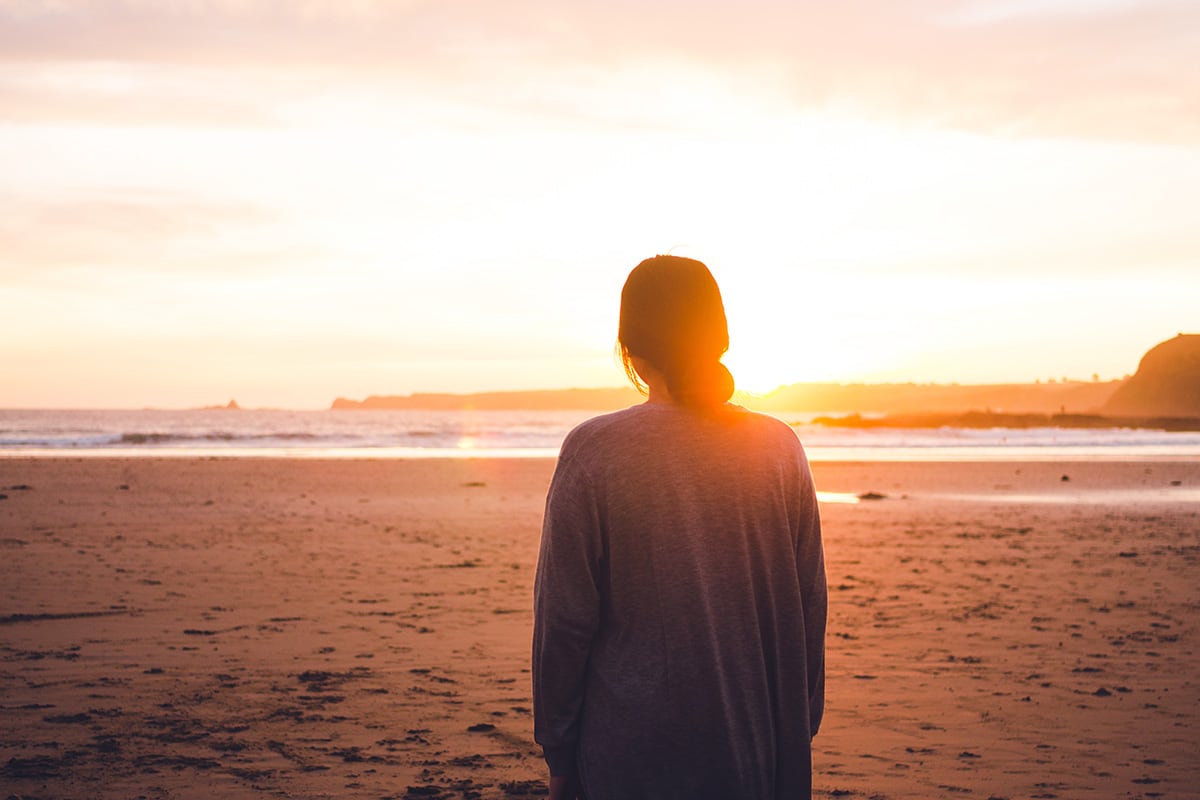
1. Dreaming phase: Digital inspires affluent travelers to explore new destinations and discover new travel experiences
If you’ve ever spent hours scrolling through the feeds of your favorite travel influencers on Instagram or other online platforms, you’re not alone. There are over 287 million posts on Instagram alone using the hashtag #travel, which underlines the popularity of the topic on social media.
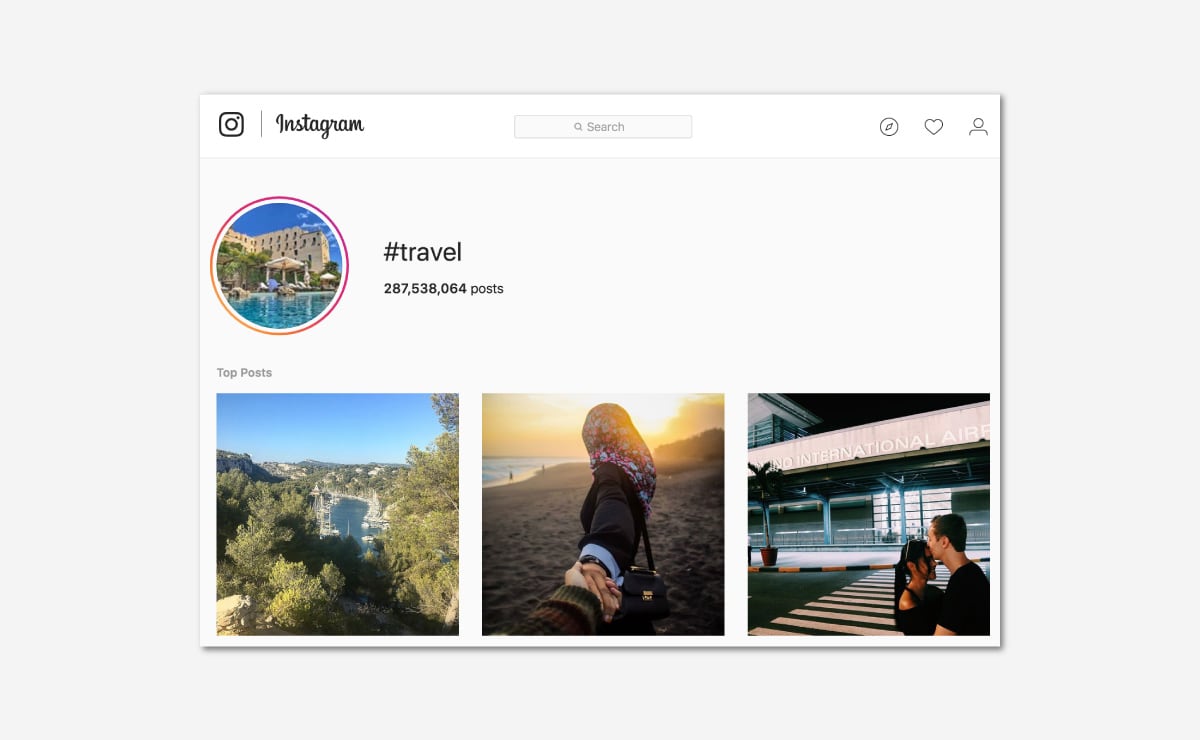
The Internet, online visual content, and social media, in particular, provide a seemingly infinite source of picture-perfect snaps of the world’s most desirable travel hotspots and are influencing how people dream about their next holiday destination.
The experience that a travel brand can provide online, before travelers even decide where they will be going, is thus crucial.
Social media has become an essential resource for travel seekers. As a result, high-end travel brands and luxury hotels have increased their social media budgets, both in the form of content marketing and paid advertising.
The sheer amount of travel-related content that is now available to holiday seekers online is staggering. The challenge for marketers is, therefore, to break through the clutter and engage with their most relevant target audience.
Social content influences consumers’ travel decisions more than traditional advertising. During the initial dreaming phase of the journey, holiday seekers turn to social media to find inspiration for their next travel destinations and compare options from a variety of online sources.
Over 40% of travellers say they bounce back and forth between dreaming about and planning their next trip—zooming in on the details for one destination and then zooming out to reconsider all the options again. Think with Google
On average, 43 days will pass between the decision to travel and the decision on where to go, according to the head of travel at Facebook, Christine Warner. These 43 days will be spent scrolling through social media feeds and reading recommendations from friends and trusted influencers. Travel website Expedia found indeed that over half of travelers are open to help and ideas on destinations. This is particularly true for Chinese travelers, of which 82% will seek recommendations from other people online. They are followed closely behind by American travelers (72%).
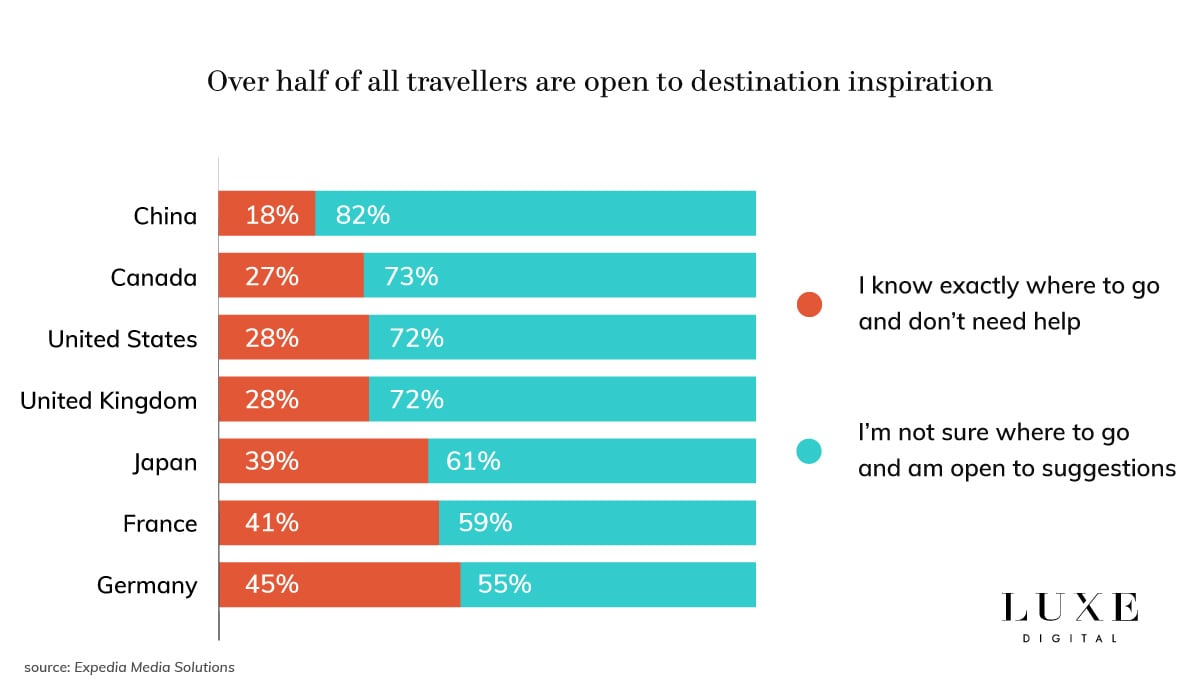
Furthermore, a study by ComScore found that 73% of first travel searches worldwide had no mention of a brand or destination. [2] Travelers are thus actively looking online for ideas and suggestions on where to go for their vacations.
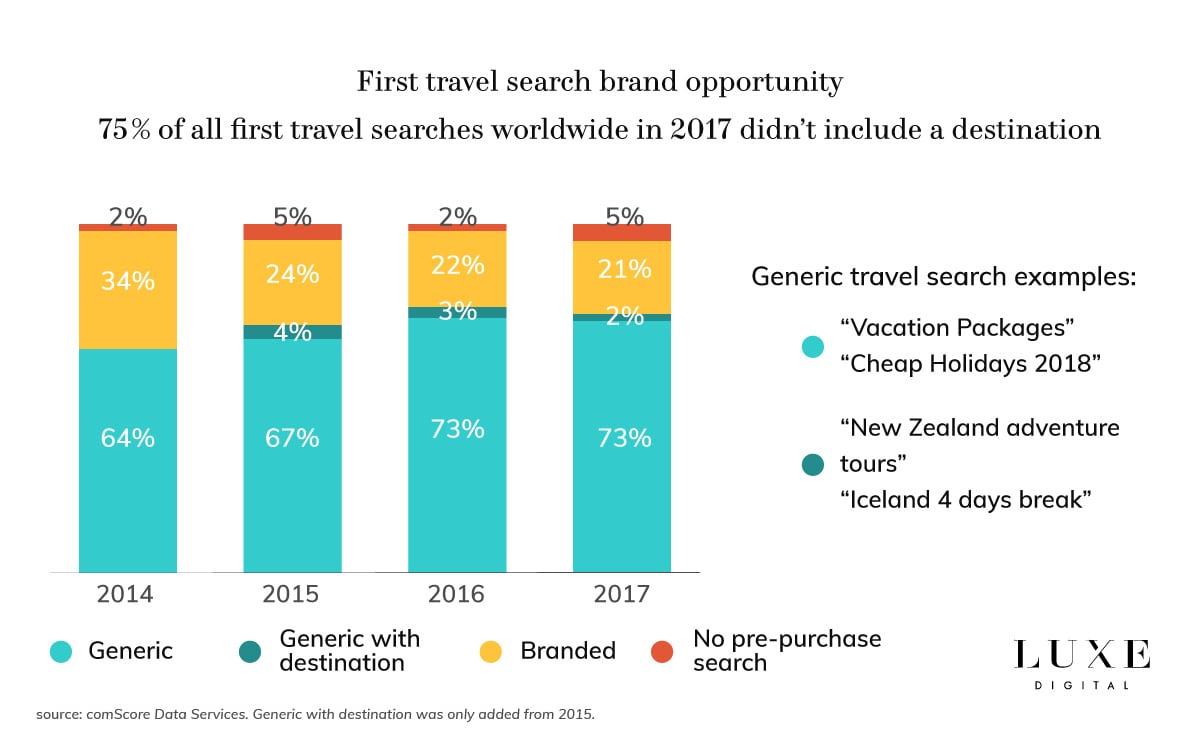
That indecision presents a significant opportunity for luxury travel and hospitality brands to inspire affluent travelers with quality destination content . At this early stage in the travel journey, travel seekers want brands to provide content to help narrow down their choices.
Instagram is one of the most popular places to fuel your wanderlust, especially since “Instagrammability” is now an important factor in choosing a holiday destination. A study from Hotels.com revealed a new trend of ‘travel bragging’ on social media among Millennials . [3] One in eight Millennials admits to picking their next destination and hotel based on how Instagrammable it is.
Marina Bay Sands in Singapore is the world’s most Instagrammed hotel
Instagram’s 2017 Year In Review revealed the most popular hotels in the world and the most shared moments across the #travel world.
Singapore’s iconic Marina Bay Sands (MBS) topped the list for the world’s most Instagrammed hotel; a recognition that they prominently communicate on their Instagram account.
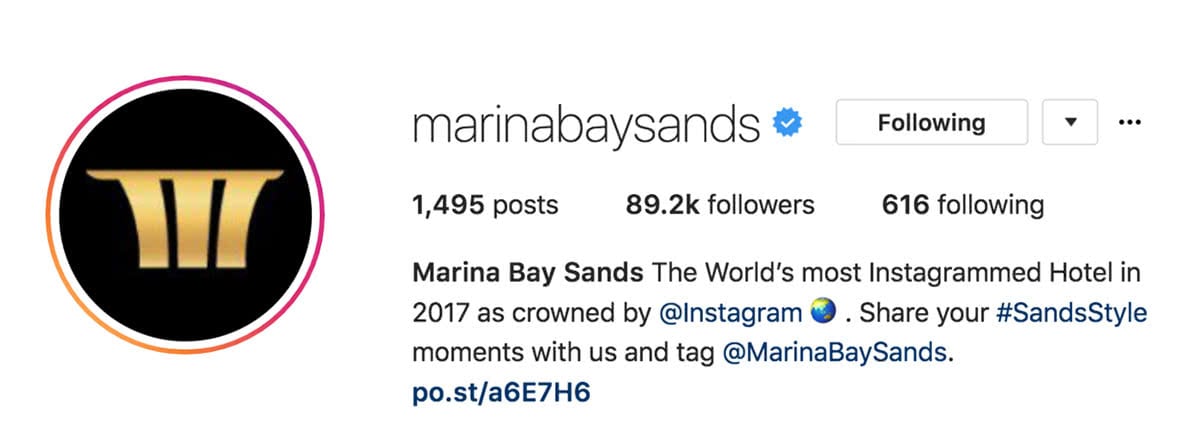
One of the definitive icons of Singapore’s skyline, Marina Bay Sands is home to a breathtaking infinity pool at 57 storeys high overlooking Singapore’s Central Business District which makes for the perfect backdrop for social media posts — #nofilter needed. Over a million photos have been posted to Instagram from the SkyPark by guests, celebrities, media and influencers alike.
A selfie from the MBS’s poolside is a “bucket list” item for affluent Chinese visitors to Singapore. Read our report on how luxury brands attract the affluent Chinese tourists to understand the travel habits of these high spenders.

The top 10 most Instagrammed hotels in the world:
- Marina Bay Sands (Singapore)
- Bellagio (Las Vegas, USA)
- The Venetian (Las Vegas, USA)
- Atlantis The Palm (Dubai, UAE)
- MGM Grand (Las Vegas, USA)
- The Cosmopolitan (Las Vegas, USA)
- Wynn (Las Vegas, USA)
- Caesars Palace (Las Vegas, USA)
- Fontainebleau (Miami Beach, USA)
- Paris Las Vegas Hotel & Casino (Las Vegas, USA)
2. Planning phase: Digital eases travel planning, and mobile boosts planning activities on the go
Beyond providing travel inspiration, online resources play a strategic role in trip planning, most notably with younger affluent generations. This trend hints at the increased role social media will play as a travel planning tool for wealthy Generation Z travelers.
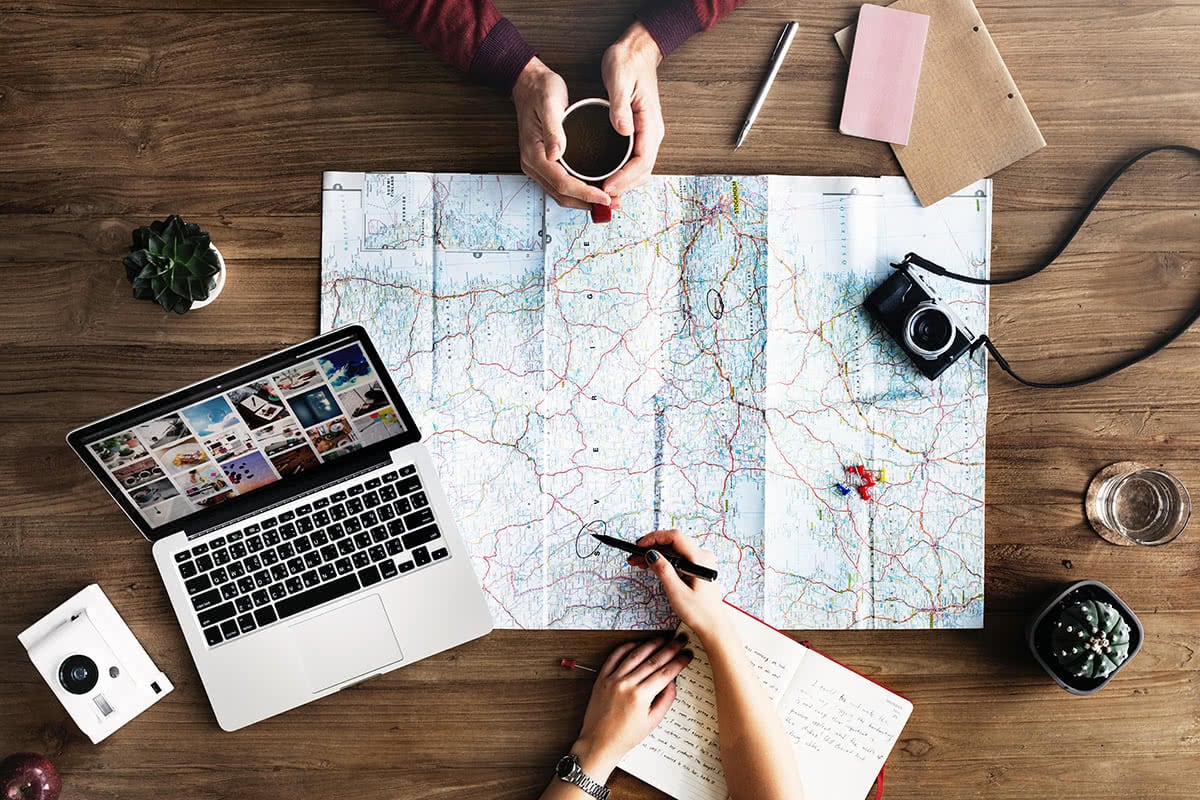
During the planning phase, travel planners compare pricing and read reviews and recommendations to decide where to stay and which activities to do. They will often seek validation of their choices across various social media platforms and online communities.
Research conducted by Nielsen for Google found that travelers spent an average of 53 days visiting 28 different websites to plan their vacations. [4] More than 50% of them will heavily use social media during that travel planning phase.
Interestingly, digital has also led to travelers increasingly making last-minute plans from their mobile phones. Travel-related searches for “tonight” and “today” among hotel and air queries have grown drastically on mobile between 2014 and 2017. [5]
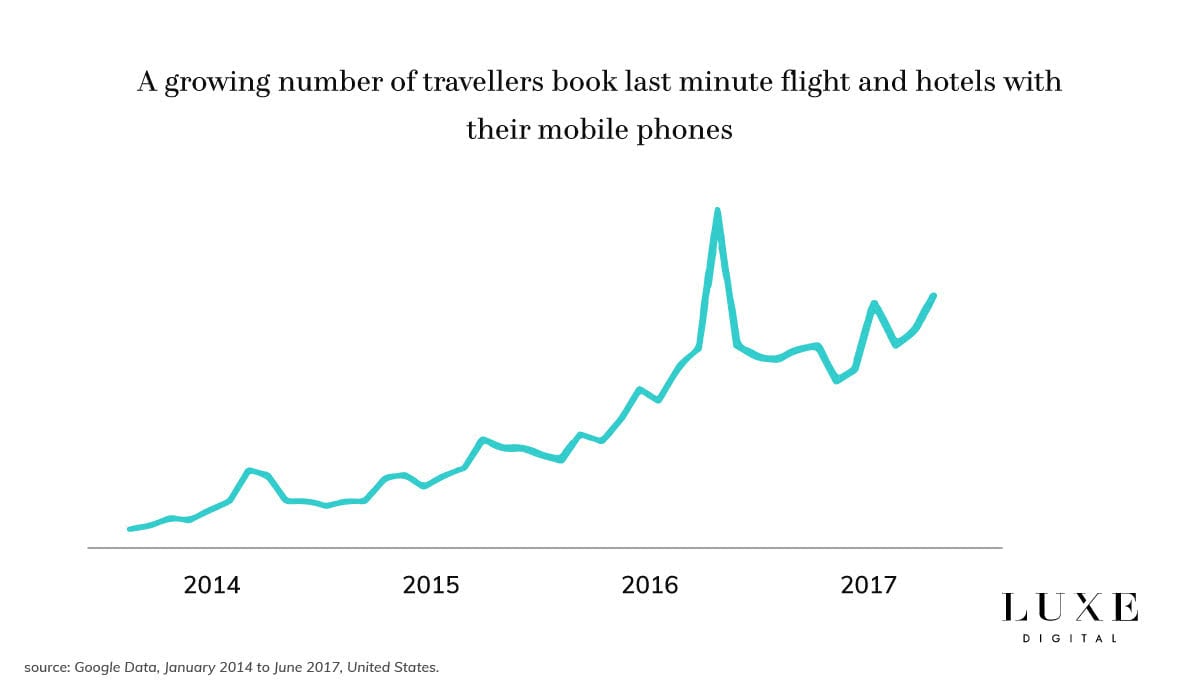
In the planning phase, OTAs and search engines are the most used resources, with 51% of all global travelers using them regularly to find travel information and compare prices. Hotels and airlines websites, on the other hand, are only used by 30% of travelers planning their trips, according to Expedia Media Solutions.
Travel review sites are also key resources used for planning trips. According to Huffington Post, over 95% of leisure travelers read at least seven reviews before booking their holidays. [6]
It is important to note that many travel review sites contain user-generated content (UGC), often seen as more authentic by readers. It is thus essential for high-end travel companies and luxury brands to promote positive UGC and proactively manage negative reviews.
Bringing social media and online UGC to the physical world
In October 2017, Scotland’s National Tourism Board brought social media and UGC to the offline world with the launch of the #ScotSpirit Instagram Travel Agency.
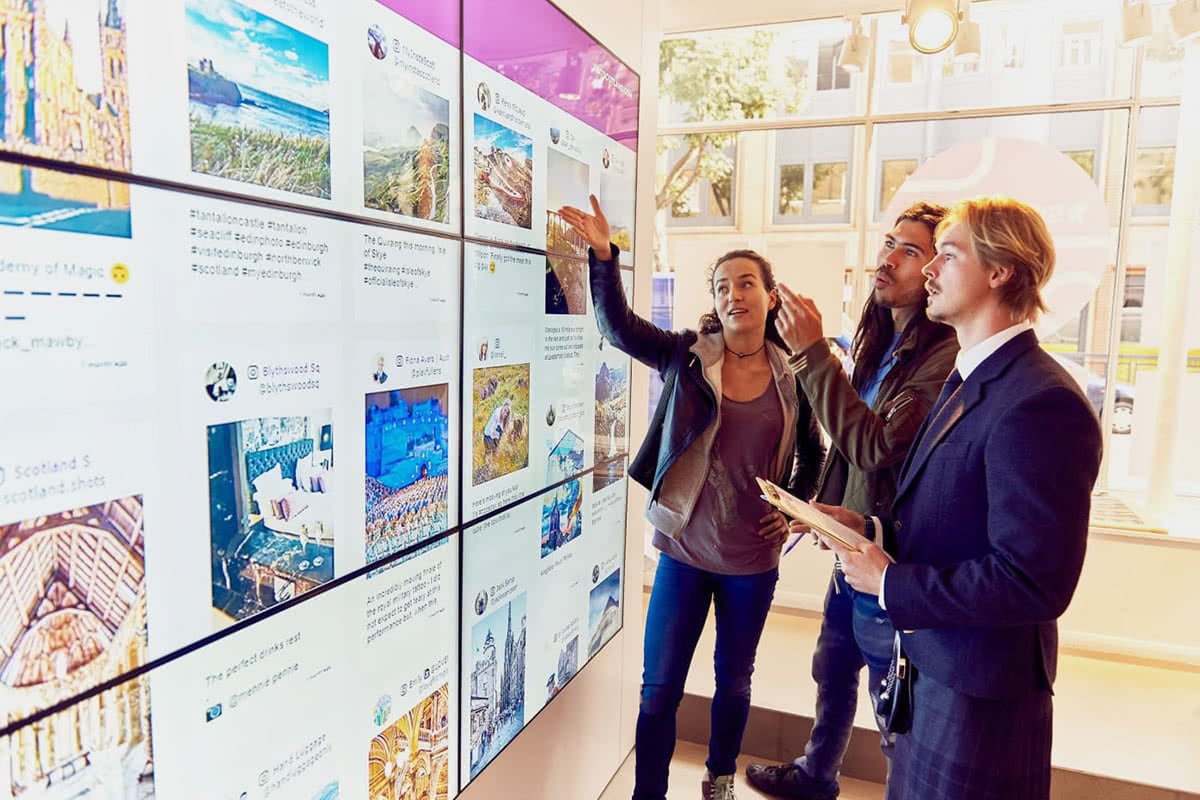
The temporary, pop-up travel agency displayed floor-to-ceiling digital screens showcasing real travelers’ Instagram photos from across Scotland to inspire potential travelers. A travel agent then uses the selected images to curate the perfect Scottish holiday itinerary.
3. Booking phase: Travellers expect a seamless and frictionless booking process across devices
Affluent travelers expect to be able to instantly book their flights and hotels on the device that they want at the very moment they need it. As a result, a consistent user experience across all devices is essential for luxury travel booking.
A Google study found that price, but also the search functionality and easiness of the booking process are key features that will impact the booking of a travel experience. When it comes to mobile bookings in particular, travelers expect simple checkouts with a single-screen experience, large text entry boxes, and a secure online payment gateway.

While desktop remains the primary booking platform for most travelers, 80% of the last-minute hotel bookings are now made on mobile devices. [7]
Younger generations are also driving mobile bookings. Google found that two-thirds of Millennial travelers are comfortable booking an entire trip on a smartphone, compared to only one-third of the older generation travelers. Social media is also starting to play a critical role in the booking process. In May 2018, Instagram announced new action buttons on business profiles that allow users to “book,” “get tickets,” “reserve,” or “start order”—all within the app. [8]
4. Experiencing and sharing phase: Seamless and shareable experiences are must-have amenities for affluent travelers
Mobile and social media enable luxury travel and hospitality marketers to engage with their guests in real-time and on-property in new innovative ways.
Once guests check in their flights or arrive at their destination, they would often post photos online and share travel experiences with family, friends, and followers on social media. Expedia found indeed that the average vacationer spends nine hours of a one-week-long trip browsing social media.
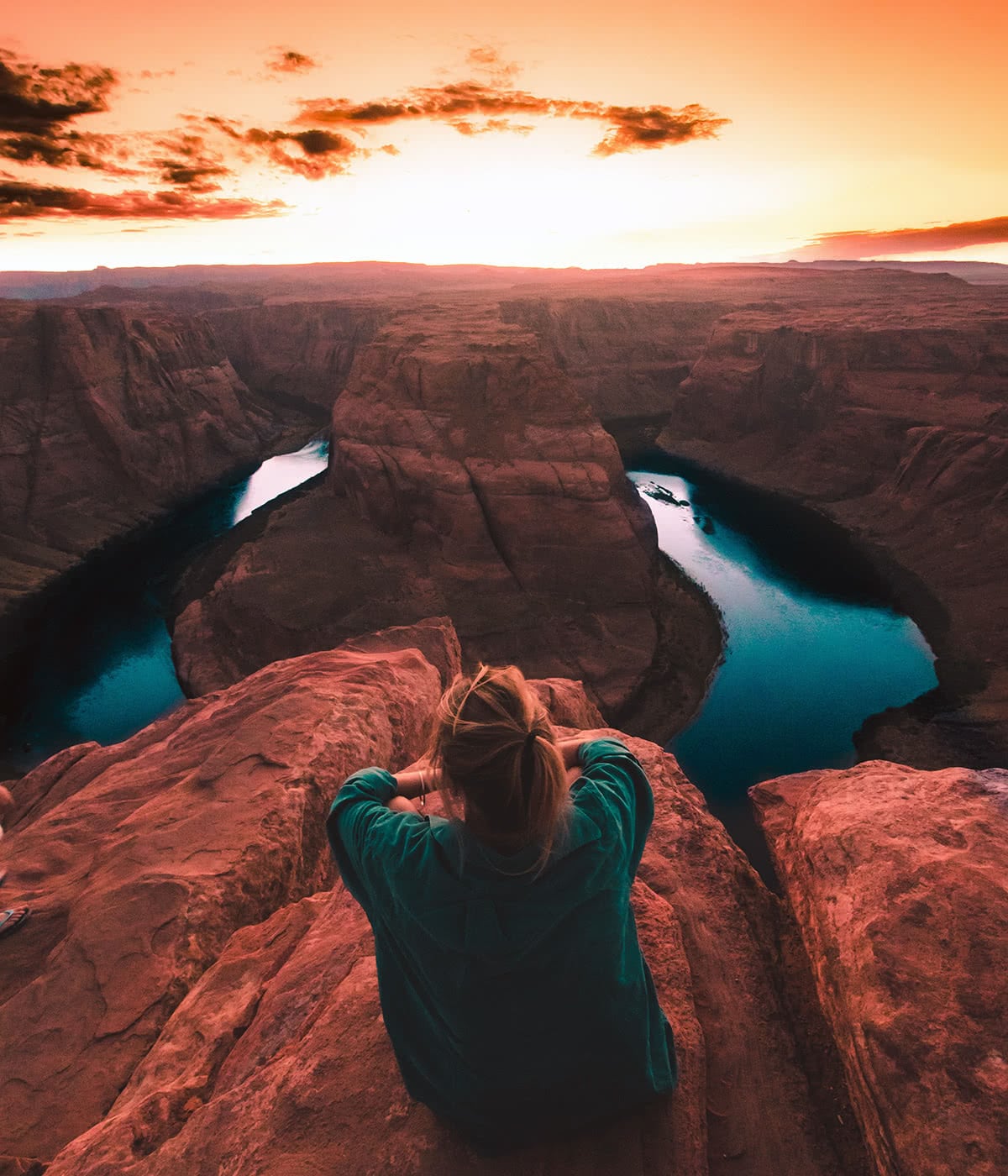
This is another critical opportunity for luxury brands to reach and interact with their affluent customers. Big data , in particular, can provide the necessary tools for marketers to engage in a meaningful and personalized way with their most valuable guests.
We need to be operating at the level of Google. Joe Leader, chief executive of the Airline Passenger Experience Association
“ For every passenger, we know every detail that serves as a marketing treasure trove of personalization, ” explained Joe Leader, chief executive of the Airline Passenger Experience Association, in a report ahead of this year’s Aviation Festival. “ We have full names, addresses, exact birthdays, seat assignments, credit cards, and everything that should make personalization easy. [9] ”
Delta Airlines, for example, is asking its flight attendants to engage in every flight with at least five passengers who are members of their SkyMiles loyalty program.
“ You want to feel valued, ” said Allison Ausband, Senior Vice-President of in-flight service to the Financial Times. [9] “ We are getting thank-you notes from customers for acknowledging them on the airplane. Whether apologizing for delays or acknowledging their [loyalty program] status, we make them feel that they are that valued customer. ”
A great example of the extra mile the Delta flight attendants are ready to go to delight their passengers took place last year when a passenger who was flying to an interview spilled a drink on himself. The airline informed their ground staff before landing and had a new clean shirt waiting for the passenger after he landed.
W Hotel: the impact of user-generated content
User-generated content (UGC) from guests isn’t just a source of travel inspiration. Luxury travel brands are now leveraging this organic and authentic social content to fuel every stage of the traveller’s path to purchase.
W Hotel Sentosa is a particularly great example of a luxury hotel that is successfully leveraging UGC. The very same day I posted about my time at W Singapore on my Instagram account, someone from their social media team proactively engaged with me, asking permission to repost my photos on their official social media accounts.
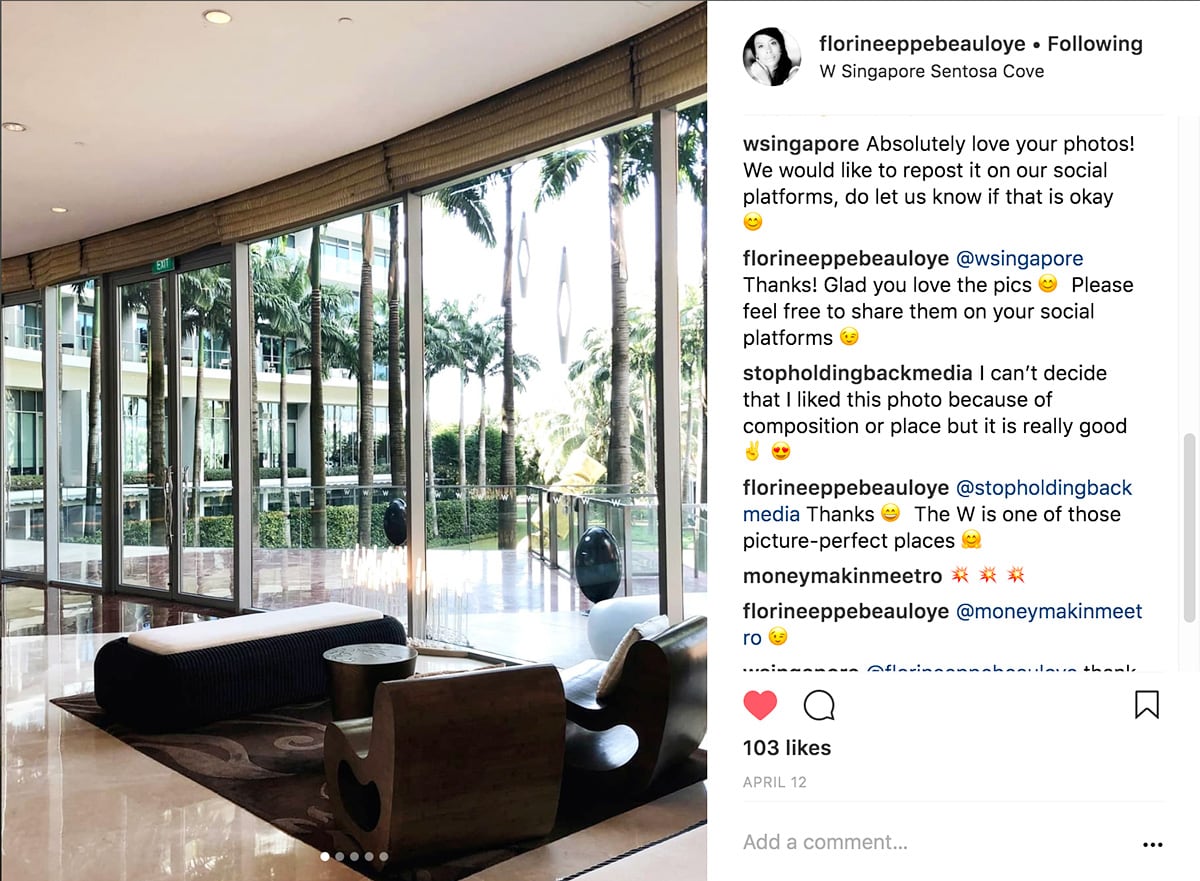
Mobile is the essential travel partner before and during a luxury travel experience
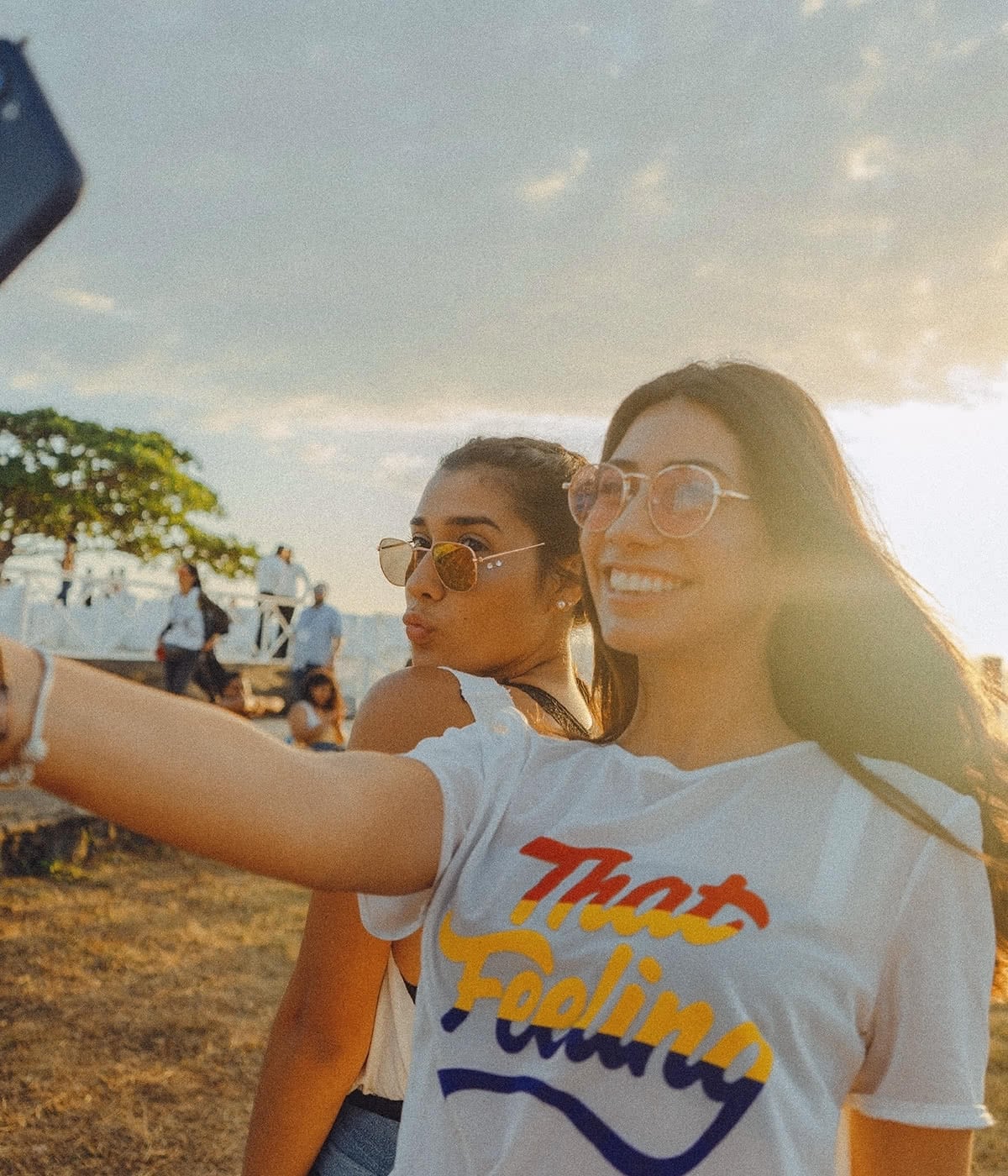
More than ever before, travelers increasingly rely on their smartphones for travel-related activities throughout the entire travel journey – younger generations even more so. In fact, Generation Z tourists are four times more likely to use a smartphone for inspiration, research, or booking travel than baby boomers, according to Expedia.
With mobile devices poised to account for 79% of all internet users in 2018 globally, [10] a mobile-first strategy is becoming a requirement for all luxury travel brands.
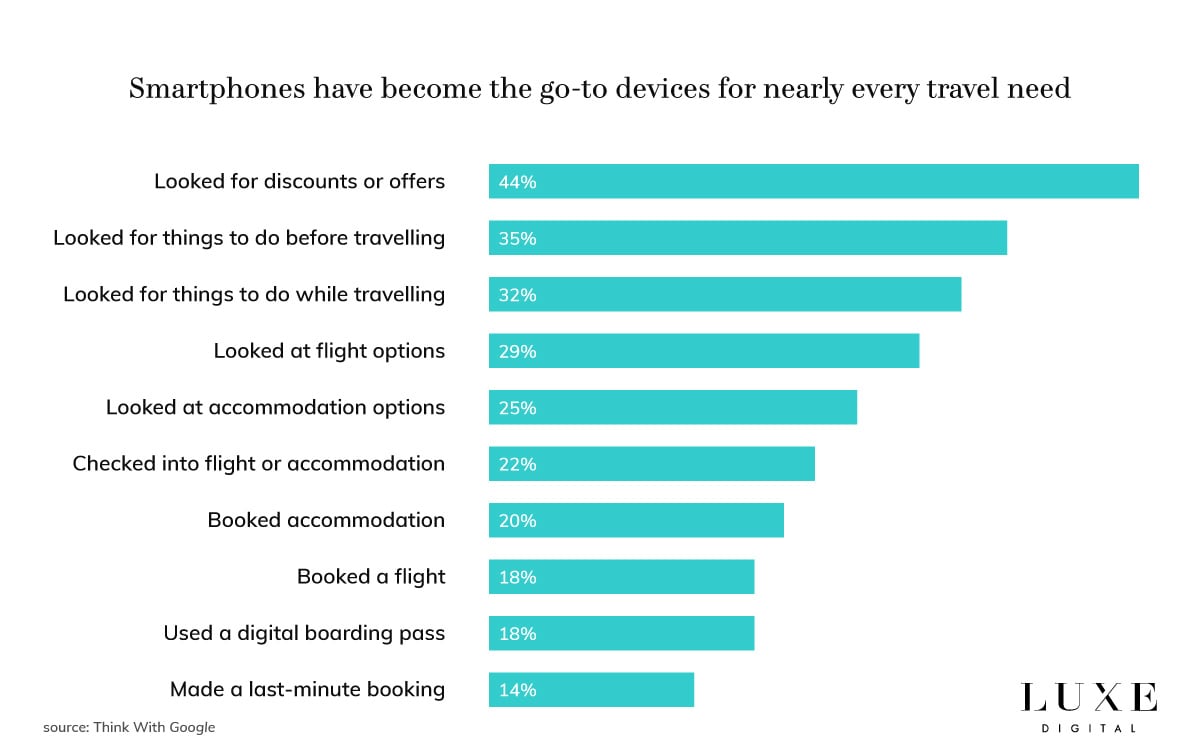
There is a significant opportunity for travel and hospitality marketers to influence travel-related decisions on mobile — by focusing their attention on mobile-friendly services, ranking in search results to answer travel queries, and being present during all the key travel micro-moments.
Before the trip: Mobile as an insightful travel guide
There are already more searches on mobile than desktop for travel categories such as family vacations and luxury travel.
Recent Google data have shown that in certain countries, half of all consumers are comfortable researching, booking, and planning an entire travel experience on a mobile device. [11]
During the trip: Mobile as an instantly responsive 24/7 travel concierge
Mobile devices give travelers increased flexibility to plan vacation activities on the go, while in destination. Mobile devices have become indispensable travel companions for modern affluent travelers, from managing itineraries to checking in and looking for what to do and where to eat.
Conrad Hotels: Instagram Butlers and picture-perfect luxury travel moments
The luxury resort The Conrad Maldives Rangali Island resort introduced in October 2017 their Instagram butlers described as “knowledgeable team members helping guests to discover the most picturesque locations”.
The dedicated Instagram Butlers bring guests on their #InstaTrail to the most Insta-worthy spots, including of course the famous (and highly photogenic) all-glass underwater restaurant Ithaa.

The Instagram Butlers also teach guests how to perfect that dream shot by offering advice such as the optimum time of day (including, obviously, the “golden hour” right after sunrise or before sunset) and the best camera angles to use.
The luxury resort also offers 1, 3, and 5-hour curated experiences through its global ‘Stay Inspired’ programme. This initiative “overhauls the way the brand trains its team members as storytellers of their destinations”.
Conrad hotels even have a Social Media Influencer Request form on their website, where digital influencers can submit their information and receive accommodation incentives.
Travelers expect seamless and instantaneous mobile experiences before, during, and after their travel. Indeed, when it comes to mobile experiences, speed matters. In fact, over 90% of travelers using mobile devices will switch to another site or app if their needs are not being met fast enough.

The travel sector has room for improvement in that regard. The average time it takes to fully load a mobile landing page for a hotel or airline is 6.7 seconds in the UK, 6 seconds in the USA, 5.6 seconds in Japan, and 4.8 seconds in Germany. With 53% of mobile users leaving a page that takes longer than three seconds to load, improving the mobile experience should be a priority for the industry.
Smartphones already allow hotel guests to unlock their rooms, share real-time vacation photos on social media or pay on the go with a mobile wallet. The ubiquity of smartphones, combined with the potential of new technology trends and innovations such as artificial intelligence, machine learning, cloud-based data, voice recognition, and more, is set to revolutionize the luxury travel industry in unprecedented ways.
This convergence into a singular mobile experience will allow luxury travel brands to move beyond reactive customer service to actually predict travelers’ needs and solve problems in real time, sometimes even before travelers know that they have an issue.
In conclusion: luxury travel brands need to go beyond the classic route
The digital journey of the affluent traveler promises many more adventures.

Predictive mobile services will gain momentum as affluent travelers increasingly expect luxury travel brands to understand their individual preferences to anticipate their travel needs and solve their problems in real-time or in advance.
For 72% of travelers with smartphones researching on mobile, their individual needs are more important than their loyalty to a specific brand. To win the hearts and minds of affluent travelers, it is thus critical for luxury travel brands to provide the most relevant information across all touchpoints at all the moments that matter:
- Identify the micro-moments for travelers that fit your business and be there to help.
- Be useful and valuable by solving each person’s needs across all travel moments.
With a majority of travelers, especially Millennials and Generation Z consumers, preferring travel experiences over material goods, the luxury travel and hospitality industry is poised to grow.
But as more travelers favor integrated travel resources and booking platforms, luxury travel brands will have to find new ways to be relevant and engage with their consumers.
Winning luxury travel brands will be the ones embracing mobile, big data, and innovative technologies to accompany affluent travelers through their entire customer journey. Off the beaten path.
- Travel Micro-Moments Guide: How to Be There and Be Useful for Travelers , Think With Google, July 2016.
- Worldwide Travel Path to Purchase 2017. Analysis Based on April – September 2017 Data Periods , comScore for TripAdvisor, April 2018.
- Hotels.com identifies new millennial Travel Brag trend: The “BRAGTAG” overtakes the humble HASHTAG as travel becomes the new social currency for millennials , Hotels.com, December 19, 2017.
- Travellers Overwhelmed as Funnel Becomes Pretzel , by Martin Kelly, Travel Trends, November 2014.
- Micro-Moments Now: Why expectations for ‘right now’ are on the rise , by Lisa Gevelber, Think With Google, August 2017.
- Digital Trends That Are Transforming the Travel Industry in 2017 , by Penny Harris, Huffington Post, March 2017.
- Travel Flash Report , Criteo, 2018.
- Making it easier to do business on Instagram , by Instagram Business team, Instagram Blog, May 2018.
- How airlines aim to use big data to boost profits , by Camilla Hodgson and Patti Waldmeir, The Financial Times, May 8 2018.
- 15 Mind-Blowing Stats About Mobile , by Giselle Abramovich, CMO.com, February 6, 2018.
- How smartphones influence the entire travel journey in the U.S. and abroad , Think With Google, February 2018.
About the author
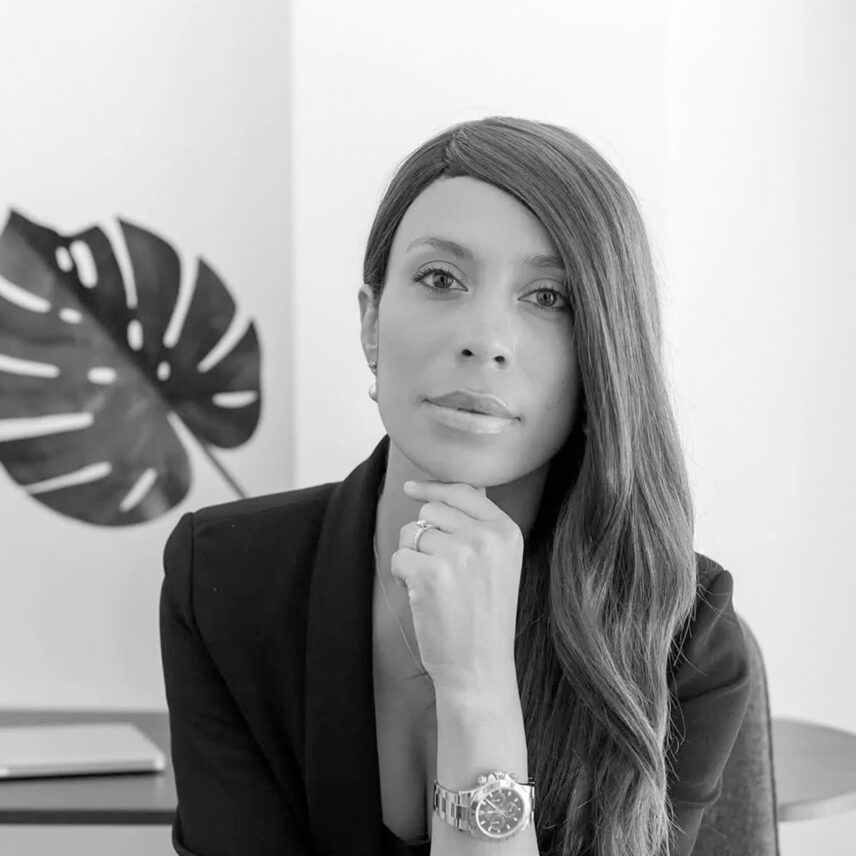
Florine Eppe Beauloye
Founder & editor in chief.
Florine Eppe is the Founder and Editor in Chief of Luxe Digital , and her achievements read like a book (she coincidentally wrote an actual book ).She is the definition of the modern-day multi-hyphenate—an award-winning digital entrepreneur, international speaker, praised author, and accomplished luxury marketer with a history of working with some of the industry’s finest names. She has appeared on stages across the world, and her insights in Forbes, The Financial Times, Harvard Business School’s academic papers, and more.
Learn more about Florine Eppe Beauloye

The Best French Car Brands: From Alpine Trails To Goddesses
A long-standing legacy.

Cuyana Easy Tote Review: Going Places Has Never Been Easier

Standing Tall: Oakywood Adjustable Desk Doesn’t Sit Still
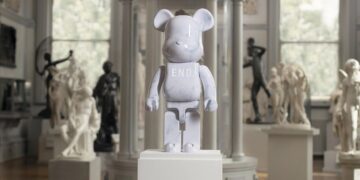
Beyond Playthings: The Most Expensive 1000% Bearbricks Ever Sold

Eberjey Gisele Pajamas Review: Classic Cocoons Of Comfort

The Most Expensive Basquiat Paintings Are Message-Infused Masterpieces

15 Rarest Cars in The World – From Alfa To Zagato

Beyond The Velvet Ropes: London’s Most Exclusive Private Members’ Clubs

Luxury Lumber: The Most Expensive Wood In The World

Decadent & Diplomatic: The Most Exclusive Private Members’ Clubs In Brussels
Proudly inspiring millions of readers like you .
Your Conscious,
Elevated Life
Starts Here.
- Striking superlatives
CleanPix Blog
The latest updates from cleanpix, creating buyer personas for the travel industry.
Thu Oct 18, 2018 in General
Buyer personas help with that. In this post we’ll examine what they are and why they’re so important. Then we’ll layout a process you can follow to create your own. Finally, we’ll leave you with a couple buyer persona examples and a few ways to use them to market your business.
Let’s get started!
The “What” and “Why” of Buyer Personas
“Know your customers” is a common phrase in marketing circles. But how? Buyer personas.
Buyer personas are fictional characters made to mirror a company’s target audience. They aren’t real, but they represent real people.
When you’ve successfully created one (or two, or three, or five!) for your business, it will help you humanize your organization’s marketing efforts and allow you to better reach your target audience .
For example, rather than creating content for “26 year olds,” you can create it for “Tim, the 26 year old entrepreneur.”
Can you see the difference? Even just this tiny bit of added detail gives you so much more clarity. And this added clarity will help you cut through the noise in an ultra competitive field like travel.
It’s much easier to relate and appeal to customers when you think of them as a single person, rather than a crowd of people.
Create the Perfect Buyer Personas for Your Company
Ready to create a buyer persona for your travel business ? The fun starts with deep research. It will definitely take a fair bit of time and elbow grease to do, but it’s not too bad when you know where to start. And the end result will be more than worth it!
The Information You Need
Let’s start with the kind of details you’ll be looking for:
Demographics
These are the “cold hard facts” about your audience. The statistical information that separates them from the rest of the population. You want to know their:
- Physical Location
- Relationship Status
- Family Size
- Spoken Language
- Household Income
- Level of Education
- Content Preference Type
- Social Media Habits
Psychographics
Now we want to dig deeper. Who is the person behind the facts we just mentioned? Humans are a lot more than statistics. Find juicy information on your ideal customers like their:
- Goals and Motivations
- Fears and Challenges
- Reasons for Traveling
- Obstacles to Travel
- Purpose for Travel (Business or Leisure)
- Favorite Travel Activities
- Expectations While Traveling
When you put all this information together, both demographic and psychographic details, you really start to see who your target audience is.
You’ll know the age bracket and location of your customers, what they can afford, and why they want to travel in the first place. You’ll understand the way they like to spend their trips and various obstacles keeping them from booking their next vacation.
These details are incredibly valuable!
Just remember, you can (and probably should) create more than one buyer persona. For most businesses, we recommend three to five. This will allow you to segment your audience appropriately without going overboard.
For example, a local hotel might cater to business travelers, family vacationers, and jet-setting retirees. Each of these groups needs their own persona.
The Research Phase
Now that you know what information you need to dig up on your ideal customers, it’s time to get to it. Here are the top places to look for audience information :
Current Customers
Shhh, we’re going to tell you a little secret: one of the absolute best sources of audience information is your current customers. Obvious? Yes. Overlooked? Definitely!
If and when you’re able to, talk with your customers. “Interview” them and find out more about their lives and motivations. What made them book a trip with your company? What frustrates them, in general, during the booking process?
Also, consult your email list and social media profiles. Ask you followers these same questions. A wealth of persona information is right in front of you, you just need to ask for it.
Marketing Analytics
Let’s bring technology into the fold. What do your marketing analytics tell you about your best customers?
Start with your company’s website. Where are visitors coming from, what keywords are they using to find your business, and which webpages are they frequenting most? This will shed light on their mindset and the desires they have when booking travel.
Look at your email marketing software as well. Which messages get the most opens, clicks, and conversions? These details can tell you what kind of content your customers prefer, the kind of travel they enjoy and much more.
Finally, dig deep into social media analytics. Networks like Facebook, Twitter, and Instagram collect an incredible amount of user data. Use this to your advantage.
And don’t forget to employ social listening tactics and discover what travelers are saying about your industry, too. Do they have questions? Have they experienced problems? You won’t know until you log on and listen.
Review Sites
Review sites like TripAdvisor and Trivago are another channel for audience research. What have past customers said about your travel business? What have they said about your competitors?
Digging deeper, who are these people leaving reviews? Are they business travelers or vacationers? See if you can find out.
Industry Information
When creating buyer personas, it’s helpful to have your finger on the pulse of your industry. What do the latest studies tell you about traveler habits and preferences? What trends have experts identified? How will this information impact your business?
These details can be found in travel related publications, websites, and TV channels. So read up and watch videos. Learn everything you can about the general state of your industry.
Google Searches
Finally, before concluding your research efforts, perform a few Google searches. You may stumble across some information previously unknown to you. Think like your ideal customer and search for terms and phrases that pertain to them. What comes up?
Assemble Your Personas
Happy with the amount of research you’ve collected? Great! Now it’s time to take all those details and assemble them into a usable buyer persona.
First, give your persona a name. It can be whatever you want — Robert the Retiree, Bill the Business Traveler, Lisa the Family Vacation Planner. Just first names like Jennifer, Christina and Jeremy are acceptable as well.
Next, find a picture for this person. It can be any random Google image that, to you at least, represents this segment of your audience. Putting a face to the name will help you further visualize your audience as actual people.
Then begin to assemble your research findings into the demographic and psychographic categories we mentioned above.
Perhaps you find that (at least for this persona) your audience tends to be between the ages of 18 and 25, lives in the U.S. and speaks English, makes less than $45,000 a year, is a leisure traveler who seeks adventure, and loves Pinterest.
A persona for this person might look something like this:
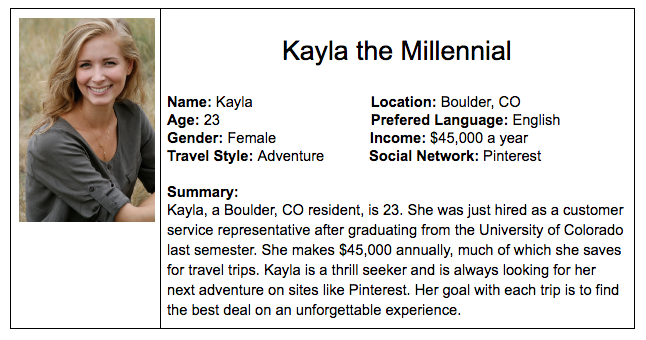
Also, we like to assemble the information in a tidy, visually appealing way. We find that it just makes them easier to use. But this isn’t mandatory. A spreadsheet or Google doc with all the same info can work just as well.
Finally, while your research will turn up loads of valuable information, there may be some areas where you’ll need to make educated guesses about your audience. That’s ok! If you find that these guesses were inaccurate, you can always adjust your buyer personas.
A Few Buyer Persona Examples
We’ve covered the elements that create an effective buyer persona. We even shared a streamlined version of one (Kayla the Millennial) in the last section. Let’s examine a couple more examples so that you get a solid idea of what we’re after here.
Here’s a strong entry from Lidia Chia :
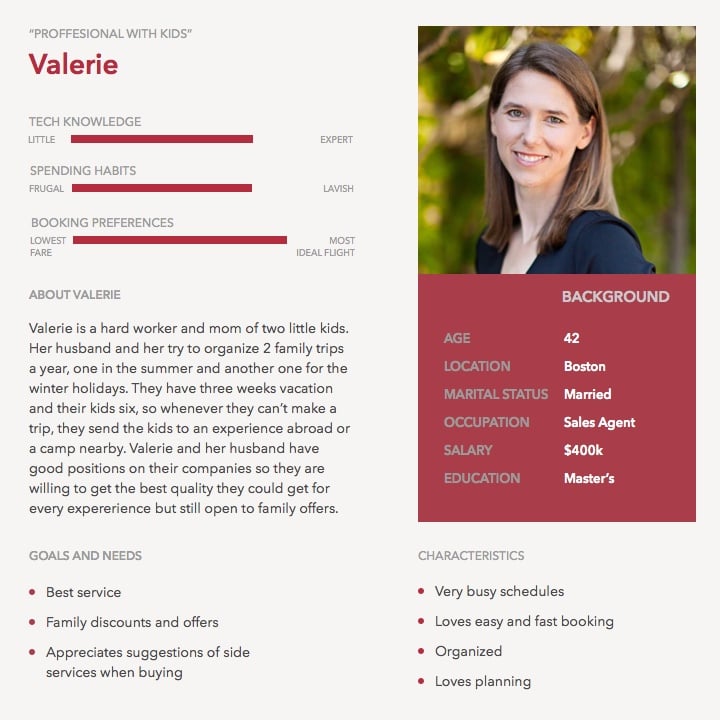
The company marketing to “her” will have much more success than if they were to simply promote their services to “professionals with kids.”
Here’s another solid sample from HostGator :
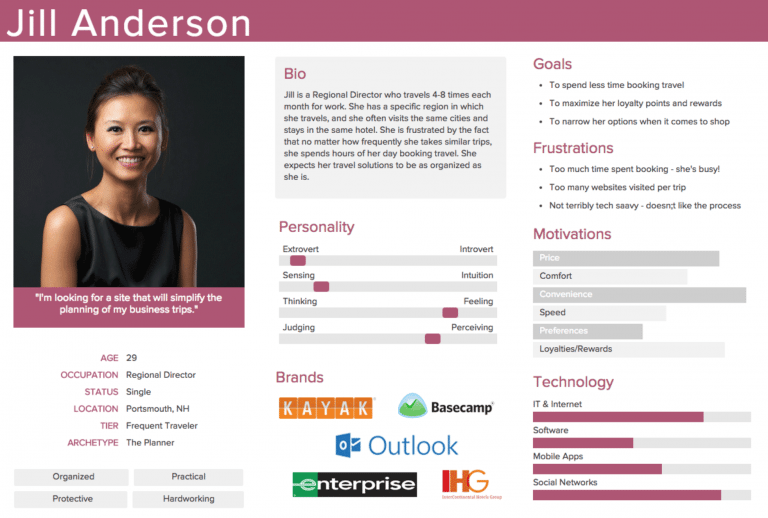
Again, plenty of quality details here that really give us a clear picture of who to market to. Jill is a business traveler. We know details about her personality, brands and technology she likes, and her home location.
Possibly even more important, we also know her goals, frustrations, and motivations when booking trips. This travel buyer persona is very well done!
How to Use Buyer Personas in the Travel Industry
Hopefully you can see the value in buyer personas and already have a few ideas of how you can use them to better market your travel brand . But to help you get the creative juices flowing, here are a few ideas:
Target Your Content
When you segment your audience into distinct groups, each defined by a separate persona, you can then better target the content your create. A blog post about activities for thrill seekers may appeal to Kayla the Millennial, but not to Robert the Retiree.
Instead of promoting the same article to both groups, you can target just the “Kayla” persona. This will ensure that you’re only sending relevant content to your audience.
The same principle applies to other marketing channels as well such as videos, email campaigns and social ads.
Be Where Your Audience Is
If you know where your ideal customers like to hang out online, you can join them. Do they prefer Facebook or Instagram? Do they enjoy reading blog posts or watching videos? Which industry groups and forums are they a part of?
Not only will you be able to learn even more about your target audience, but you’ll also be able to engage them in conversation, build relationships, and promote your business.
Just remember to treat these interactions like conversations, not sales pitches. Your audience doesn’t want to be sold to. They want to engage with others who share their passion for travel.
If a marketing opportunity presents itself, by all means take it! But don’t force the issue.
Partner With Popular Brands
When we say “popular brands”, we’re talking about other companies your audience members care about. Understanding your buyer personas allows you to partner with the right organizations and create marketing campaigns that benefit both of you.
Plus, people tend to judge companies the same way they judge humans: by the company they keep. If your business associates itself with other organizations your target customers love, it will elevate your standing in their eyes.
Speak As They Do
Lastly, a thorough knowledge of the people you hope to reach will enable you to speak their language. How do they verbalize their goals, frustrations, and motivations? Are their common phrases they like to use?
By speaking as your audience does, your marketing materials will be more meaningful to them. You be able to connect on a deeper level. And you’ll have a much better chance of converting a large number of them into paying customers.
Over To You
Buyer personas are an incredibly important aspect of marketing a travel business. Without them, it’s difficult to reach the right people, create relevant content, and differentiate your business from competitors.
So start building your personas today! Begin with research. Dive deep into both the demographics and psychographics of the audience you hope to reach. Then assemble each buyer persona with its own name and picture.
After they’ve been created, you personas will make the marketing process much easier. You’ll be able to better target your content, be involved in the digital communities they care about, and speak in a way that will resonate with them. Good luck!
Contact & Support
Interested in pricing or just want to talk to a human? We would love to hear from you!
Support: [email protected] Sales: [email protected]
Support: 1-866-266-1861 Office: 1-403-266-1861
Mailing address
2225 15 ST SE Calgary, Alberta T2G 3M3 Canada

Start your 30 day trial
Search Travel Market Report

- Packaged Travel
- Hotels & Resorts
- Destinations
- Retail Strategies
- Niche & Luxury
- Training & Resources
- Brian Israel
- Briana Bonfiglio
- Dan McCarthy
- Dori Saltzman
- Jennifer Arango
- Kelly Fontenelle
- Keri-Anne Slevin
- Louis Intreglia
- Sarah Milner
- Tom McCarthy

Debunking the Myths of 'Affluent' and 'Luxury' Travelers
Photo: Shutterstock.com
Images of five-star hotel stays and private jet charters populate luxury travel advertising and website pages, often shaping travel agent perceptions about this lucrative niche. But how accurate is this persona and how is it possibly misleading travel agents looking to go deeper into the affluent traveler segment?
The just-released "MMGY 2017 Portrait of American Traveler" survey reported a number of surprising results that contradict the typical understanding of who a luxury traveler is and how they travel, including this revelation: only about one in three affluent travelers are willing to pay for what most would call "luxury travel” accommodations and transportation.
Thirty percent of affluent traveler respondents said they would pay “full price on a vacation” to guarantee the “quality and service I deserve,” versus 77 percent of luxury travelers, according to researcher and global travel marketing firm MMGY.
Luxury travelers and affluent travelers are different “Travel agents need to see the distinctions between ‘affluent travelers’ and ‘luxury travelers,’” said Steve Cohen, MMGY vice president of insights. “There are significant differences in what they spend their vacation dollars on and how they are motivated to travel.”
Respondents to the MMGY survey indicated that their households earned $217,000 (affluent traveler) and $224,000 (luxury traveler) on average. But from there, these two segments begin to diverge.
For example, one out of ten affluent travelers have not taken a single vacation in the past 12 months, according to MMGY. “We see that many of these affluent travelers are workaholics, and they are spending money on other things, like new homes,” Cohen said.
Luxury travelers, according to MMGY’s definition, represent 11 percent of all American travelers. In the last 12 months, these 6.7 million households took 40 million vacations and spent $67.5 billion on leisure travel.
Also, in the coming year, luxury travelers intend to spend about $10,500 on leisure travel, up about 4 percent from the previous 12 months, they told MMGY; while their affluent traveler cousins intend to spend only about $6,200.
One of the chief motivations for households to spend more on luxury is that “the memories I get from my vacations make the trip worth it,” MMGY’s survey results show. Ninety-two percent of luxury travel respondents said this, compared to 67 percent of affluent travelers.
“Nostalgia is a very real thing for many luxury travelers,” said Lucas Cobb, MMGY vice president of integrated planning. Two in five luxury traveler respondents said that memories of their childhood vacations influenced their current vacation purchases, versus about one in five affluent travelers.
What will they pay for? Just because they have large sources of discretionary income does not mean they will spend it on limousines and high-end accommodations. For luxury travelers, 80 percent said they were willing to pay for “true luxury” lodging, but only 20 percent of affluent travelers were willing to do the same.
For many affluent travelers, a hotel “is a jumping off point, just a place to sleep. It is not a place to be pampered,” said Cohen, adding that affluent travelers focus more on the experiences they will see and feel on vacation, than creature comforts.
He recommends that a travel agent working with a potential high-income household use probing qualifying questions to establish what kind of travel a new client would be open to purchasing. “During that discovery process, it’s important to find out how do they like to travel, where have they stayed recently, why did they choose that property?” he said.
As you build your preferred supplier base to sell to this segment, make sure you vet them carefully, to deliver on the luxury experience your clients expect, Cohen said. “If their expectations aren’t met, not only will the traveler be disappointed with the supplier, they’ll be disappointed with the agent who built those expectations.”
Still, while both luxury and affluent travelers may have money, both segments can also be stimulated by special offers and promotions, the MMGY survey revealed. According to the survey, 76 percent of affluent travelers look to travel service providers’ social media feeds for these offers, versus 65 percent of luxury travelers.
Make doing business simple and on their terms In order to retain a luxury traveler client, an agent needs to provide a higher level of “baseline treatment,” Cohen said. “They want to feel special.”
According to the MMGY survey, two out of three luxury travelers want the purchasing experience “to be as pleasant as the experience of the product/service itself.” Only one in three affluent travelers affirmed that statement.
This means the functionality of your website should be easy to follow, and the way these clients choose to communicate with you should fit their preferences, Cohen advised. “The luxury traveler wants to define the contact channel. Let them tell you.”
Cohen also recommends that travel agents looking to pursue this segment ensure their marketing uses text and images that invoke the nostalgia of childhood vacations from a time when their target market was young.
“These travelers are building family traditions from the bottom up, and creating their own traditions now that they are parents,” he said.
He recommends that agents include more pictures of places without people in them, as well. “You want to say ‘Picture yourself in this place. This empty chair by the pool is your chair.’”
Insider information is expected To win the business of true affluent travelers, travel agents should do their best to portray their knowledge and expertise, and their access to “inside information” about a destination. According to MMGY, 71 percent of affluent travelers ranked “insider/information/access” as the kind of content they expect from social media feeds.
Nearly all luxury and affluent travelers have a Facebook account, while 58 percent of luxury travelers are on Twitter versus only 37 percent of their affluent peers. A third of luxury travelers told MMGY that their vacation destination choices were based at least in part on what they saw on social media; only 7 percent off affluent travelers said the same.
They said when visiting destination web sites and social media platforms, they were influenced the most by professionally taken photos (70 percent), followed by authentic images taken by travelers (56 percent), and “insider information” (55 percent).
Also, luxury travelers have a higher desire (51 percent) to share their travel experiences through social media than their affluent peers (29 percent) and the average traveler (38 percent).
Stay tuned for TMR’s 2017 Luxury Outlook Report to be released Dec. 1 st . Hear what travel agents selling the luxury market have to say about what’s important to their clients and what’s not? Plus, what do top luxury sellers do to ensure happy customers and to set themselves apart from the competition?

MOST VIEWED
- Four Spots Onboard the All-New Sun Princess We’re Not in Love With
- Op-Ed: Why I Won’t Use Costco for Travel Again
- Delta Air Lines Is Changing the Way It Boards Flights
- Testing the Waters with Dori: The NCL Stranded Passenger "Fiasco"
- Margaritaville at Sea Offers Advisor-Only Pricing
- Taiwan Earthquake Update: Train Services Resume, Flights Operating Near Schedule
- Lufthansa Strike Update for Monday
- Amex GBT Agrees to Acquire Carlson Wagonlit Travel for $570 Million
- Here's What Each River Cruise Line Includes
- Horseshoe’s Jubilee Tower Becomes the Versailles Tower at Paris Las Vegas
- Major Cruise Changes Could Come After Baltimore’s Francis Scott Key Bridge Collapses
- The NCL Stranded Passenger “Fiasco”: Your Replies
Subscribe today to receive daily in-depth coverage, analysis of industry news, trends and issues that affect how you do business. Subscribe now for free.
Subscribe to TMR
The ship will officially sail starting in April 2025.

News and notes from A&K’s 100 Club Event, including what's coming from the brand.
Muckermann is departing Silversea Cruises after 14 years "to pursue other opportunities."
AmaWaterways has postponed operations on the Magdalena River until early next year.
The first, all-new, ship will join the fleet in Dec. 2025. The second in Dec. 2026.
The company also revealed its first-ever 59-day "Ultimate Europe Cruise & Land Journey."

3 Core Aspects of Successful Buyer Personas for Travel & Tourism Brands
What’s Your Travel Persona?

Your Travel Persona is you, but on vacation. It’s the side of you that governs everything to do with traveling; from your destinations to the activities you choose to the hotels you stay in. Your Travel Persona is your constant guide. Below common Travel Personas, and some travelers will find that they fit into their category pretty neatly. However, others will find they morph into several categories. To help you make the most of your newfound knowledge about your travel persona, there’s also a few suggestions for destinations that should appeal to your inner-self, so you can be sure that your next vacation suits you perfectly. Keep reading to find out which persona you belong to.
THE NATURE-LOVER
The nature-lover finds joy in exploring unique landscapes and serious hiking opportunities. Most of their trips are determined by the variety of natural marvels they can see on their trip. Often times they look for destinations that allow them to take in as many different landscapes as possible.

WHERE SHOULD YOU GO?

ICELAND – Although Iceland has now become one of the most popular destinations, most people stick to the south of the island. While there is a large amount of natural wonders in the south, the island is covered with hundreds more epic landscapes. Iceland has a different landscape around every corner and sure to appease any nature-lover’s desires!
THE LUXURY TRAVELER
The luxury traveler is the kind of traveler who wants to see the world… in a certain way. If you’re a luxury traveler, then you are more likely to look at hotels before you think about the actual destination, and the idea of “roughing it” is anathema to your travel plans. You’re the kind of traveler who dreams of a private jet for your own usage, looking for more info on the perfect interior for it, and traveling with your comfort as the top priority.

DUBAI – It may seem a little cliche, but there’s really nowhere else in the world better for luxury travelers than Dubai. After all, this is the city with a seven-star hotel , a huge shopping mall featuring all the luxury brands, and man-made islands with the most perfect beaches you’ve ever seen. If you’re a luxury traveler, then Dubai is an absolute must-visit.
THE SPIRITUAL WANDERER
The spiritual wanderer is a person who’s looking to get in touch with their inner-self and their spiritual side. They may enjoy activities like exploring eastern temples, spiritual retreats, yoga or mediation. The spiritual wanderer is often on a quest, but that doesn’t necessarily mean traveling from place to place. Sometimes, that means staying in one place.

LUANG PRABANG – This slow-paced mountain town is the perfect place to get in touch with your spiritual side. It’s often referred to as the spiritual center of Laos. There are dozens of Buddhist temples where you can meditate with monks, you can enjoy a yoga class with Luang Prabang yoga and the natural views around the city are sure to put you in a zen mood.
THE ADVENTURE-JUNKIE
The adventure-junkie is not the kind of person who goes on vacation to relax. In fact, sunning themselves on the beach is their idea of a nightmare. They want high octane excitement every day that they’re away; there’s not a bridge they don’t want to bungee jump from, a mountain they don’t want to ride a bike down. Adventure-junkies are more likely to come home from their vacation needing a rest than feeling refreshed and rejuvenated!

NEW ZEALAND – If you’re looking for a trip of non-stop excitement, then New Zealand is an essential choice. New Zealand is a country full of a variety of natural wonders, and there’s more adventure activities to try than you could possibly fit into a two week vacation— so you might need to go twice! From glaciers to incredible mountains, New Zealand has got it all, and is simply the best choice for adventure-junkies on the lookout for their next destination.

SOUTHERN UTAH – Southern Utah is the perfect place for adventure-junkies. Its desert landscape is phenomenal for your next trip! You can hike, rock climb, mountain bike and more! If you want to do something a little less physical, you can rent a jeep and take it off roading or on some epic 4-wheel drive roads.
THE HISTORY BUFF
History buffs are looking to see the world… as it used to be. While modern cities are fun, for the history buff, looking back is more important than looking forward. They want to explore ancient artefacts, learn more about the civilizations of centuries long past, and immerse themselves in the stories of the people who once walked the same roads they can now walk in the 21st century. If you’re a history buff, you’ll know the thrill of being able to immerse yourself in a city or country. While museums are important to you, what you really want is a city of living history, where the old aligns with the new, creating a spectacular bridge across the centuries.

ITALY – Italy is a haven for Historical Travelers. You’ll likely want to spend a week or two in the country, exploring all the incredible historical sites that this country has to offer. Much of the history is “living” history too, so you don’t need to spend your days cooped up in a museum just to look back in time. You’ll definitely want to visit the ruins of Pompeii , as well as the capital, Rome, which is home to some of the most stunning ancient structures in the world.

GREECE – Another epic destination for Historical Travelers is Greece. The whole country is dotted with archaeological sites that you can remember from Greek Mythology and history classes. Don’t miss Olympia where the first ever Olympics were held and Delphi where major political decisions were made.
THE CULTURE VULTURE
For a cultural vulture, a vacation is a chance to see another culture. If you’re this kind of traveler, then you’re likely accustomed to spending a lot of your vacations indoors. You like to wander museums, art galleries, attend ballets and symphonies— the destination itself isn’t quite so important. Cultural vultures tend to love to spend their time exploring a city in depth, so they’re less likely to take off backpacking, go on a city break, or be willing to tour a large area in a short space of time. Instead, Cultural Travelers like to root themselves for their vacation, dive deep into an area, and soak up the culture of their chosen destination.

AMSTERDAM – For the other personas, it’s been possible to select an entire country— but cultural vultures will want something more specific. If you’re a cultural vulture, then look no further than the Dutch capital of Amsterdam. Amsterdam is home to two World Heritage sites, 96 theaters, 81 museums, 43 Michelin-starred restaurants, and plenty more besides. If you’re looking to visit a city with a rich culture just waiting to be explored, Amsterdam is the perfect choice for your next vacation.

NEW YORK CITY – A perfect spot in the U.S. for the culture vultures is NYC. There are around 100 museums and epic restaurants and bars to visit. They don’t have to be Michelin-starred to be delicious. Plus, New York City is the home of Broadway and there’s unparalleled architecture in this city.
Foodies are all about, you guessed it, food! Foodies scope out destinations based on where they can find unique flavors, fresh ingredients and local dishes. The foodie doesn’t necessarily need high class restaurants, they just want to make their taste buds feel alive. In fact, often times street food is their preference.

THAILAND – Thailand is one of the greatest destinations for food EVER. The food is amazing quality, full of flavor and it can be as cheap or expensive as you want it to be. In addition to local markets, fine dining and street food, Thailand is a phenomenal place to take a cooking class as well. Then, you can wow your friends with your amazing Thai recipes.
THE TRAVEL CHAMELEON
The travel chameleon is the person who does it all and blends into ever scenario. I think I tend to be in this category. When I got to a destination I want to dig in to the culture, to explore the nature and sample the local flavors. The world is big and each destination has a little something different to offer. However, there are several destinations that have it all.

BALI, INDONESIA – Although Bali isn’t a massive island, I truly feel like it has it all. There’s rich culture + art, delicious local foods, a unique form of Hinduism + spirituality, loads of yoga, stunning nature and plenty of adventure opportunities like white-water-rafting and scuba diving!
Whether you perfectly fit the personas above or have a hybrid Travel Persona, the destination ideas suggested should appeal to you. By letting your inner traveling voice be your guide when choosing where you should visit next, you can be confident of a vacation experience that you’ll absolutely adore.
Which travel persona are you, did you enjoy this post pin it so others can too.

Disclaimer: This post contains affiliate links. If you make a reservation with Booking.com or purchase a policy with World Nomads through For the Love of Wanderlust, you will help me stay on the road + keep my site running at no additional cost for you. Be sure to read the terms + conditions of these sites when booking or purchasing!
Love this Post? Share It!
- Click to share on Facebook (Opens in new window)
- Click to share on Twitter (Opens in new window)
- Click to share on Pinterest (Opens in new window)
- Click to share on StumbleUpon (Opens in new window)
- Click to share on Tumblr (Opens in new window)
- Click to share on Flipboard (Opens in new window)
- Click to share on Pocket (Opens in new window)
- Click to email a link to a friend (Opens in new window)
Enjoy This Post? Check Out One of These!
About Paige Wunder
Paige Wunder is based in the Ozarks where she lives with her husband. When she's not hiking in the mountains or planning a backpacking trip, she's taking a road trip or sampling some delicious craft beer. She loves sharing her adventures both big & small.
You Might Also Like

Sites to See Along Potash Road – Moab, Utah

Wat Thipsukhontharam – Near Kanchanaburi, Thailand

New Orleans
I it possible to be more the one? I think I have a combination as a culture vulture, foodie, and the travel chameleon. I guess it depends on where I am going.
Paige Wunder
Oh yeah! You can totally have more than one. I think I’m a combination too. Chameleon, Culture Vulture and Nature Lover are my main three.
Siddhartha Joshi
Such a wonderful post Paige! This got me thinking and I realised that I don’t fit in any one, but many (I am sure like many others). This opens up even more travel opportunities I guess…right now it’s New Zealand on my mind 🙂
I am a travel chameleon mostly, except for the fact that I have fewer shades of spiritual travel and foodie travel. I like sampling local cuisine but I can also, be least bothered about the food bit. Loved reading the description of the various types. Cheers
Join the Conversation! Cancel reply
This site uses Akismet to reduce spam. Learn how your comment data is processed .
© 2015 - Solo Pine. All Rights Reserved. Designed & Developed by SoloPine.com
Travel Personas and How to Influence Them to Book
Destination marketers seeking to capitalize on the surge of global travel take note: travelers are still looking for the best deal, but also want a personalized customer experience, writes Sally Ann Lopez, Senior Program Manager, Marketing & Operations, CMO Council.
Travel and tourism generated $1.6 trillion in bookings in 2017 and now accounts for over 10% of global GDP. Technology and service innovations are making it easier and cheaper to discover, reach and enjoy travel destinations. Destination marketers seeking to capitalize on the surge of global travel take note: travelers are still looking for the best deal, but also want a personalized experience.
When planning their next journey, it’s still all about “me” as travelers are less likely to be influenced by the social crowd and more moved by their own special interests, safety and security, according to new research, entitled, “What’s Changing the Way You Travel Today,” Opens a new window conducted by the CMO Council in Q3 of 2018.
Beliefs, values and interests are influencing where, how and why people travel. While deals, specials and promotions are driving desire and action, visually enriched and personalized digital content channels are making travel experiences more alluring and exciting. Engaging with travelers by offering them specialized deals and promotions to the areas that best align with their interests will get them to book.
Also Read: How the Human Factor Blends with Marketing Automation to Create That Perfect Data Analysis for an Enhanced CX Opens a new window
Given the significance of personalized engagement, this report uncovers travel ‘personas’, including the smart, well-informed planner (31 %), relaxed nomad – easygoing and flexible (25 %), and deal seeker on a budget (22 %). These personas each have their own influencers, deterrents, and innovations they are most likely to leverage when booking. Speaking the language of the traveler will aid destination marketers on their quest to bring travelers to their unique destination.

Enabled by technology innovations, today’s diverse travelers are smarter, more informed and better prepared than ever before. Nearly half of the 2,000 leisure travelers polled say Internet and device connectivity makes their travel experience better overall, and 42 % believe technology innovations and advancements across all modes of travel have improved the experience. An additional 38 % say these tech advancements have helped them find deals, discounts and destinations more easily.
More than 51 percent of travelers surveyed say great deals and discounts are what prompts them to make a travel booking. Easier, do-it-yourself travel planning is also a major factor for 32 percent of travelers. Other influences are referrals from family and friends (29 %), exciting images or video (21 %), and interesting stories or articles (21 %).
Factors most influencing travel choices tended to be more about passions, self-interests and destination appeal, rather than travel issues or concerns:
- Special interests, hobbies, and diversions (43 %)
- Security, stability, and friendliness of destination (36 %)
- Adventure, recreation or sports pursuits (30 %)
- Culture and history of the local people (29 %)
- Destination geography and diversity (29 %)
Also Read: Personalize or Perish: The Content Marketing Dilemma Opens a new window
Surprisingly, only 15% relied on their social media networks to help shape their travel choices, and just eight percent pointed to political ethics, human rights practices or prejudices in travel locales as a consideration when choosing travel destinations.
Yes, travelers love deals. But when thinking about how to truly influence them, destination marketers must think about the individual persona. What makes each individual traveler tick? Marketers must leverage the right technologies through the right channels to reach them, but also keep those travel personas top of mind. Consider what will get them to book when you hit them with content, images, and promotions.
Share This Article:
Senior Program Manager, Marketing & Operations, CMO Council

Recommended Reads

How Business Process Automation Can Empower Companies

Zero to CX Hero: Passwordless Revolution Is Here

How To Target The Right Audience In A Crowded 2024 Political Field

Digital Experience Takes Over as a Key Boardroom Issue

How To Transform RFP Processes for Business Growth

How To Create Sustainable Fan Engagement With Digital Tech

Travelers’ Journey, Personas, and the 4Ps of Tourism Marketing Mix

Research has shown that the tourism sector will become increasingly hypercompetitive after the COVID-19 pandemic. Therefore, consistent promotion with a marketing mix is a realistic and fresh approach to achieve tourism goals.
Understanding audience personas and processes through their mindset is necessary, using a precise method that employs the concepts of attention, inspiration, desire, action, and loyalty. These personas and processes are essential for tourism and travel companies.
Only 27% of the companies in the tourism sector have documented their content strategy at every stage of the traveler’s journey. Thus, the “attention–inspire–desire–action–loyalty (A-I-D-A-L)” method may help inform your travel and tourism content planning with purpose and later promote your content on various channels and networks.
The top three advanced personas are enthusiasts, planners, and adventurers. These three personas (or imaginary individuals) correspond to the essential segments that we aim to attract, including luxury travel, leisure, and business travel . They will help us visualize the targeted travelers and develop brand messages and digital marketing tactics that will resonate with them.
How can you connect with enthusiasts? Enthusiasts are always open to destination discovery and exploration. They are thrill-seekers and want to get away from it all. To reach out to this cohort, you need to take the time to document your content by using the attention–inspire–desire–action–loyalty method.
You can enhance the awareness that an enthusiast has of your travel and tourism brand through all the types of content that you are producing. Create content based on their demographic profile to gain their interest in your tourism campaign. Appeal to them with vivid stories through your persuasive messaging, thereby motivating their purchase desire. Showcase your content on every digital platform so that they can take action and envision their vacation to a bespoke destination. Gain their loyalty by offering reward programs, travel passes, and memberships and, most importantly, by communicating with them regularly through email newsletters.
Enthusiasts may not have a particular destination in mind and could consider your expert suggestion.
Digital Marketing Mix to Engage Enthusiasts
- SEO-based posts that inspire the discovery of new destinations, brands, and activities
- Social media photos showcasing properties, suites, and adventure options
- Branded PPC campaigns to increase demand around the destination or property
How can you connect with planners? Planners are always prepared for activities, and their travel experience begins online. They may create entire itineraries, find deals, and choose the package options to shop from based on their interests and comfort levels. Moreover, for planners, a similar A-I-D-A-L method would be used to document their content strategies.
Enhance planners’ awareness of your travel and tourism brand. Drill down content based on their demographic profile to gain their interest in your tourism campaign. Appeal to them with vivid stories through your drive, creating a desire in them to purchase your product. Use your most compelling content on every digital platform so that they can take action and envision their vacation to a bespoke destination. Obtain their loyalty by offering reward programs, travel passes, and memberships.
As a result, planners’ expectations will increase, and they will plan their trips from the outset.
Digital Marketing Mix to Engage Planners
- Create “checklist posts” to help them prepare for a specific trip
- Showcase advanced photographic ideas on social media channels to inspire them
- Customize a campaign to show safety protocols and comfort levels to help them prepare in advance
How can you connect with adventurers? Adventurers have a powerful travel persona and can be great advocates of tourism and prolific sharers of knowledge. They have an overpowering lust for the outdoors and a burning desire for adventure travel. They always have a list of adventures to embark upon for their next trip. Further, for adventurers, a similar A-I-D-A-L method would be used to document their content strategies.
You can make adventurers aware of your travel and tourism brand. Produce content based on their demographic profile to pique their interest in your tourism campaign. Appeal to their purchase desire with vivid stories. Use your content on every digital platform so that they can take action and envision their vacation to a bespoke destination. Obtain their loyalty by offering reward programs, travel passes, and memberships and, most importantly, by communicating with them regularly through email newsletters.
Adventurers are in love with adventure travel. They chase it around the globe and plan on having a good time experiencing the best adventures on the planet.
Digital Marketing Mix to Engage Adventurers
- SEO-based posts highlighting the best adventure destinations
- Photo collateral in HD showcasing physical activities and adventure options on social media channels
- Creative YouTube video ads with experiments and sequencing showcasing adventure moments
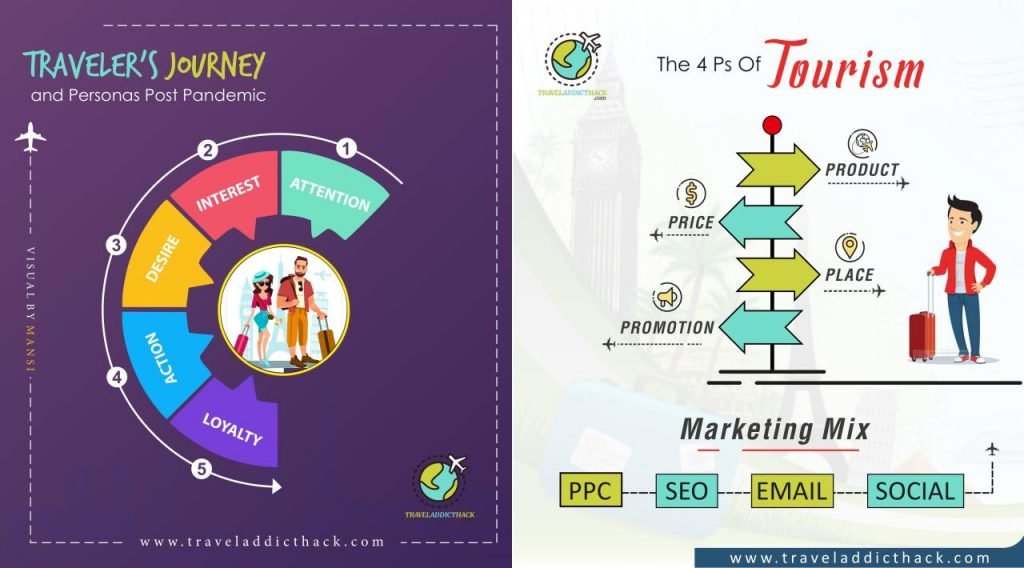
Use the 4Ps model in travel and tourism to connect with each individual The 4Ps in tourism are “product,” “price,” “place,” and “promotion.” They are intangible factors for enthusiasts, planners, and adventurers and are categorically streamlined as follows.
Product: Tourism involves components ranging from the niche to mass appeals, such as accommodation, food, beverages, transportation, scenic beauty, the historical significance of places, geographical state, and concerts like Coachella, Woodstock, and Sunburn. These attractions can appeal to travelers in each segment of the tourism market. However, the packaging of your offering is also essential, and every element is intangible and must heighten the tourist’s experience.
Price: Price is a significant factor in the 4Ps of travel and tourism. All tourism products are unique. The tourism business is seasonal in many countries. Thus, price setting based on market competition is a critical component of the experience that travelers require. Their expectations must be met irrespective of whether they are paying modest, standard, or expensive.
Place: Distribution in tourism is a tricky process, whether it takes place online or at shop fronts. Technology has played a pivotal role in the growth of the travel industry, especially with the COVID-19 situation, in terms of sustainability, design, and security.
The real value of innovative marketing is obtaining suitable packages at the right time in the right place. Thus, the location from where you conduct your travel and tourism business requires a proper evaluation. For example, consider your audience—are they offline or online shoppers? Therefore, research is the key to finding the correct place; consider your competitors’ actions in specific locations.
Promotion: In tourism, the promotional activity consists of inspiring, educating, persuading, and reminding the travelers about the brand or product. It refers to the marketing tactics employed to spread brand or product awareness. Various digital channels, including traditional, OTT, and CTV devices, are used in the tourism industry. The attention–inspire–desire–action–loyalty method will help you find your target audience and promotional strategy and campaigns. Different demographic segments may have varying responses to your marketing efforts. Therefore, consistent promotion must be realistic throughout the traveler’s journey.
These 4Ps can be mixed and merged beyond imagination in any marketing mix strategy.
This article presents a comprehensive overview of the types of audiences searching for travel and tourism information that can help you plan your campaign accordingly and promote it on various channels and networks.
If you are looking for help in developing a content strategy and campaign that furthers your travel and tourism business goals , feel free to contact me today at [email protected] , and let’s discuss your project. For more information, visit TravelAddictHack.com or get social on Instagram and Linkedin .
The author is an analytical thinker and blogger.

Association
- Luxury Hoteliers Magazine
- Submit Content
- Login / Account
- Lost Password
- Travel & Tourism Companies
- Communication Companies
- Media & Press
- Travel News
- Special Coverage
- Upcoming Webinars
- Past Webinars
- Management Companies
- Ownership & Asset
- Independents
- Consultants
- Design & Development Companies
- Marketing Organizations
- Appointments
- Education Companies
- People News
- Featured Products
- Supplier News
For any enquiries email us at [email protected] or phone us at +1 561-203-0855
Ⓒ 2022 - All Rights Are Reserved
Privacy policy.

- May 20, 2022
- 11 min read
Hotel Guest Personas: Understand Your Customers

Each individual is unique with their physical characteristics, personality, tastes, preferences, and capabilities. Accordingly, they make different choices in their lives, be it their career options, friends, clothing, type of accommodation, places they travel, the food they eat and so forth. Hence, there are several types of hotel guest personas.
Individuality is what adds colour to the world. The same goes for choosing a hotel as well. Hotel guests have different tastes and preferences, along with varying budgets. Hence, hotels have to deal with different types of hotel guests.
Before creating a hotel distribution strategy, you need to understand your audience before you take any further steps. If you don’t understand their personality, tastes, preferences and capabilities, you will not be able to reach your target demographic.
Many hotels make the mistake of not knowing their target audience at all! This is why understanding your hotel guest personas are essential.
Table Of Content
What Are Hotel Guest Personas?
Elements of hotel guest personas, types of hotel guests, to conclude.
The hotel guest persona is the representation of the demographic and psychographic characteristics of your hotel guests. Demographics consists of physical and tangible characteristics such as age, sex and location, while psychographics consists of the personality, opinions and lifestyle of the audience.
Even though each guest is unique, a segment of guests follows a uniform pattern. Grouping the overall target audience based on certain characteristics is known as Segmentation.
Segmentation is the first step toward understanding the various hotel guest personas. Understanding the guest personas will help you determine the various marketing strategies to reach out to your target audience and market your products and services to achieve your business goals.
As discussed earlier, we have determined that hotel guest personas consist of demographics and psychographics. Let us understand them in detail before we discuss the classification of hotel guest types.
Demographics
Demographics are the physical tangible characteristics which are quantitative i.e they can be easily measured and classified. Demographics include age, sex, location, income and so forth. They give surface-level information about the audience and are essential for any research work.
Hotel guest personas depend upon these demographic factors because individuals in each demographic set have certain characteristics and circumstances. For example, a 30-year-old has more purchasing power compared to a 20-year-old.
Psychographics
Psychographics go beyond demographics. They also play a major role in determining hotel guest personas. They try to understand the ‘hidden’ aspects of the sample, including their personality, tastes, preferences, opinions and lifestyle. They are qualitative i.e they cannot be measured in numbers and classification is also a tedious task.
For example, person A may like a resort more than person B, however, you can’t give a fixed numerical value of how much more person A likes a resort more than B.
Even the various preference scales can only give an idea of preference, not the exact amount of preference. If a hotel is rated 5/5 by one guest and 3/5 by another, we can say that the former guest prefers the hotel more compared to the latter to a great degree. But we cannot determine the exact measurement of their difference in preferences. Even the star ratings given by each customer are subjective based on different factors.
Demographics And Psychographics: How They Interact
Demographics and psychographics, they separate, are interconnected and cannot be handled in isolation. For example, the age of a hotel guest will determine their lifestyle. A 40 year will not be passionate about a beach party like a 21-year-old would be. This is why it is crucial to decide on hotel guest personas before formulating any marketing strategies.
A 17-year-old is similar to an 18-year-old in most aspects. However, since the former is a minor and the latter a legal adult, the 17-year-old will not be able to book a hotel room without parental presence. The 18-year-old only the other hand can independently book any room he or she wants, as long they have the finances and maybe, unofficial parental permission.
Corporates mostly take business-related travel, with a little bit of leisutheir re in spare time, while a freelancer can take more leisure-related travel. Women want different services compared to men. As you can see, Demographics and psychographics are interconnected and psychographics is influenced by demographics.
How that we have discussed the concept of guests'guests persona, let us now segment the target audience into various types. Each hotel guest type has a particular persona i.e various characteristics and personalities. The various hotel guests may be unique in r own way, however, we can do guest segmentation based on the combination of similar and interrelated characteristics.
One needs to understand that the classifications are not rigid. A guest can have multiple guest personas at once and also adopt different hotel guest personas according to the situation and their mood. Let us now discuss the various guest types and how hotels need to approach them.
1. Casual Vacationers

Casual vacationers are the most common hotel guest persona. They want only one thing i.e relaxation and enjoyment. These guests don’t have any specific preference, unlike say, an adventurer. They have diverse needs - for example, one may want a hill station vacation, beach vacation or sight-seeing-oriented vacation.
Casual vacationers will choose the places which are mostly generic and can travel anywhere, as long as it's easily accessible and guarantees them a good it. For Example, they will explore places like Goa, Kerala, Thailand, and other popular destinations.
They want a hotel that offers value for money. They may want to stay at a budget hotel, a high - mid-range hotel, or a luxury hotel. They want rooms with all the amenities such as air conditioning, heating, swimming pool, restaurant, bars etc.
They want to stay at a location which is easily accessible to various entertainment and sightseeing options. That’s why they chose hotels located in popular areas, close to the city centre, or popular attractions. They are the easiest type of hotel guests. They want a great time, and all a hotel needs to do is give it to them.
If a property wants to target this segment, they need to just give them great rooms at a great price, and enhance the experience they are looking for. Offer them great amenities at the price they are paying.
Hotel Guest Persona:
Casual - Nothing specific in mind
They can be of any age
They want enjoyment
Want Most Out Their Money
Can be of any profession
Can have varying budgets
2. Casual-Specific Travellers

They are like casual travellers, the only difference is that they are more specific in their needs compared to other casual travellers. They want particular experiences and will not compromise on those. For example, a beach lover will prefer to have a beach vacation, a hotel guest may want a swimming pool, or a customer may like pub hopping in the city they are visiting. The specific needs of this hotel guest persona need to be fulfilled.
They are a more challenging guest persona compared to casual travellers. They need a specific need fulfilled and will accept no compromise, even if the other needs are fulfilled. For example, the beach lover will want a reonrt at the beachfront, or within a walking distance of the beach.
He or she may also want to book accommodations that enhance their beach experience, like a beach resort that offers spacious rooms overlooking the beach, and has a swimming pool and a bar for cocktails.
They are willing to pay extra for the experience. Any compromise on that experience will make the guest annoyed. Hotels should understand the strength of their location, and determine how their hotel can enhance their experience. Work on the strengths and ensure that the Casual - Specific traveller comes again and again.
Usually Casual, but they want something specific
Can be of any age
Can have a varying budget
They want a particular experience, only then they will enjoy it.
3. Business Travellers

They travel for work and want a property that gives them a good night's sleep and relaxation after they come from their flight or their meeting. They are also not too concerned about the price since it's the company that pays the bill. They are the among most common hotel guest personas.
They want a functional hotel, with comfortable rooms and quality amenities. They also want to stay in the city centre, accessibility to their work locations.
Business Hotels need to be in the city centre and offer them all the facilities to make their corporate trip smoother. Many business travellers also do some sightseeing when they have time. They also visit the various pubs, bars and restaurants after work. The hotels targeting business travellers should be in central locations.
The hotel also needs to provide various other amenities such as a swimming pool, in-house restaurant, bar, and other recreational options. Reaching out to corporates directly is the best option for business hotels since it's the corporates which send the employees on these trips.
Work oriented may explore a bit
Want something functional and comfortable
Young, Mid and Senior-level professionals
Not budget concerned
Aged - 21 - 50s
4. Family Vacationers

Family vacationers are similar to casual travellers in many ways, except that they have a family accompanying them. The single-family group can range from 3 - to 5, if travelling with extended family, it can also range from 6 - to 12 as well. They travel once or twice a year and hence, want a great deal and the most out of their money.
They also have limited options regarding where to go, since they have to choose kid-friendly places such as causal destinations, beaches, hill stations are so forth. They have slightly less freedom and options. They also need spacious rooms and amenities that will make their family vacation memorable.
They will go to places like amusement parks, and common sightseeing locations, and also explore the city a bit. They can choose a budget hotel or a luxury hotel, and anything in between.
Hotels need to ensure that they are offered a comfortable experience and that the family is one unit, so they need to be served accordingly.
Usually aged between their late 20s and beyond.
Family travellers are usually risk-averse
They are less flexible
Want to enjoy themselves with their families
Think of themselves as one unit along with their family
Can be of varying budgets
5. Adventurers

Adventurers are those who are looking for an adventure more than relaxation. These can include hikers, trekkers, scuba divers and surfers. They want to stay in accommodations near these activities. Even better, if the properties themselves make arrangements for these activities.
They are not that concerned with luxury or high-end amenities, they just want a comfortable place to sleep and relax after they have enjoyed their adventure. They want a bed, a cafe to unwind, maybe a swimming pool and a place to sit and chill.
Hotels that offer these adventure activiates are on the top of the list for adventurers. Hotels near trekking points, surfing facilities, scuba diving facilities etc should conduct these adventure activities to attract more guests. The popular accommodations for adventurers are budget hotels, hostels, camping sites, and other properties ad the adventure activities.
Usually Aged between 18 - 30. However, some can be 30+ as well.
Want to experience fun and adventure, accommodation is a secondary concern
Want a budget deal on the accommodations
They are willing to experiment and don’t have any particular accommodation type in mind.
Are not too focused on luxury.
They don’t mind mingling with other travellers.
6. Relaxation Vacationers

These types of hotel guest personas have come only to relax. They are generally those who want to unwind after stressful months at a spa resort or a wellness centre. They have a higher demand for amenities since they want a property that can offer them the best relaxation possible.
They are ready to pay extra for high-end amenities such as a large swimming pool, cocktail bars, spa, gym and high-end rooms. They mostly come for weekend getaways or extended weekends.
Hotels serving this category need to provide them with the best amenities. Offering them great deals will also attract more customers. Ensure that they are left relaxed and willing to come again on their next weekend!
Usually aged between 25+
They want relaxation
Usually corporate professionals and those with hectic life
Are flexible with budget
7. Young Travellers

Young travellers are considered to be between the ages of 18 to 25. They are more concerned about vacationing rather than the type of rooms and amenities. They are most adventurers, explorers and casual vacationers. They mostly book budget accommodations since they have lower budgets.
They mostly care about exploring and having fun. They generally chose adventure trips, getaway vacations, sightseeing tours or party getaways. Goa is a great example of a beach and party destination favourite among youths. They want comfortable rooms with decent amenities such as a swimming pool, a decent restaurant and nearby bars, pubs, and happening places.
Hotels can target this hotel guest persona with the help of promos, offers and social media campaigning.
Aged between 18 - 25.
Have a lower budget and fewer needs
Are adventurous and open to experimenting
Want to have fun around the place
Are mostly into adventure, partying and casual vacationing.
8. Luxury Travellers

Luxury Travellers need one thing - luxury. They are ready to spend money to experience high-class facilities and amenities. They can also come under the casual and casual specific hotel guest persona. They want luxurious rooms, which are spacious with even grander bathrooms. They want to experience luxurious restaurants, spas, and swimming pools.
Since they have the budget, all they look for is a property that will give them something unique that beats all the other luxurious hotels. Luxurious glamping, seafront resorts, holiday villas, and concept hotels are emerging as destinations for luxury travellers.
Naturally, luxury hotels tend to be around upmarket areas, since the guests also want to experience the high-end destinations and localities around them. Hotels need to go out of their way to provide them with a luxurious experience they will never forget.
Hotel Guest Persona
Usually aged 25+. However, they can be between 18 - 25 too.
They don’t have budget constraints
Want to experience fine things in life
Want the best service and amenities
They are usually status-conscious
9. Young Couples

Young couples are one of the most popular hotel guest types. Young couples want to spend time with each other and have various experiences together. There are many types of young couple travellers, including unmarried couples, honeymooners and newly married couples.
Contrary to popopinionnions, these young couples have varying needs. Unmarried young couples, for example, can be casual vacationers, adventurers, and also relaxation vacations. They have a limited budget and are looking for great deals on budget accommodations.
Honeymooners are celebrating a special occasion and hence, want to experience something special. They don’t have many budget constraints and are open to booking luxurious hotels.
Young married couples, on the other hand, have a higher budget compared to young unmarried but are not as flexible as honeymooners. They want good amenities and are open to spending more. They also want their hotel to be near various attractions which they can explore.
Young, between the ages of 18 - 35
Want to spend time with each other
Varying budgets, with honeymooners being more flexible
Can have various personalities - romantic, casual and adventurous
10. Workationers

Workation is the new trend in town. Since the Covid Pandemic, many corporates have started this trend of working from home. Not only that, but the bosses also prefer to work outside of work. They don’t mind going to a hotel at a different location. T
hey work during the day and after completing their work, explore the location and unwind, away from the office and home. They often go out to a bar, shack or restaurant at the location after finishing work. They are a new emerging hotel guest personas.
Workationers are looking for great deals and are looking for properties that offer the amenities that will make their stay comfortable and work easy. They want a property with a lounge area, spacious rooms and restaurants. They want to experience the best of both worlds - work and vacation.
Young Professionals aged 21 - 30
Want a quality property that suits their budget
Want to experience something new and break away from mon?tony.
Functional in approach, with not too many frills. They just want a unique working environment
As a hotelier, you need to understand the hotel guests you are catering, to and want to cater to. Identifying your hotel guest personas is the first step before any further marketing can take place. Not only marketing, but revenue management is also dependent on understanding your hotel guests.
Only after understanding your hotel guest personas, you can determine the types of rooms, the prices of the rooms and the amenities to provide to the customer. Hospitality is built on guests, and without identifying them, you cannot target them effectively.
Read our blogs to know more about the hospitality industry and its various trends.
Recent Posts
Ancillary Services In Hotels: A Revenue-Generating Machine
Hotel Revenue Management Guide: Overview and Basic Concepts
WhatsApp Marketing For Hotels: The Only Guide You Need!

How to Create a “Buyer Persona” in Tourism (FREE TEMPLATE)
- Milan Stojković
- August 15, 2019
A “Buyer Persona” is defined as the semi fictive representation of your ideal customer, based on market research and data about your actual customers.
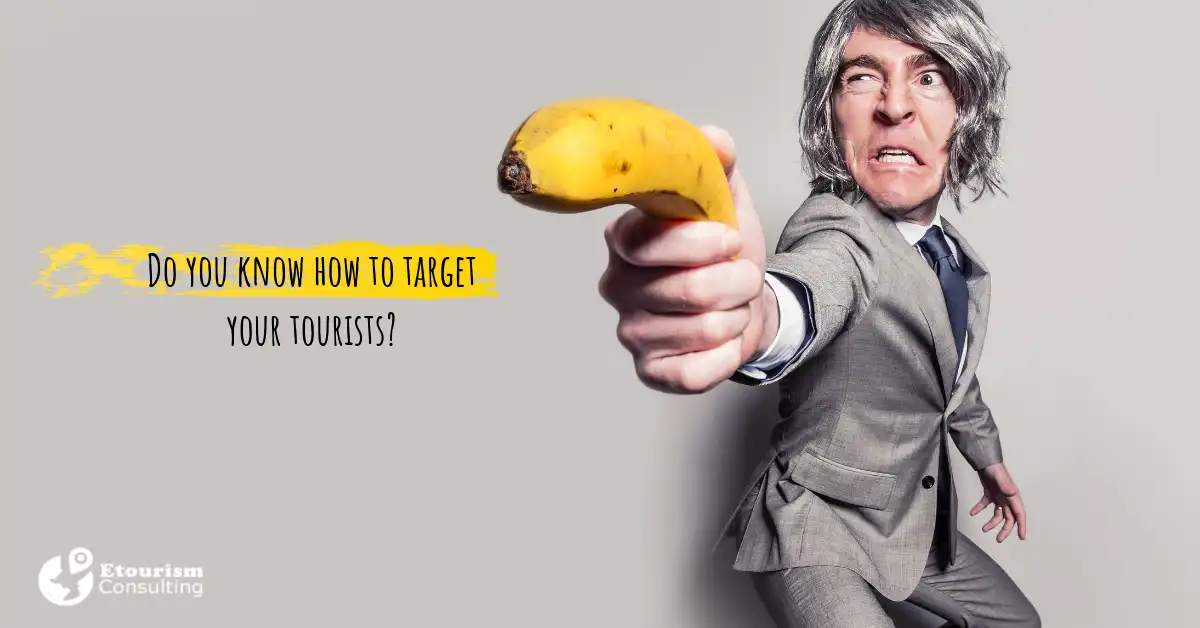
If you are working in travel marketing, then you certainly already know that audience targeting is one of the strongest weapons you have in your marketing arsenal. However, in order to be able to perform appropriate targeting, you need to know who your “target” is.
We often emphasize that today, personalization is the key to success in tourism. Not only that you need to personalize your service but also your promotions and sale messages. The first step on this path is to create a so-called buyer persona.
Have you asked yourself who are your ideal guests and what problems can you solve for them?
If you do not have a clear picture of who your potential guests or tourists are, there are great chances that you will invest a lot of effort and resources in marketing and that in the end, you will not achieve the desired results.
In other words, all your marketing efforts and tactics have to be directed to the right people to those who are your potential tourists.
If you do not know how to recognize them and do not understand their habits, needs, desires, opportunities, and problems, your marketing performance will not yield any results; no matter how hard you try, simply because it is aimed at the wrong audience.
Lions can’t hunt zebras if they don’t know how they move, what are their needs and weaknesses.
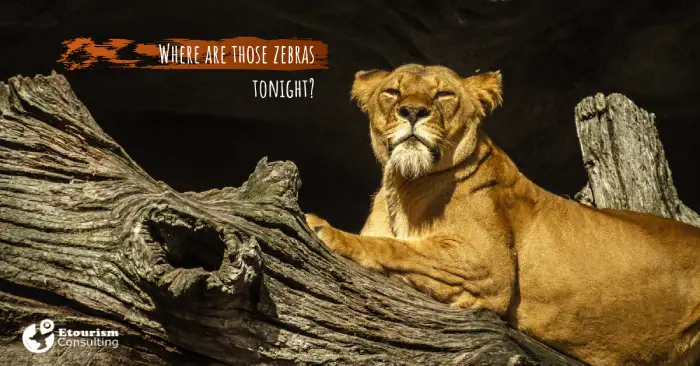
The same applies to your marketing ads if you don’t know where and how to attack your ideal travelers.
Therefore, knowledge and understanding of your potential guests is a prerequisite for achieving desirable marketing results.
Why is this important?
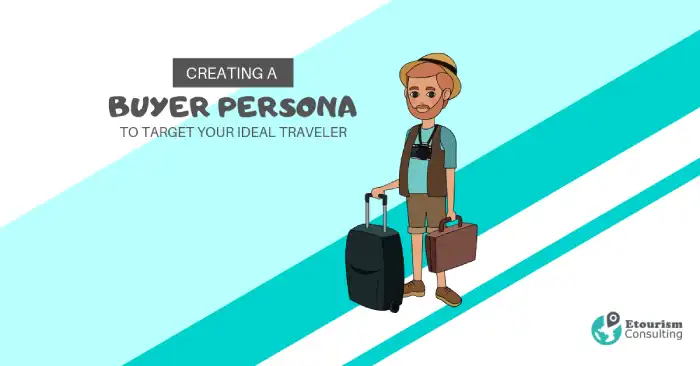
The Internet has brought incredible possibilities in targeting, or displaying ads exactly to those people who are interested in what we offer.
Previously, there were no such options. You could have put a beer advertisement at the time of the football game, but you’re not sure whether only beer lovers will see it and how many among them do not drink beer.
Now, however, you can easily show your ad ONLY to those people who are interested in what you offer and pay just for that. Therefore, the Internet is the most effective marketing channel, but only if you promote the offer to people who are your target group.
To know how to take advantage of this, you must first do the homework and get to know your target group.
If you don’t do that you will go to your Facebook Ads or Google Ads platform and you won’t know how to set up your targeting, or you will do it wrong. It is therefore importan t that you read this article .
What is A “ Buyer Persona “ ?
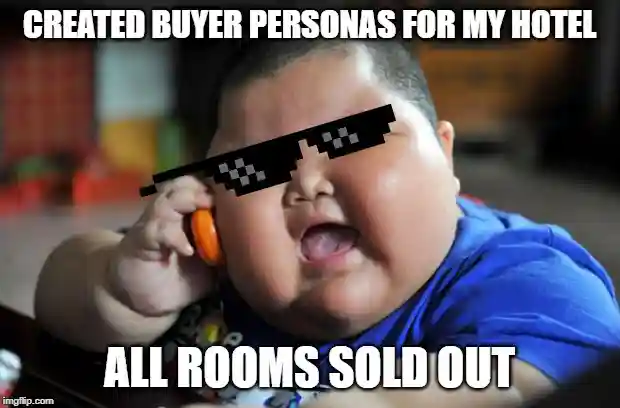
We know that we cannot be devoted to each individual (potential) tourist and guest, so long as their number is higher. Similarly, we cannot offer the same product or service to all our customers, primarily because their interests are different – the diversity of demand, as one of the main features of the tourism market, also conditions the relative diversity of the offer.
We know that in tourism, the offer is not easily adapted to a tourist demand. If a tourist is looking for a pool, you cannot make it overnight; if a guest demands a larger bathroom, you cannot just expand it. It is, therefore, important that you focus your bid on the market segment that you think will be most interested in what you offer.
What we can do is group a large number of our individual clients around some common interests, needs, problems, and so on. Just here, the “Buyer Persona” enters the scene.
After analyzing who our potential tourists are, we can segment them according to their needs, desires, interests, based on gender and age, family status, purchasing power, and so on.
Based on this analysis and market segmentation, different groups of our potential clients can be individualized in the form of one, two or three “Buyer Personas”.

As we have already said, “Buyer Persona” is a half-fictional figure of our ideal client. Why is it half-fictional? Because this person does not actually exist, we have invented and created it on the basis of numerous information and data about our real clients.
“Buyer Persona” , or our ideal client, represents a kind of generalization of all the characteristics of a particular target group. It is an ideal representative of one of our target groups (you should not have more than 5 target groups on the market).
Instead of focusing on some abstract concepts such as your target market or target group, “Buyer Persona” allows you to “humanize” and individuate your promotional messages.
Simply, you will easily understand your clients if you can “point your finger” to them and name them by one name, instead of talking about them using pronouns.
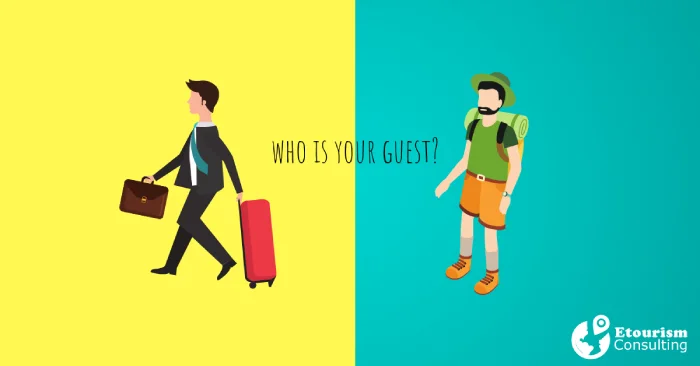
Based on all of the above mentioned, it’s clear that “Buyer Persona” will help you send a clearer and customized message to your target group, keeping your advertising costs low, which will ultimately result in more effective marketing.
How to create a Buyer Persona?
First of all, consider how your “ideal guest looks:
- How many years she has?
- What is her job and how much she can pay for a trip?
- Does she travel alone or with her family?
- Does she needs parking or transfer from the airport
- What is she generally interested in?
- Can she have an active vacation in your destination?
- Does she speak your language?
These are all the details that you, more or less, already know about the existing and potential tourists and guests. The closer and more precise you do that, the better the “Buyer Persona” will be.
To create your “Buyer Persona” you need to understand that group of your potential tourists and guests and see what their common characteristics are, if they have some common problems, fears hopes, and finally, their basic needs and wishes which you can fulfill with your offer.
There are several ways to do this…
GOOGLE ANALYTICS
By reviewing reports in the “Audience” section of your Google Analytics, you can learn a lot about your audience.
Demographic reports show the age and gender of your website’s visitors, and also the info about location and language, which devices are used (desktop, laptop or mobile).
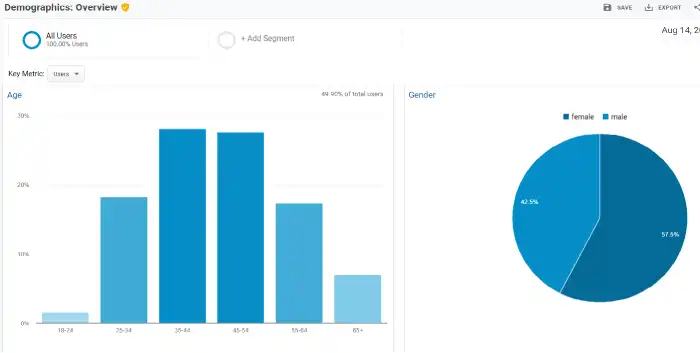
Probably the most useful segmentation of your audience is based on their interests.
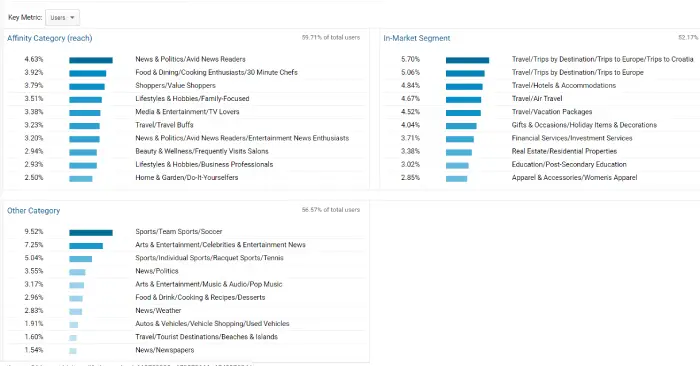
For each of these segments, check what their behavior on the website is – how long they stay, how many pages they turn during one visit, and what is the bounce rate. Those who have the greatest retention time, a higher number of pages visited per session and a smaller bounce rate are definitely candidates for sorting them into different buckets and defining them as buyer personas.
FACEBOOK ANALYTICS
Facebook page of your travel agency, destination, restaurant or a hotel also collects a wealth of information about your followers. This information is very useful because it helps you to better understand the fans of your page.

You can get even more info in the Facebook ads analytics. Just go to your ads manager, use the Breakdown option and choose between ages, gender, location, devices, etc.
You can definitely learn a lot about demographics of the people who engaged with your Facebook page or some of your ads.
What’s also important to emphasize is that the data contained in Google Analytics and on the Facebook page do not apply to the same audience! Audience information in Google Analytics relate to the visitors to your website, while the data in your Facebook page statistics relate to your Facebook page’s followers and fans.
FACEBOOK GROUPS
Facebook groups most often gather people of the same interest, with the same occupation, problem or any topic discussed by its members. All you have to do is search for the groups that deal with travel, hotel, tourism, specific destination, etc.
There you can see which questions are the ones that the members of the group are often troubled with, which topics bring the most interests, what they are afraid of and what their previous experiences were (either positive or negative).
Additionally, you can look at their personal profiles to get an approximate picture of who these people are, gathered around the common interest (e.g. Italy travelers, mountain lovers, nightlife enthusiasts), which is the essence of creating a “Buyer persona”.
ONLINE FORUMS
Similarly to Facebook groups, you can follow discussions on forums about important issues and questions related and important to your business.
Questions like “How to get a visa for Mexico?” or “What is the maximum size and weight of luggage?” and the responses can help you understand the fears and concerns of your potential tourists.
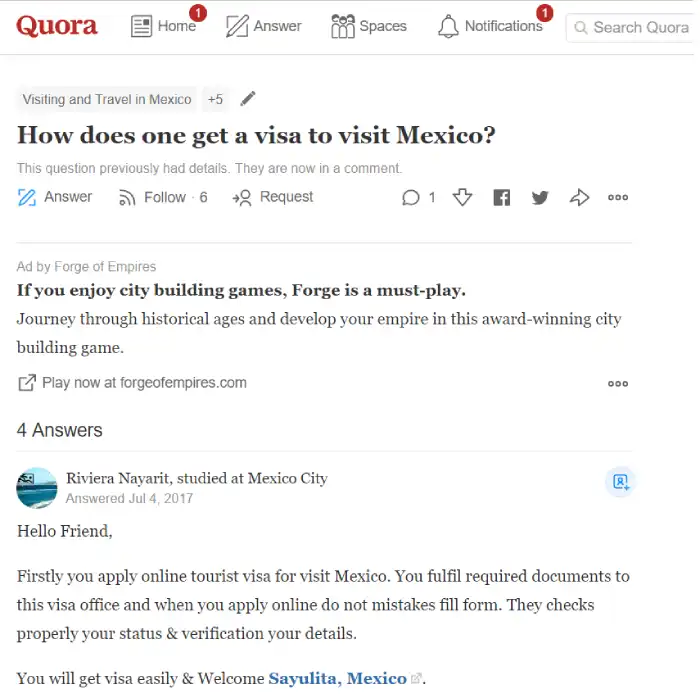
These are the real experiences and critics at the expense of your business and the quality of service provided by your tour company, restaurant, destination or hotel.
Browse the book of impressions; see the reviews that your hotel’s guests have left on the websites such as Booking.com or Tripadvisor, see the reviews that fans leave on your Facebook page – you will see what your tourists and guests liked and disliked. Knowing your existing customers will definitely help you profiling your “Buyer Persona” .
TALK TO YOUR POTENTIAL TOURISTS
Every time a potential tourist enters your agency, sends an email or leaves a message on your hotel’s page, try to find out more about him and his needs. Do you have a specific destination in the offer, whether your hotel is “pet-friendly”, whether vegetarian food is on the menu of your restaurant, whether it is a family holiday resort, does your hotel have a wheelchair ramp?
Starting from some of the most common questions and needs, to specific requests – you can learn a lot about your potential guests and tourists just by talking and communicating with them.
Additional tips
Think carefully about the details, because sometimes certain small things can be groundbreaking in high-quality targeting. Here are some examples…
You must know the true fears of your tourists. For example, parents with young children always fear for their safety, so in the ad you create, you can write that a doctor will accompany the group during the trip.
What do the tourists really want?
Do you know what your visitors really hope for and what exactly, perhaps secretly, they want from your hotel? If you recognize that, you are lucky! You can read more about this in this article .
Favorite websites
Where do your guests spend most of their online time? What are the websites and applications? Here you should not generalize and say something like “sports websites” or “babysitting and parenting websites”, but state the specific domain names of those websites. You can use this later in many ways, but the most obvious is to target these websites as placements with your ads using the Google Ads Display campaign .
Favorite brands
Sometimes, only one brand is enough to laser target the specific group and execute the most effective campaigns. For example, mountaineers probably liked McKinley’s brand, photographers liked Nikon, Sony, Cannon, or Carl Zeiss. You can easily reach the cyclists by targeting those who have demonstrated an interest in Shimano brand, with additional constraints on other interests (biking, mountain biking, etc.).
Here’s how we did it for the Sokobanja Tourist Organization:
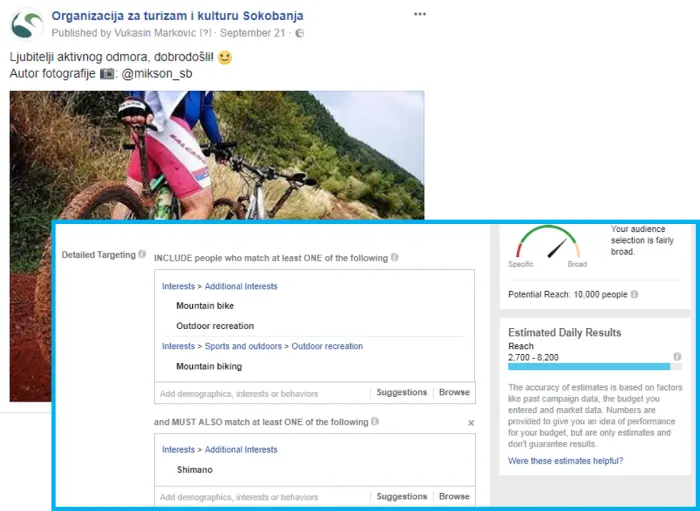
Free template for creating the Buyer Persona
If you have come to the end of this article it means that you have recognized the importance of creating a “Buyer Persona”.
That’s why we have prepared this template for you to help you create your “Buyer Persona” more easily for travel agencies, tour companies, travel destinations, hotels, apartments, restaurants, and other industry stakeholders.

Do the necessary research of the market, potential tourists and guests, and use this template to create your “Buyer Persona”!
Let’s mention once again that it is possible to create more than one “Buyer Persona”. Depending on how complex and heterogeneous your potential clients and guests are, you can create two, three or more “Buyers Personas” (we do not recommend more than five).
For example, for the marketing strategy of a hotel or apartment, two “Buyers Personas” could be created – one for the domestic, the other for the foreign guests, one for business, the other for leisure tourists or one for young couples, and the other for families with children.
Destination management organizations could also profile two “Buyer personas” the same way.
Travel agencies should make the segmentation for each package individually but also generally at the agency level.
Finally, we also note that just creating your “Buyer personas” does not guarantee great results.
Yes, in most cases it will help you achieve better marketing results, but it is necessary to say that there is no guarantee for it. However, much depends on the way you have explored and collected information about your potential tourists and guests, how you will execute the campaigns and on many other things.
One thing is certain – this method will allow you to customize your promotional messages to different market segments:
- You will show an ad to your business guests in which you will say that you have conference rooms, laundry services, photocopier and, excellent WiFi.
- You will show an ad to families with children in which you will emphasize that you have a playroom for children, a children’s menu in a restaurant, and an animator that will give parents the opportunity to have a few hours for themselves (because that’s what they secretly want).
Two completely different advertisements and one hotel. That’s personalization!
Get started from creating a “Buyer persona”, and if you need help, feel free to contact us .
Get This Free Template
Do You Want To Boost Your TRAVEL Business?
Drop us a line and keep in touch.
Personas in tourism
If you want to sell travel successfully, you have to know to whom. And whoever knows to whom also knows how, when, on which channels, with which images and with which wording.
One option for segmenting customers in tourism is offered by the Sinus Milieus, because they map well how much budget people in each milieu roughly have available and what they aspire to. But the Sinus Milieus are only a first step in the right direction. Various travel companies have created travel milieus based on their own studies, which they use to train their employees. Flight booking platform Amadeus, for example, divides tourists into six "Traveler Tribes" that are updated every 10 years. TUI has found that even people with the same background, wealth and age can have very different preferences, so it's taking it even smaller: in a large-scale study of 12,000 households, TUI developed 15 "travel lifestyle clusters" around 19 key vacation needs such as "enjoy," "spend time with family," "play sports" and many others. Based on such models, personas can be developed, for each of which there are then suitable travel offers and a sales channel.
The company that is ahead in this race for the best customer knowledge does not run the risk of losing touch with modern lifestyles and thus customers, as has happened to many travel companies with the advent of online bookings. Those who can accompany customers on their entire customer journey with precision not only win them over, but also keep them, because satisfied customers who feel they are being taken seriously will come back.
Not every travel company and travel agency needs to have and serve dozens of personas. It is enough if the employees know exactly who one specializes in and how to reach exactly these people. Management decides which customer groups promise the most success for the company and aligns the personas and thus the marketing, training and sales channels accordingly. Here we present four exemplary, data-based tourism personas who would like to travel - but may be approached differently about destinations and types of vacation:
Persona 1: Family vacation fun and relaxation
Julia is 40 years old, married and mother of two children, 7 and 5 years old. She lives in a single-family house in Aachen that she bought with her husband 5 years ago. Julia works part-time as a city planner, her husband is a mechanical engineer. The household net income of 105,000 euros is enough for a high standard of living with organic food, brand-name clothing and sustainable toys, but not for luxury due to the house purchase. Julia therefore saves wherever she can and only treats herself rarely, but then consciously. With her house, job and children, Julia is very busy and it is not easy for her to find enough time for herself. That's why the monthly evening with her study friends and the weekly badminton training are sacred to her. Julia pays attention to healthy eating, but still likes to feast and also turns a blind eye to the kids on special days. She likes to exercise and rides her bike to work whenever possible. Julia enjoys reading and is interested in history and decorating. On weekends, the family takes turns inviting friends over or being invited over, or spending time with grandparents and on family trips when the weather is nice.
Julia would therefore like to take a vacation where:
- she doesn't have to plan much, because she has neither the time nor the inclination to do so.
- the whole family has fun.
- she does not have to cook and shop.
- Relaxation and exercise should be balanced. A good night's sleep is also a must.
- she can do something alone with her husband at least once or twice
- a good portion of nature experiences are included.
- their children can ideally play with other children.
- a cultural experience is included, where the whole family can have fun and learn something.
- everyone can switch off from everyday life.
- the accommodation is close to nature and also close to various leisure attractions. Whether it is a hotel or a vacation apartment is not important, as long as there is enough space for the children and, in the case of the vacation apartment, restaurants are not too far away, because Julia does not want to cook on vacation. Julia is not actively looking for all-inclusive or club vacations, but if such an offer meets her criteria, she does not rule it out.
Julia has a Facebook and an Instagram profile and is moderately active on both. Passively, she consumes YouTube, but has not subscribed to any channels, and gets DIY tips on Pinterest. Email is more of a work tool for her than something she uses much in her personal life. The last time she was at a travel agency was in 1995 with her parents. Julia looks at accommodations on TripAdvisor and also consults the service when she wants to choose a new restaurant. She trusts the reviews there and has had good experiences with them so far. On Julia's cell phone, in addition to Spotify and Ebay Classifieds, are the apps from Die Zeit and Der Spiegel, which she uses to follow world events on the go. She found her current job on LinkedIn. When the kids are in bed and they both still have time and feel like it, Julia watches series on Netflix with her husband. Julia leaves the vacation planning to her husband, but gives him the criteria. She would also be willing to contact an online tour operator via email or contact form if she feels it will save her planning work. Julia takes vacation photos primarily for herself, and to send the best pictures to close family and selected friends via WhatsApp. She is also active on WhatsApp every day while on vacation. If Julia has time and feels like it after the trip, she might rate places, restaurants or accommodations on TripAdvisor.
Persona 2a: Individual adventure
Jan is 26 years old, single and has no children. He lives for rent in a two-room apartment in Dresden, where he works as a mechatronics engineer in a medium-sized company that is the world market leader in its field. Jan works shifts and therefore has time off at unusual times. With his 50,000 euros net income, he gets by well as a single man and can set aside quite a bit for travel and fun. He takes public transport to work and drives a Skoda in his spare time, but only uses it for further journeys, in the rain and for heavy shopping, otherwise he prefers to cycle. Jan divides his free time between his basketball club, meetings with friends and gaming. Once a month he spends a weekend with his parents in Radebeul. Jan eats a semi-healthy diet, which means he knows what is healthy and tries to pay attention to it, but appetite and pleasure often prevail. Jan stores wherever he happens to be, he goes to the supermarket as well as to the market or to the farm store if he happens to be there or if there is a special specialty. With two of his friends, he has been going on vacation together regularly for several years. The three of them meet beforehand to plan their long-distance trips over a barbecue on Jan's balcony.
The group's expectations for their vacation are:
- Fun and adventure feeling, the feeling of not being a mass tourist.
- Getting to know exotic, faraway places, while also enjoying contact with the local population.
- Taste local food.
- Experiences take precedence over relaxation, but the occasional chill out is a must.
- Trying something new, such as a new sport, a trip to a particularly remote or hip area, or a particularly different food.
- The accommodation can be a hip hostel, a lodge or an Airbnb with "family connection", the main thing is communicative and exciting. Budget is available, but Jan and his friends prefer to spend a large part on adventure tours and experiences rather than on luxurious accommodation. However, the accommodation should already have good ratings and wifi.
Jan is on Instagram, TikTok and Snapchat. For gaming, he uses an XBox. He uses WhatsApp in everyday life, subscribes to several YouTube channels and has a Spotify account. He does have a Facebook profile, but hasn't used it for years. Jan has never been to a travel agency; he uses Wikipedia, Google and TripAdvisor as well as Instagram to find out about potential destinations. After planning with his friends, he then books on Booking.com, Airbnb or, if it's cheaper and the website is good, directly with the lodge on site. Sometimes Jan and his group only pre-book part of the trip to give themselves room for spontaneity. They also book flights through Kaya.com, Fluege.de or directly with the airlines themselves. Jan takes a lot of photos of things and places (and especially himself with things and in places) that he finds special and posts them on Instagram during the trip.
Persona 2b:
Jan's sales colleague Anna is also 26 years old, single and has no children. She also rents a two-room apartment in Dresden. Anna has a lot of customer contact and often works overtime. Since she is unattached and wants to build up assets, she doesn't mind. With her net income of 55,000 euros, she gets by well as a single person and can put aside quite a bit for travel and fun. Anna uses the job ticket to get to work and otherwise mostly her Opel, only riding her bike when the weather is very nice. In her free time she likes to go out with friends, or go shopping or to festivals. Once a week she goes to Zumba. Anna likes to eat outside, paying attention to what she likes rather than where it comes from. If it's organic, fine, if not, no big deal. Anna likes to go on vacation with her clique, with fun and relaxation from work being her top priorities. Since Anna works a lot, she doesn't pay attention to money on vacation, but adapts to her friends if their budget is not so high. Generally, the clique tries to get maximum fun for an acceptable price.
- Fun and relaxation with sun guarantee.
- Contact with other tourists on the same wavelength for the purpose of joint ventures and celebrate.
- Exciting nightlife.
- New sports, as long as they promise action and fun without being too strenuous.
- The accommodation can be a very trendy hostel with half or full board, a medium sized trendy hotel or a chain hotel. A nice pool is a must. Airbnb is an option if the accommodation brings a big plus, like own pool, very central location in the middle of the action, very big size and/or very good price.
- Good ratings and wi-fi are also a must.
Like Jan, Anna is on Instagram, TikTok and Snapchat. She subscribes to a beauty channel on YouTube. She uses WhatsApp in everyday life. She has a Facebook profile, but hasn't used it for years. She leaves the booking to a friend because it reminds her too much of work, just like the travel planning. She listens to what the friends suggest, looks up the destination a bit on Instagram and Google, and then lets the group know what she thinks. Anna has also never been to a travel agency. Anna and her friends' trips are several short trips a year plus one trip of 1-2 weeks where they stay in the same place the whole time. Anna takes a lot of photos of herself on the beach or of the group while traveling and posts them on Instagram while still on the trip.
Persona 3: Culture and comfort
Gerd is 67 years old, married and the father of two adult children who now live in other regions. He has one grandchild of kindergarten age from each of his children so far. Since the children moved out, the electrical engineer has lived alone with his wife in their owner-occupied house in Münster. Gerd has been retired for a year. His wife has been a housewife since the children came along and has done voluntary social work on the side, which she continues to do. With a net household income of 45,000 euros from pensions and investments, Gerd and his wife are well off and can treat themselves to frequent vacations and short trips. They schedule the short trips on weekdays so as not to clash with the many weekend excursions. Gerd used to have to make many long, externally determined, tightly scheduled and stressful business trips. That's why he now attaches great importance to relaxation and enjoyment. Gerd has an affinity for education and tries to stay physically fit as long as possible in everyday life by riding his bike to run small errands, going for walks with his wife and playing tennis once a week. In the evenings, he watches the news and likes to listen to music afterwards over a good glass of wine - or he and his wife invite couple friends over. After often being separated and stressed during his professional life, Gerd and his wife now use the time to enjoy life together. They eat healthy and prefer organic when it's on sale, but are not active sustainability shoppers. Gerd drives an Audi A3.
Gerd would like on vacation:
- Enjoy good food and beautiful ambience.
- Take it easy.
- Travel to interesting places where he can visit and learn something.
- If possible, but not mandatory, attend a concert.
- If possible, either travel with friendly couples.
- Enjoy a little wellness.
- Have the opportunity for sports activity.
- Accommodation in the upscale segment should be cozy and have its own flair. Chain hotels are not Gerd's thing; he prefers boutique hotels or even larger houses, but with regional charm. Apartments are only considered if they offer a special plus, such as a particularly spectacular location.
Gerd is tech-savvy and interested. He does online banking and occasionally shops online, mostly electronics and stuff for the house, but no clothes. He has several messaging apps on his phone. Before traveling, he Googles the destination and also looks at recommendations on TripAdvisor, preferably on his PC. Since online travel portals have been around, he looks around there more and more often and has also booked the odd weekend trip that way. For a longer, more detailed trip, however, he still prefers to rely on personal advice from a travel agent. Gerd can't do anything with social networks and doesn't have any profiles there. He does, however, check Twitter from time to time and makes active use of WhatsApp for daily communication with his children and weekly video calls with his grandchildren. Every 2-3 months he sees his grandchildren over a long weekend or for the vacations and then enjoys actively doing things with them. Although he sometimes notices the age, e.g. when playing sports, Gerd feels more "experienced" than "old".
In our example, the fact that data-driven personas works better than target groups can be seen particularly well in the fact that Anna and Jan would fall into the same target group (young professionals with a completed education between 20 and 30 who live in an urban environment and earn between 50 and 55,000 euros), but display very different vacation behavior. You can reach them on the same platforms (TikTok, Instagram, Google Ads, billboards), but you can't lure them with the same travel offer, images and wording.
Julia and Gerd are very different and do not even belong to the same target group, but can be reached in part on similar channels that differ from Jan and Anna (TV commercials, advertising in news portals). However, both respond to a very different travel program, wording and other imagery. For this reason, data-driven personas is also the best option in tourism to efficiently address exactly the right customers for the right trip with little wastage.
This brings us full circle to the Traveller Tribes from Amadeus and Lifestyle Clusters mentioned at the beginning.
Practical examples: How TripAdvisor and Amadeus work with personas. The six "tribes" Amadeus works with are:
- Simplicity Searcher - Tourists with this profile want to have little work with travel planning, know what to expect and enjoy their time. They like personal advice and tend to go for package tours or organized tours.
- Cultural Purists are sophisticated, educated and interested in culture. They prefer things to be individual.
- Social Capital Seekers travel to be admired. They travel to as many destinations as possible and post their experiences on social media.
- Reward Hunter want to be pampered and have a good time and are happy to pay for it.
- Obligation meeters combine travel with work. On business trips, they add a day or two for private vacation, and on private trips, they sometimes take a business appointment. They are therefore inflexible.
- Ethical Travellers pay attention to sustainability - environmental and social - and are sensitive to the political and cultural conditions at their destination.
TripAdvisor also distinguishes six types of travelers: Utility-oriented travelers who have a limited budget and who therefore want to make the most of their vacation. They travel with children, especially to the seaside. They use their smartphone to search for special services such as kids' clubs, etc. Plus the self-identifying groups of Luxury Travel ers, Independent Travel ers and Habitual Travelers , who often return to the same place because they like it and that doesn't require planning. Social travel ers are found in groups of friends and families, including those with children, according to TripAdvisor, and rely on recommendations from TripAdvisor and word of mouth. Research-loving travelers often travel as couples and spend a lot of time planning to make sure everything is perfect.
If we now try to assign Julian, Jan, Anna and Gerd to an Amadeus-Tribe or a TripAdvisor- travel type, we realize that it is not that easy:
Julia could be described as a " SimpliCity Searcher " in the Amadeus scheme, but she doesn't want to be advised in detail, but prefers to travel. On TripAdvisor, this characteristic fits into the " Habitual Traveler " category, but Julia also has a fair amount of " Social Traveler " in her.
Jan falls between the opposing sounding categories of Ethical Traveller and Social Capital Seeker at Amadeus: He takes round trips and documents them in real time on social media, but is also very interested in the nature and culture of the host country. On TripAdvisor, he would most likely fall under "Independent Travelers." The fact that he travels with friends fits into the "Social Traveler" category, but he also likes to do research.
Anna is a Simplicity Searcher in the sense that she doesn't like a lot of planning and likes to sit in a feathered nest. But she's also a Social Capital Seeker because it's important to her to showcase her vacation on social media. On TripAdvisor, Anna would be a mix of "social" and "habitual."
Gerd is the easiest to classify, he is a Cultural Purist (Amadeus). On TripAdvisor he ranks between " research lover" and "luxury traveler" .
We could continue this exercise with countless other segmentations (Trendscope distinguishes seven travel types, Dertour likewise six, and anyone searching for travel types on the Internet is almost overwhelmed by the abundance of surveys, classifications, and studies) and yet none of our tourism personas would fit perfectly into one category. TUI, with its classification by travel needs and lifestyle clusters, is closer to reality. However, no travel agency, tour operator or online travel company can put in the kind of effort that TUI does. This is where the data-based tourism personas come in: They bring clarity to marketing, sales, and customer care on the basis of representative statistical data: It is much easier to sell Jan a trip via an online booking portal and lure him with suitable advertising on YouTube than it is to consider what a social individual traveler who fits into the group of "ethical travelers" and likes to present himself on Instagram will respond to.
You want to create your own data-based tourism persona? We are happy to help with the Persona Profiler or an extensive data collection on global tourism development.
More questions about personas?
Simply book a personal consultation appointment or send us your message:
Newest contributions
- Protected: MPDV - Target group - Update 4 2023 (Premium)
- Protected: MPDV – Target Audience – Update 4 2023 (Basic)
- Protected: GABOR Benchmark – Update 4 2023 (Basic)
- Protected: TENHIL - HR/Recruiting Manager - Update 4 2023 (Premium)
- Protected: TENHIL - HR/Recruiting Manager - Update 4 2023 (Basic)
Latest comments
- Persona Playbook - Persona Institute For graduates/students with a STEM focus in 2022 [BASIC] .
- Establish personas in the company: How does it work? - Persona Institute at data-driven personas
- Marketing automation with data-based personas - Persona Institute at data-driven personas
- News Personas - Persona Institute at data-driven personas
- Persona Playbook - Persona Institute at Candidate Persona: Graduates/Students with STEM focus [PREMIUM] .

- Purchase & Sale advisory
- Identification of off-market assets
- Operator Search
- Investment Partner Search
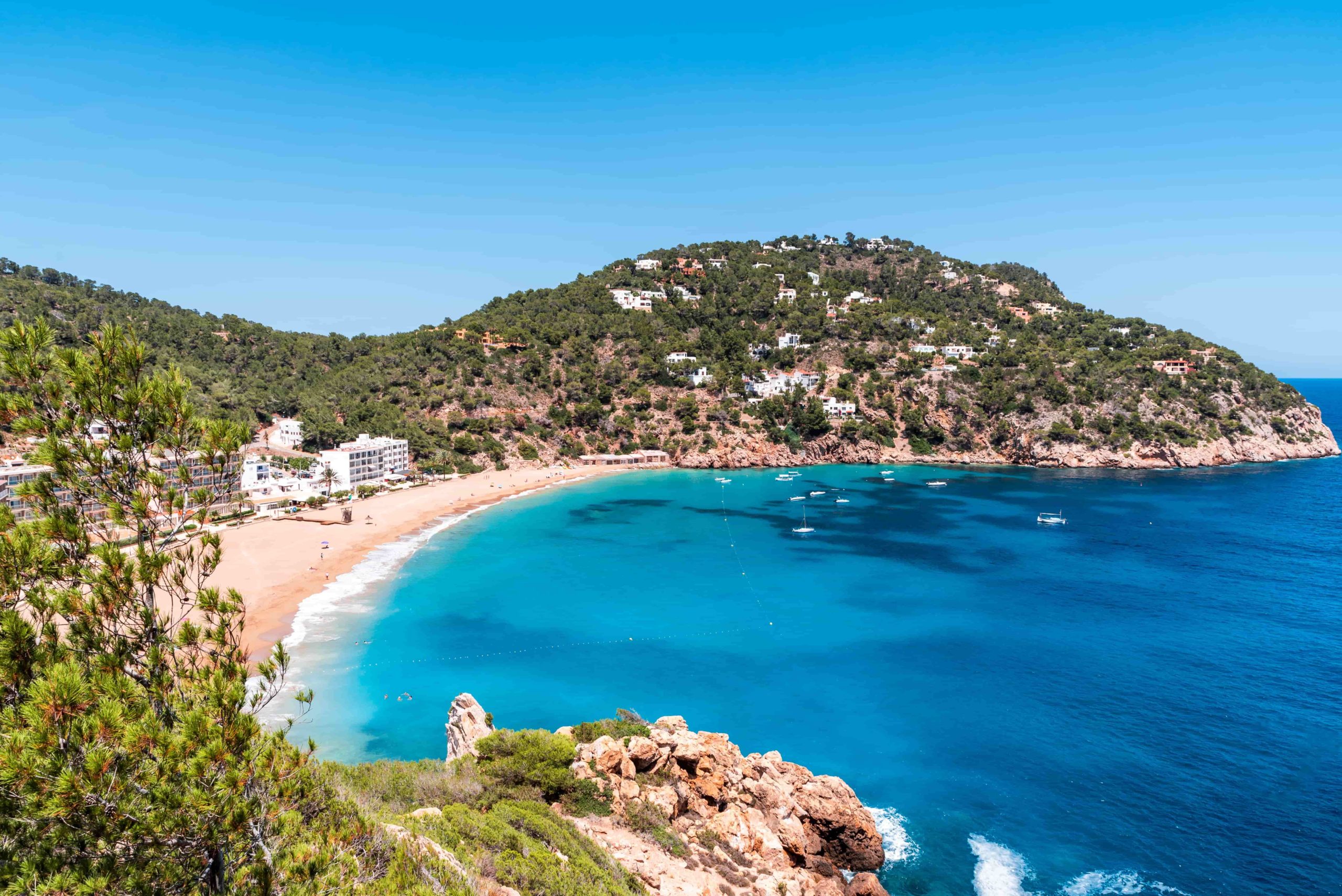
We advise you on asset purchase and sale processes and corporate operations in order to establish a solid base on which to establish decision-making.
- Conceptualization & repositioning of hotel projects
- Commercial and Marketing Strategy
- Market Insights & Data Services
- Operational Strategy
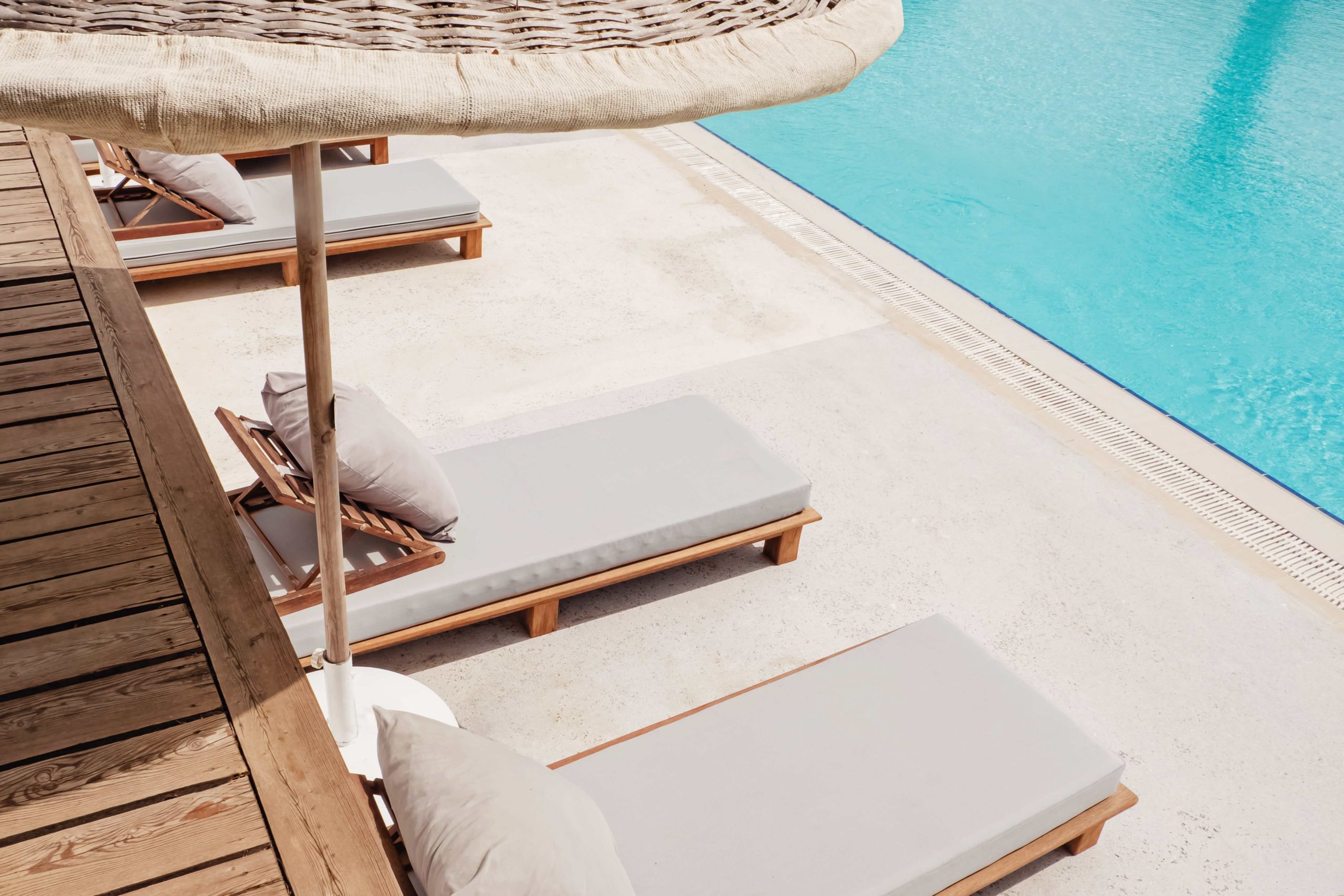
We assist your company in the definition of strategies in order to maximise the profitability of your asset. We bring key market information to facilitate solid decision making.
- Digital Transformation
- Digital Campaigns
- Marketing Plan Definition
- Direct Sales Strategic Plan
- Web Development
- Content Management

We comprehensively manage the marketing and digital needs of your company. We help increase your direct sales.
- Conceptualization of F&B offering
- Menu engineering
- Cost breakdown of menu items
- Production techniques
- Process Improvement
- Food Safety
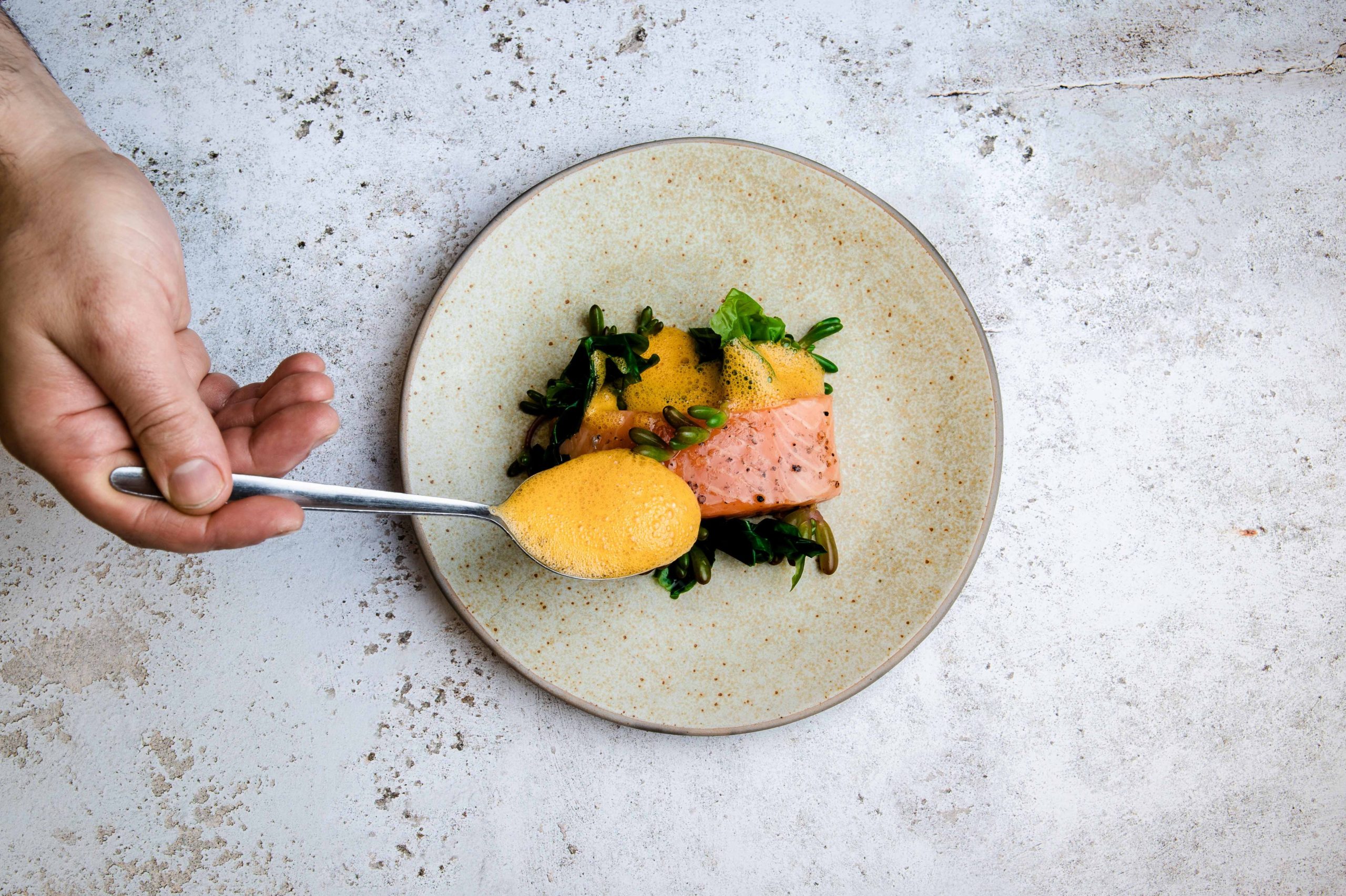
We advise and accompany you in the definition of strategies and implementation of processes to enhance the profitability of the F&B area.
- Success Stories
Uncategorized |
The new buyer persona in the hotel industry
17, Dec, 2019
By Marina Obrador Pozo
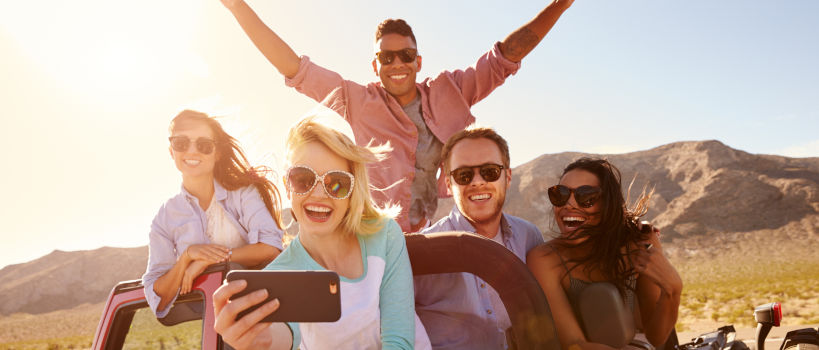
When a company has to decide the market segment to focus on, it is very important that the company is up to date with the latest news and trends that arise among the consumer groups.
In order to define our target audience, we should develop the buyer persona , that consists in conducting a detailed description of our potential client based on its demographic data , its behaviour and its motivations . In this way, it will be easier to know what they need and what they expect of our company to guide our actions and, thus, satisfy and surprise them.
In one of the latest projects that we developed at the hotel factory , we analyzed current different types of travellers and we divided them in three big groups: Business travellers, Leisure travellers and Long-stay travellers. In the first group, Business travellers , we find:
- Obligation Meeters
According to a study of Amadeus, within the branch of bleisure seekers (those who, although they travel mainly for work reasons, take advantage of any free time to discover the destination), are the Obligation Meeters. Their journey is due to a professional event. They are high-tech users, so they look for flexibility and the possibility of working remotely. When booking their trip, they prefer simple booking systems with flexible options of cross selling. Furthermore, it should be noted that they usually are loyal to a brand.

Connected Novice, which appears in an article published by AccorHotels, are men and women between 22 and 44 years old, that travel from 3 to 7 times a year. They also belong to the bleisure branch, with the particularity that they extend their stay to discover the destination. Moreover, they plan their trip through their smartphone and share their experiences on social networks.
- Digital Nomads
A study made by Horwath HTL, identifies the Digital Nomads’ profile as people that work remotely by using technology from anywhere. For this reason, they need coworking spaces at the hotel where they stay. Furthermore, they choose hotels that organise events to favour the socialization of guests and locals and which have a wide range of F&B, with the possibility of contracting full board. They also value facilities such as gym, shared kitchen, game room, cinema or library.
In the second group, Leisure travellers , we discovered very different profiles:
According to an article written by TecnoHotel, the cultural traveller has the intention of discovering new cultures, from heritage to gastronomy. It is a segment formed mostly by men with a high level of education, concerned about the environment and sustainability.
However, it is interesting to note that cultural traveller is fond of specialised blogs. These travellers are used to traveling alone and booking directly with the company after comparing prices. Furthermore, they prefer booking independent services, they have a higher budget and stay longer than the average.

- Hyper connected
The same TecnoHotel’s article mentioned before defines the hyper connected traveller as one that wants to know new places, with an extremely digital profile and is up to date with the latest trends. This group is formed mostly by men with a medium level of education, who want to keep their healthy lifestyle during their holidays.
This type of traveller prefers brands that provide an exclusive and personalised service. Moreover, it is very active on social networks, where they share their day to day and trips. As the cultural traveller, the hyper connected traveller travels alone and uses price comparison sites. Nevertheless, they book in advance and chooses dynamic packages. Regarding their hotel preferences, this traveller values that payment is made easy and exclusive service & products.
- Millennial travellers
After reading several reports written by Destination Analysts, Expedia and Travel Bulletin, we have concluded the following. Millennials are mainly women from 21 to 36 years old that travel for leisure around 4 or 5 times a year with their parents, friends, alone or with their partner.
The reasons that motivate them to travel are reducing stress and living exciting experiences, especially if they can share them on social media.
Millennials are, by definition, sociable. so they want to mix and live experiences with locals. In addition, it’s a group that has a preference for companies with responsible and sustainable values. Furthermore, they are willing to pay for wellness and fitness services the hotel may offer.

- LOHAS ( Lifestyle of Health and Sustainability)
Several articles written by Cognodata, Life Time and the Danube Competence Center analyse the features of this type of travellers. The LOHAS characterized by choosing a sustainable lifestyle based on health and care of the environment. They also define themselves as Tech savvys, that is, they use technology and their smartphones in all phases of their holiday.
Their purchasing power is high and they travel alone or accompanied by their friends or couple. The length of their stay is short and they look for cultural experiences and destinations that offer programs that help keep the psychophysical balance. Furthermore, they value hotels that offer organic food, natural products and nutritional supplements.
Finally, our last group of travellers: Long-stay travellers , those who search for an accommodation that offers enough amenities and shared services that favour a long stay (minimum 6 days). The reasons that justify their journey are professional, need for medical treatment or temporary accommodation during the refurbishment of their home. They may also be students that are looking for accommodation. According to an article in The Economic Times, these travellers prefer hotels with complete facilities that make them feel at home and with a wide and personalised offer of F&B.
Finally, after analysing all these profiles, we discovered that there is a generalised trend in keeping a healthy lifestyle while travelling, both in their workout routine and in their eating habits. Moreover, we believe that travellers increasingly value companies that are responsible with the environment.
As we mentioned at the beginning of this post, knowing needs and preferences of potential clients and, thus, developing the buyer persona , is crucial for companies that look for updating the concept of their hotels, especially when there are more and more segments that demand specific services. At the hotel factory , we are up to date with the news and changes that arise everyday in the hotel industry and, for this reason, we can assess our clients in the development of their buyer persona . In addition, we have an extensive experience in hotel conceptualization and transformation, so we can advise in the development of new concepts, from smart investment to complete repositioning.
- Jump to main content (accesskey s)
- Jump to site navigation
- Jump to site index (accesskey 3)
- Jump to accessibility statement (accesskey 0)
- Book a room
Share price 8002.00 p 25 April 2024 at 16:39
Quick links
- Download IHG Annual Report 2022 PDF 12.12MB
- Our strategy
- How our business works
- Our global presence
- Human rights PDF 85KB
- IHG Careers
Top results
News releases
24 April 2024
IHG’s Upper Luxury Portfolio Recognized By Top Travel Editors
Nine top titles awarded to IHG properties – A total of four Six Senses and two Regent hotels are featured in Condé Nast Traveler Hot List, Travel + Leisure’s It List and AFAR’s Best New Hotels.

24 APRIL 2024, LONDON: IHG Hotels & Resorts is celebrating the significant achievements of its upper luxury portfolio today following the announcement of three of the industry’s most coveted awards selected by leading travel editors. A collective showcase of the crème de la crème of the global hospitality industry, Condé Nast Traveler Hot List , AFAR’s Best New Hotels of 2024 and the Travel + Leisure ‘It List’ have awarded nine notable titles to properties within IHG’s Luxury & Lifestyle portfolio, now the second largest in the world.
A summary of the inclusions are as follows:
Since 2015, IHG Hotels & Resorts has doubled its Luxury & Lifestyle portfolio to become recognised as one of the industry’s most innovative players. Strategic acquisitions and new brand launches over the past five years have transformed IHG’s portfolio from 1 to 6 brands, spanning 499 properties and some 114,570 rooms in 80 countries. IHG is now the second largest in the sector by number of rooms and hotels, whilst continuing to drive high-value growth at an impressive pace.
Since its acquisition in 2018, IHG has embarked on a carefully curated reimagining of Regent to reclaim its place in the hearts of the modern luxury travellers. A legendary innovative luxury brand since 1971, Regent reimagines modern hospitality by sparking fresh perspectives across its growing number of hand-selected hotels and resorts. Several flagship openings in 2023 ushered in a new era for the brand with the grand return of Carlton Cannes, a Regent Hotel in March following a two-year redevelopment, closely followed by Regent Hong Kong’s return to Victoria Harbour in June that year. Both properties received recognition within this year’s awards announcement.
Six Senses is world-renowned for providing the ultimate luxury wellness and sustainable experience. The brand is experiencing exciting growth with some 42 hotels in the pipeline which will almost double today’s existing portfolio. Part of IHG since 2019, last year saw the opening of Six Senses Rome, its first urban expression of the brand and Six Senses Crans-Montana and Six Senses Southern Dunes. All three properties proudly receive recognition by the top global editors overseeing this year’s lists.
The spotlight now turns to the 37 th annual Condé Nast Traveler Readers’ Choice Awards with more than 200 IHG properties shortlisted and gathering votes. The longest running recognition in the travel industry, Condé Nast Traveler’s Readers’ Choice Awards is voted for by global readers of the magazine worldwide. To vote, visit: UK voting site | US voting site .
For further information please contact:
Ellie Mainwaring Global Senior Communications Manager Luxury & Lifestyle Brands [email protected] +44 (0) 7823 372 559
About IHG ®
IHG Hotels & Resorts [LON:IHG, NYSE:IHG (ADRs)] is a global hospitality company, with a purpose to provide True Hospitality for Good.
With a family of 19 hotel brands and IHG One Rewards , one of the world's largest hotel loyalty programmes, IHG has over 6,300 open hotels in more than 100 countries, and a development pipeline of over 2,000 properties.
- Luxury & Lifestyle: Six Senses Hotels Resorts Spas , Regent Hotels & Resorts , InterContinental Hotels & Resorts , Vignette Collection , Kimpton Hotels & Restaurants , Hotel Indigo
- Premium: voco hotels , HUALUXE Hotels & Resorts , Crowne Plaza Hotels & Resorts , EVEN Hotels
- Essentials: Holiday Inn Express , Holiday Inn Hotels & Resorts , Garner hotels , avid hotels
- Suites: Atwell Suites , Staybridge Suites , Holiday Inn Club Vacations , Candlewood Suites
- Exclusive Partners: Iberostar Beachfront Resorts
InterContinental Hotels Group PLC is the Group's holding company and is incorporated and registered in England and Wales. Approximately 345,000 people work across IHG's hotels and corporate offices globally.
Visit us online for more about our hotels and reservations and IHG One Rewards . To download the IHG One Rewards app, visit the Apple App or Google Play stores.
For our latest news, visit our Newsroom and follow us on LinkedIn .

More From Forbes
The 10 best hotels in the world, according to tripadvisor travelers’ choice awards.
- Share to Facebook
- Share to Twitter
- Share to Linkedin
Winner of the number one hotel in the world is Hotel Colline de France located in the mountains of ... [+] Brazil.
Travelers from around the world have decided on their favorite hotels for 2024, and Tripadvisor has unveiled the final results of winners for its annual Travelers’ Choice Best of the Best Hotels Awards . The awards celebrate this year’s highest-rated hotels based on Tripadvisor reviews.
Deep in the heart of Brazil is the number one hotel, Hotel Colline de France . This French-inspired, 34-suite boutique hotel is located in the mountain town of Gramado. The property has the most 5-star reviews of any other listing on the site. Many travelers note the service and attention “I was greeted with warm smiles and impeccable service,” says one 5-star reviewer, another says, “This is a fairy tale not a hotel. Elegant, charming and everything is close to perfection.”
The Shore Hotel is the No. 1 hotel in the United States. The eco-friendly boutique property is located in Santa Monica, Calif., and offers stunning ocean views. Guests love the contemporary property and the personal attention from the staff. Reviewers are enthusiastic about the property saying, “By far the best service we have had at a hotel,” and “The staff pampered us and made sure every minute of our stay was handled with care.”
Shore Hotel in Santa Monica, Cailfornia ranks as the number one hotel in the United States
While travelers are often very opinionated on their favorite properties, it is essential to note that most of the winning hotels this year highlight enhanced customer service and staff that go out of their way to impress their guests. The range of properties is extensive, with Vietnam, Maldives, and Mexico leading the pack with two properties each. In the U.S., New York City and San Antonio, Texas, have the most star-reviewed hotels. Some hotels are all-inclusive and family-friendly, while others are purely for adults-only.
The Best Romantic Comedy Of The Last Year Just Hit Netflix
Apple iphone 16 unique all new design promised in new report, rudy giuliani and mark meadows indicted in arizona fake electors case.
“According to our Tripadvisor reviewers – each of the world’s best hotels caters to the traveler looking for accessible luxury and unique, tailored experiences,” said Dan Mitchell, Vice President & General Manager of Hotels, Tripadvisor.
Hotel Colline de France in Brazil
Here are the Best of the Best Hotels in the World for 2024 as selected by Tripadvisor readers.
1. Hotel Colline de France - Gramado, Brazil
Winner for three years in a row, this 34-suite property is a European Castle full of charm, elegance, personality, and top-notch service in a very unlikely location. With its sophistication worthy of royalty, you will feel like you are in the French Empire at this property.
Oblu Select Lobigili in the Maldives
2. OBLU SELECT Lobigili - Malé, Maldives
Located just a few minutes from Malé International Airport, Lobigili is an adults-only contemporary resort. Positioned along a turquoise lagoon, it has 68 specially designed villas, including overwater and pool villas.
La Siesta Hoi An Resort & Spa in Vietnam
3. La Siesta Hoi An Resort & Spa - Hoi An, Vietnam
Surrounded by green rice fields and small villages adjoining the Thu Bon River, the resort offers a wide selection of guestrooms, suites, and duplexes across three wings—a classical hotel style and two wings of townhouse villas with verandas, terraces, and balconies. Three wings come with four pools – one for children, a freshwater pool, a saltwater one, plus an infinity pool ‘merging’ with the rice fields
Adiwana Suweta in Bali
4. Adiwana Suweta - Bali, Indonesia
Located in a quiet haven in Ubud, the property offers spacious suites and private pool villas facing the lush green jungle. This 36-room modern property is a tranquil escape from city life, located near the heart of the city, near the famous Ubud Palace.
IBEROSTAR Grand Hotel Packard in Havana, Cuba
5. Iberostar Grand Packard - La Habana, Cuba
This 5-star hotel is located on the famed Paseo del Prado, next to iconic buildings like the Velasco Palace and the National Capitol. The 321-room modern hotel offers three floors inspired by 1950s cars, while a large infinity pool dominates the skyline.
Emerald Maldives Resort & Spa
6. Emerald Maldives Resort & Spa - Fasmendhoo Island, Maldives
Located on the Raa Atoll, in the northern part of the Maldives archipelago, this DAll-Inclusive Resort is surrounded by soft white sand on a private island. It features 120 villas, 60 located on the island and 60 directly on the sea.
Rooftop Moonlight Sky Bar at La Siesta Classic May May
7. La Siesta Classic Ma May - Hanoi, Vietnam
This property is located in the heart of the Old Quarter near Hoan Kiem Lake and has 75 unique guest rooms and suites. The popular Moonlight Sky Bar on the rooftop offers dramatic views of the bustling city.
Secrets Akumal Riviera Maya
8. Secrets Akumal Riviera Maya - Akumal, Mexico
This popular adults-only resort is located in the heart of the Riviera Maya along the famed white-sand Akumal beach. There are 434 suites, many with ocean views and a private plunge pool.
Padma Resort Ubud in Bali
9. Padma Resort Ubud - Bali, Indonesia
This 149-room resort is a dramatic luxury destination located north of Ubud. It overlooks a raw river valley and the forests of Payangan. The property offers stunning views from every room or suite, a first-class spa, and a stunning infinity swimming pool.
Opera Suite at the Sofitel Mexico City Reforma
10. Sofitel Mexico City Reforma - Mexico City, Mexico
Located on the historic Reforma Avenue, this French-inspired property offers dramatic views of the capital. It has 275 guest rooms, 56 of which are luxury modern suites. The property also offers five bars and restaurants, the stunning 38th-floor Cityzen restaurant, and a 40th-floor ballroom.
The 10 best hotels in the United States selected by Tripadvisor readers range from boutiques to super luxury offerings.
1. Shore Hotel - Santa Monica, Calif.
2. Luma Hotel Times Square - New York City, N.Y.
3. FivePine Lodge & Spa - Sisters, Ore.
4. The Bryant Park Hotel - New York City, N.Y.
Hotel Emma in San Antonio, Texas is winner of the Best Luxury Hotel in the US
5. Hotel Emma - San Antonio, Texas (Also the winner of Best Luxury Hotel)
6. The Loutrel - Charleston, S.C.
7. Lotte Hotel Seattle - Seattle, Wash.
8. Four Seasons Hotel Chicago - Chicago, IL
9. Ironworks Hotel Indy - Indianapolis, Ind.
10. San Antonio Marriott Rivercenter on the Riverwalk - San Antonio, Texas

- Editorial Standards
- Reprints & Permissions
The hottest hotel rooms right now are tents and RVs. Here's why big chains are all in on 'glamping'
- Hotel giants Hilton and Hyatt are growing their luxury camping portfolios.
- Both are adding glamping resorts to their booking channels, where their members can earn and redeem points.
- Interest in high-end camping has remained strong since its boom during the COVID-19 pandemic.

Forget high-rise hotels and all-inclusive beachfront resorts — the world's most popular hotel companies see a future in luxury tents.
If it seems like a third of your friends are going "glamping" these days — a portmanteau of glamorous and camping — you'd be correct. Luxury and traditional camping comprised 32% of all vacations in 2022, with more than 10 million households going on a glamping trip that year, according to campground giant Kampgrounds of America, or KOA.
Over the last few years, scores of boutique luxury camping properties have popped up around the US to meet growing demand, from Getaway's Instagram-famous matte black tiny cabins to RV-rental platform Outdoorsy's growing portfolio of luxury canvas tent resorts.
Now, hotel giants want a slice of the high-end camping pie.
Hilton and Hyatt are getting into glamping
Hilton and Hyatt have both recently announced partnerships and properties to expand their glamping portfolios.
Earlier this year, the former said its members could soon earn and use Hilton Honors points to book AutoCamp's chain of luxury campgrounds.
Related stories
The brand's resorts are best known for their stationary Airstream trailers turned hotel rooms , although they also offer "traditional" glamping accommodations like tiny homes and high-end canvas tents with beds.
It's Hilton's first move into the glamping industry. And it's starting with a pretty successful partner.
Like other glamping and camping properties, AutoCamp saw a boom in bookings during the COVID-19 pandemic as travelers shunned cruises, planes, and traditional hotels for road trips and the great outdoors (remember that?).
The glamping company has grown quickly: Four of its seven resorts launched after 2021, and two more locations are now underway.
Hilton hasn't disclosed how many points travelers need for an AutoCamp reservation or when they'll become available. Still, the glamping company isn't known to be as affordable as camping. In the summer, a weekend stay can range from about $300 to $670 a night.
For its part, Hyatt has taken the same approach as its opponent.
On Wednesday, the competing hotel giant announced World of Hyatt members can now earn and spend points at more than 700 of high-end hotel brand Mr and Mrs Smith's properties. This includes five of its 17 glamping resorts, like a bed under the stars in India's Pench National Park, and a thatched-roofed hut in Sri Lanka's Yala National Park.
Hyatt plans to add more Mr and Mrs Smith properties to its World of Hyatt collection every quarter. No word yet on whether it will include the high-end hotel brand's 12 other luxury camping resorts.
But if you think AutoCamp's Airstreams can get expensive, wait until you see Mr and Mrs Smith's glamping accommodations. The most expensive of the five — all-inclusive cabins in Dunton, Colorado — starts at $2,855 per night. The huts in Sri Lanka are, at their cheapest , $724 a night.
But the addition of these glamping resorts to its booking channels isn't Hyatt's first venture into glamping. The company's Alila Ventana Big Sur hotel in California also offers high-end canvas tents alongside conventional hotel rooms.
Hyatt is now using the same model to launch an adult-only expansion of its all-inclusive Dreams Curaçao resort, set to open in June. Alongside the Caribbean property's existing traditional hotel, Hyatt plans to deploy modular tiny-home-sized hotel room units directly on the beach.
Glamping could be a great investment for these hospitality giants.
Glamping was one of the biggest travel trends from the COVID-19 pandemic, and interest has yet to fade. In 2023, KOA called the industry an "aggressive growth segment," with four in 10 campers expressing interest in glamping that year.
According to the campground giant, compared to traditional campers and hotel guests, "glampers" spend more money daily at glamping properties and their surrounding areas — music to Hilton and Hyatt's ears.
Watch: Marriott International's Tina Edmundson tells Insider that the travel mindset has changed since the pandemic
- Main content
12 Travel Garment Bags to Look Good Everywhere
Be wrinkle-free everywhere you go
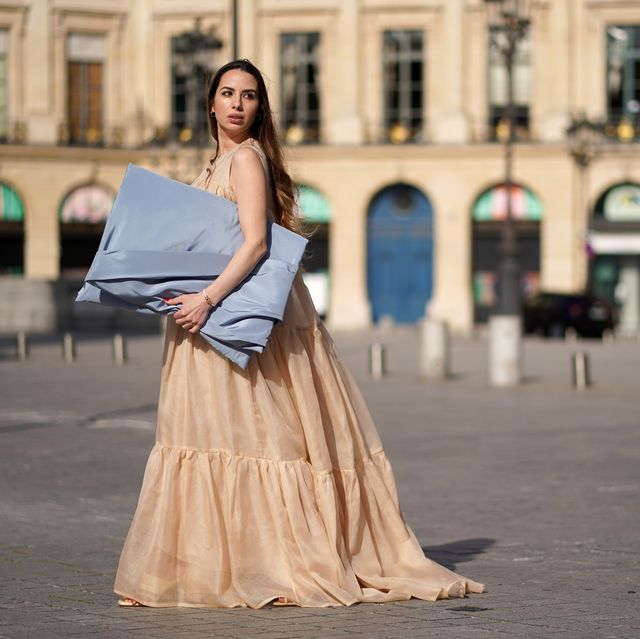
Every product on this page was chosen by a Harper's BAZAAR editor. We may earn commission on some of the items you choose to buy.
But choosing the best travel garment bag for your needs can be a challenge. There are a lot of options on the market, so we asked an expert about how to find the right one. According to Tumi creative director Victor Sanz, “Your garment bag should be sturdy, functional, and sleek. If you’re frequently traveling by plane, a garment bag that folds to fit carry-on requirements is essential.” He adds, “You want to find the size that will fit all your clothes without having to overfold them and will allow you to reach your destination in style.”

Best Quilted Garment Bag
Mz wallace michael garment bag.
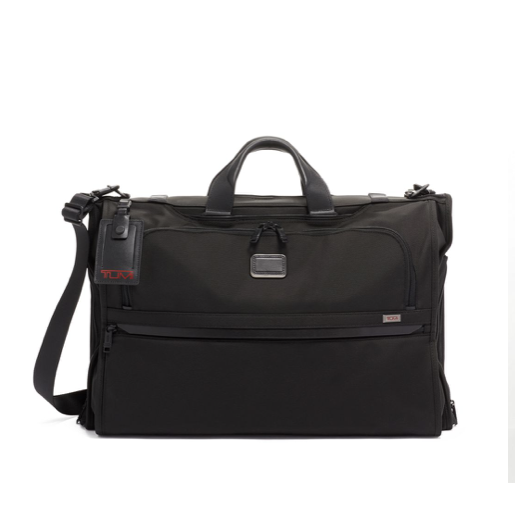
Best Luxury Garment Bag
Tumi alpha garment bag trifold carry-on.
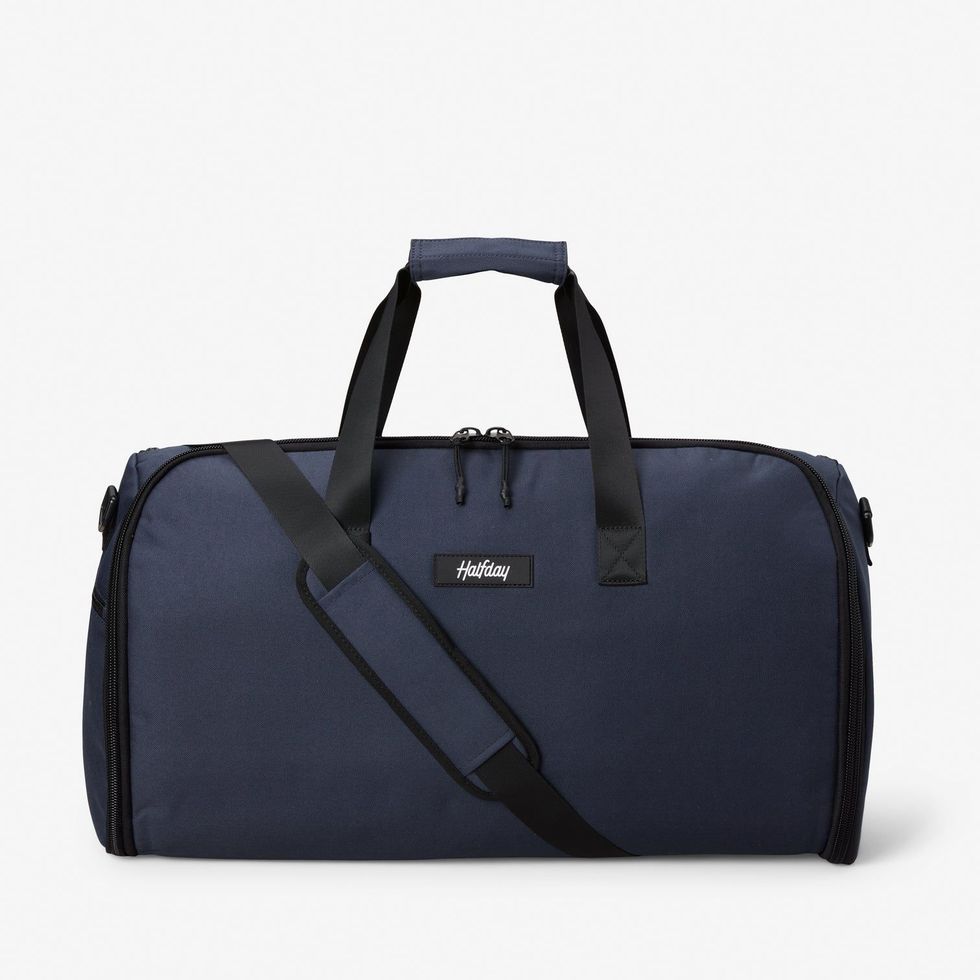
Best Garment Duffel
Halfday the garment duffel.
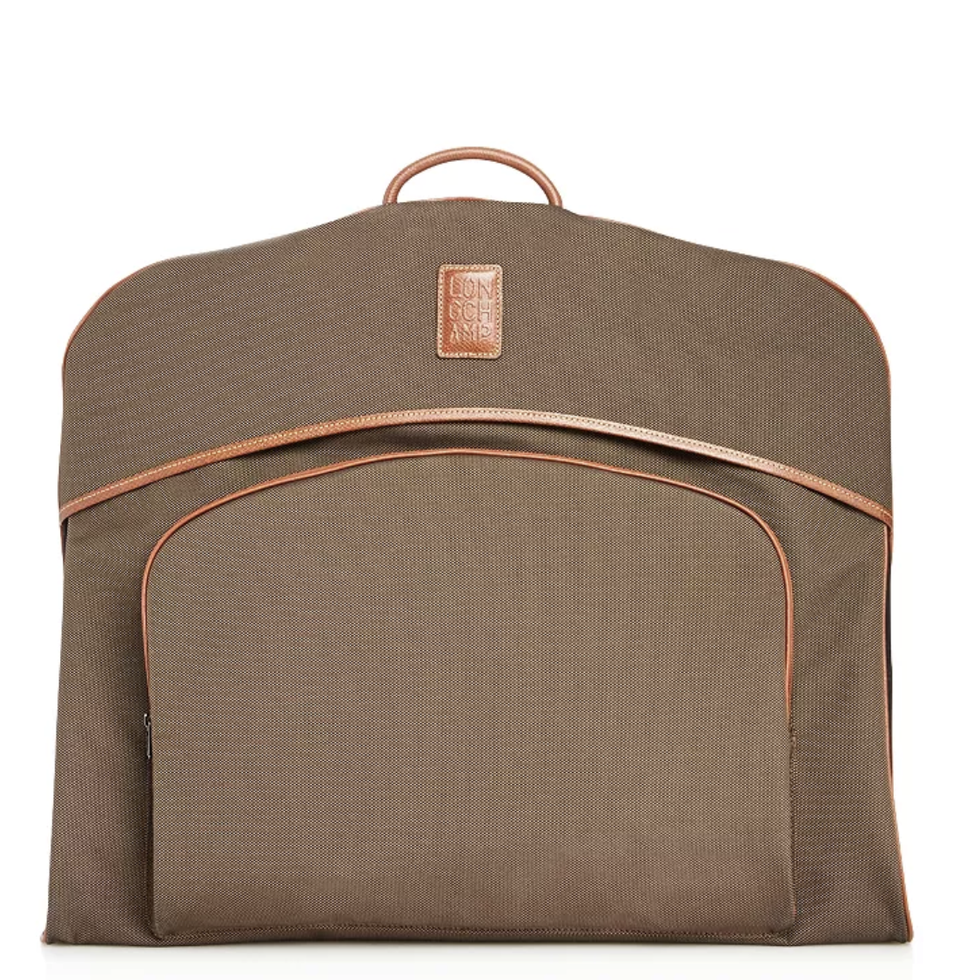
Best Timeless Garment Bag
Longchamp boxford garment bag.
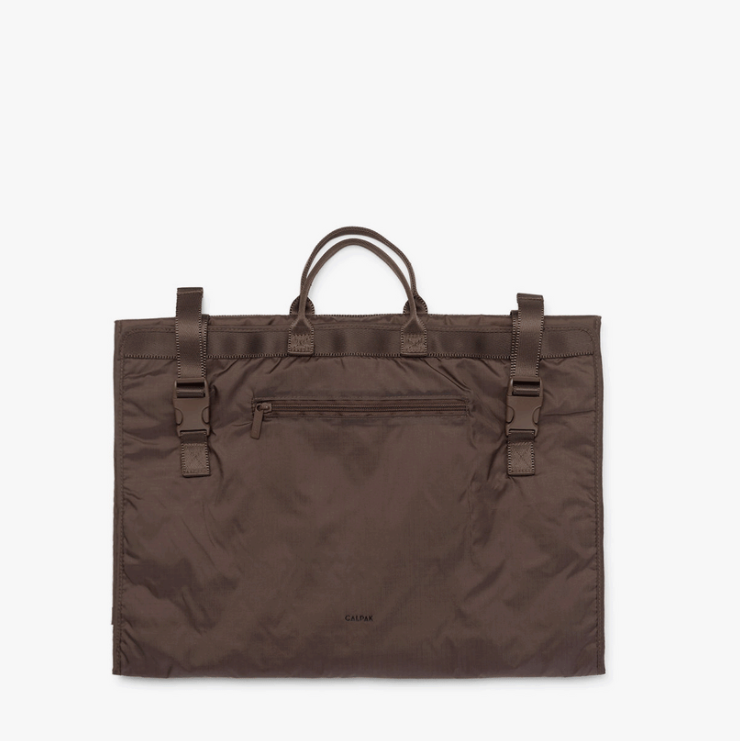
Best Packable Garment Bag
Calpak packable garment bag.
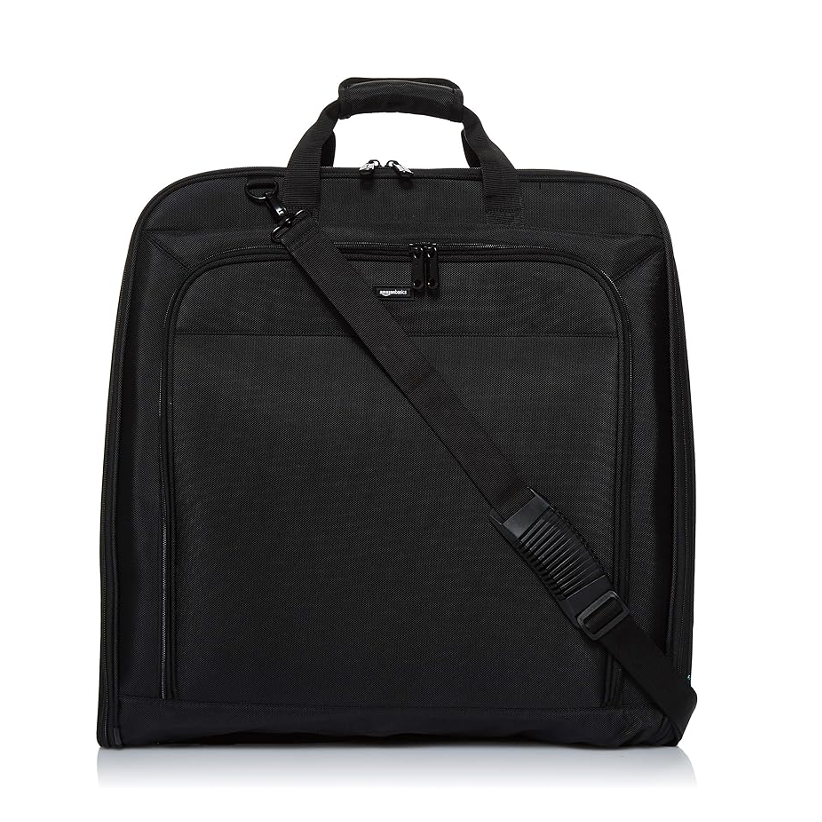
Best Affordable Garment Bag
Amazon basics premium garment bag.
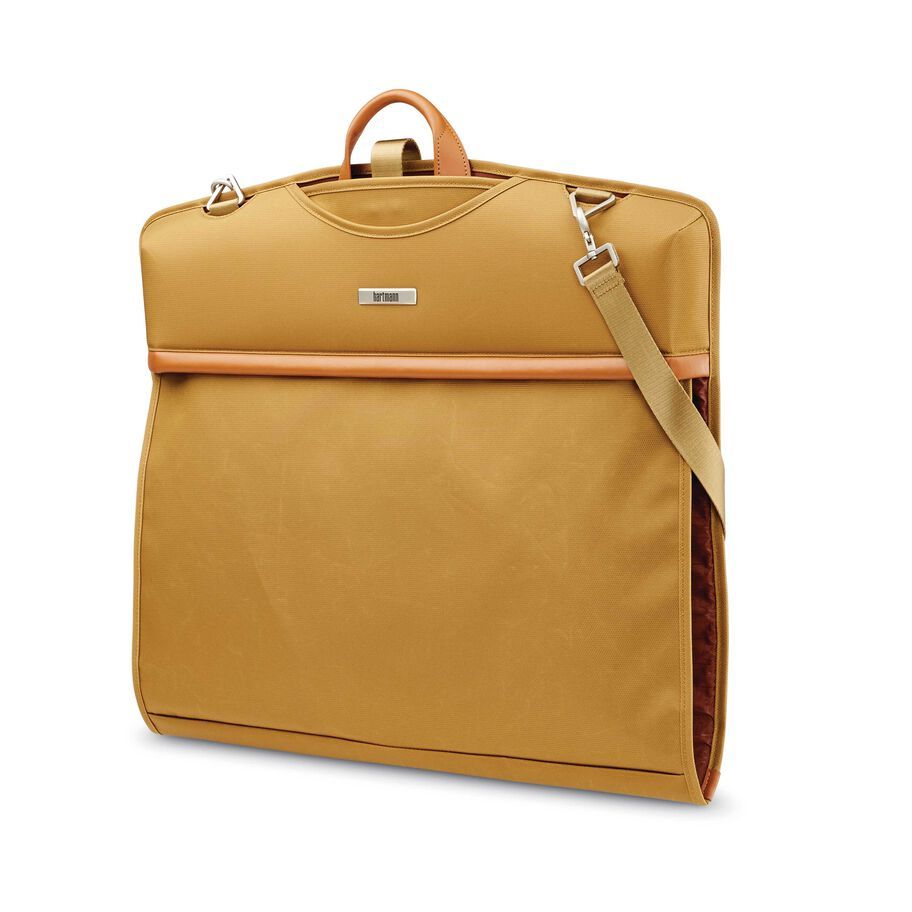
Best Durable Garment Bag
Hartmann metropolitan two-garment sleeve.

Best Personalized Garment Bag
Mark & graham commuter 2-in-1 garment bag.

Best Expandable Garment Bag
Samsonite ascella 3.0 softside expandable luggage.

Best Water-Resistant Garment Bag
Stitch ultimate garment bag.
It’s also important to consider bonus features, like pockets and organizational compartments, and, as Sanz notes, “A crucial function is to ensure that you’re able to hang your garment bag when you arrive at your destination, so that you can prepare your outfits as easily as possible and to ensure that all your clothes are crisp.” Keeping all this in mind, we found the 12 best travel garment bags out there today. Once you start using one of these, you’re never going to go back.
MZ Wallace’s signature quilting isn’t limited to the brand’s totes, appearing here in garment bag form. The thin design is extremely lightweight, ideal for quick trips when you need to bring one to three outfits. There is even an exterior pocket for bonus storage.
Dimensions: 22" × 3" × 39"
Materials: Oxford, leather
What reviewers are saying: “I have been interested in a MZ Wallace garment bag for a while. It is perfect! Just right proportions and size. Thoughtful design and construction details.”
Tumi always delivers premium luggage that will last you over a decade, and this garment bag is no exception. Sanz says: “It’s foldable, with a sturdy handle for easy carrying, making it convenient and compact for every type of travel. I also love that it has several zipper pockets, so I can pack my toiletries and other travel essentials all in one bag. When I arrive at my destination, I hang it in the closet and I know that I will be ready to go.”
Dimensions: 15" x 22" x 6"
Materials: Ballistic nylon
What reviewers are saying: “This bag stores so much for a carry on. I was able to comfortably fit 2 suits and more for a destination wedding!”
This duffel has been receiving high praise ever since its release. A few of the reasons it’s so popular: The duffel is carry-on friendly, water-resistant, and has interior and exterior pockets. And those are only a few of its distinguishing features. Choose an original or compact size for the style that suits your needs.
Dimensions: 22" x 12" x 12"
Materials: Polyester
What reviewers are saying: “The Garment Duffel is a great purchase, especially for anyone in an industry that takes short frequent trips. I was actually able fit quite a bit more clothes than I had anticipated. Took the bag to work and my company bought 20 of them to give to customers. Great purchase.”
Longchamp’s iconic nylon and leather trim takes on a garment bag silhouette. The two-tone design exudes sophistication, with practical touches like a top carry handle, built-in hanger, and front zip pocket.
Dimensions: 23.25" x 41.25"
Materials: Nylon, leather
What reviewers are saying: “I bought this as a gift for my boyfriend who travels a lot and needed a nice garment bag particularly for his suits. This bag is perfect! It fits his suit as well as a few extra shirts. The fabric is an amazing, durable quality, and the leather details make this product look incredible.”
This garment bag is actually designed to fit inside of your carry-on, rather than serving as a stand-alone piece. The water-resistant exterior protects against spills, and exterior zip pockets hold small accessories. It gets the job done, while taking up the least possible amount of space.
Dimensions: 40" x 19"
What reviewers are saying: “I use this bag when I need to workout at work. I go from a suit to athleticwear in minutes.”
Looking for an affordable option that is available ASAP? Amazon’s garment bag holds up to three suits or dresses and boasts multiple zipper compartments.
Dimensions: 40" x 4" x 20.5"
What reviewers are saying: “I bought this bag in 2019 and it has held up incredibly well since then, performs all functions advertised at a great price value. I have taken it on many flights, buses and train rides and have never had an issue with fitting it in the overhead bin on both longer-haul flights and short budget-airline carriers.”
Hartmann’s garment bag adds contemporary touches to an otherwise traditional design. The result? A chic, useful travel accessory that will stand the test of time. The padded shoulder strap and multiple interior pockets enhance the convenience of this style.
Materials: Nylon
What reviewers are saying: “Hartmann was an anniversary gift from my work place, and I am still proud to own it 35 years later.”
Mark & Graham Commuter 2-in-1 Garment Bag
Another convertible duffel, but this time with a personalized touch. That’s right—Mark & Graham lets you monogram your duffel. With a plethora of zippered and snap interior and exterior pockets, this bag gets creative with its storage solutions.
Dimensions: 22" x 10" x 10"
This spinner-style garment bag makes navigating a chaotic airport easy. The ergonomic design has expandable capabilities, as well as various compartments, a hanger bracket, and a pocket for liquids.
Dimensions: 20.5" x 24" x 9.5"
What reviewers are saying: “It’s easy to maneuver and overall great quality and very neat design (many compartments and zippered areas).”
For golfers and non-golfers alike, Stitch makes a duffel that is water- and stain-resistant, and includes a hanger hook, shoulder strap, elastic shoe pockets, and webbed handles. You can even get it customized with your initials.
Dimensions: 22.5" x 11.5" x 12"
What reviewers are saying: “Love it! Fits into the airplane overhead bin, no trouble bringing it along as a carry-on bag. Very sturdy, zippers are tough enough. Shoulder strap is removable. My suit arrived in top shape using this garment bag. Highly recommended.”
Ralph Lauren Leather-Trim Hybrid Garment Duffel
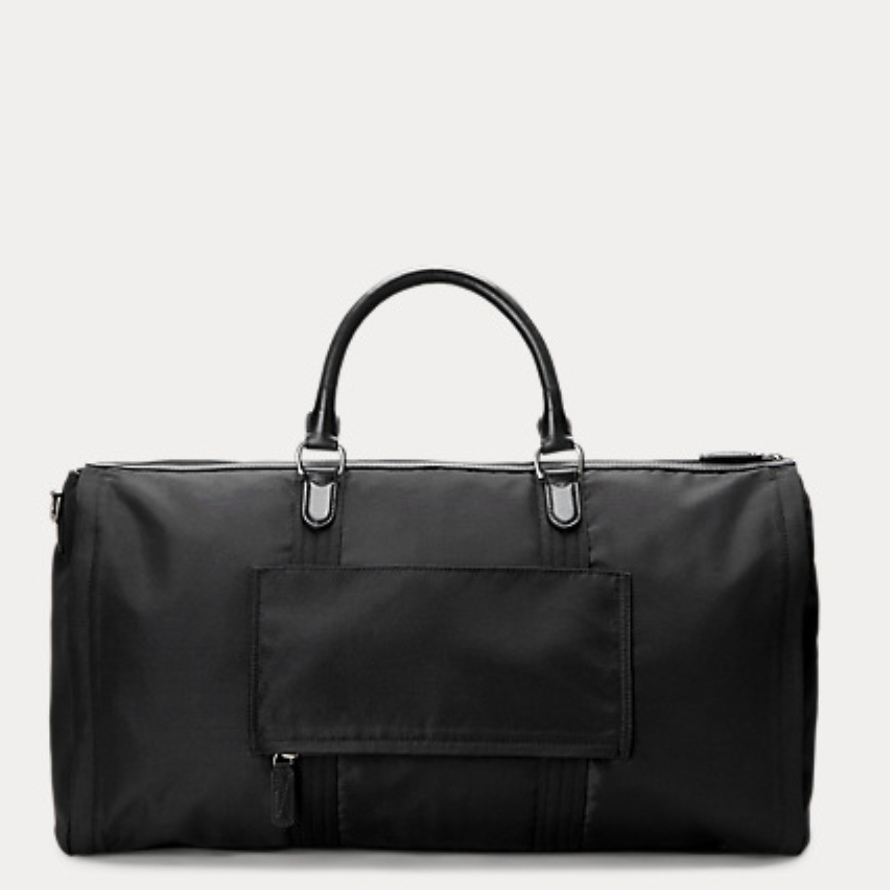
Ralph Lauren’s duffel design is the epitome of understated elegance. An accompanying shoulder strap makes it easy to carry around.
Dimensions: 15" x 21.5" x 9"
Materials: Polyester, leather
Gucci Savoy Garment Bag
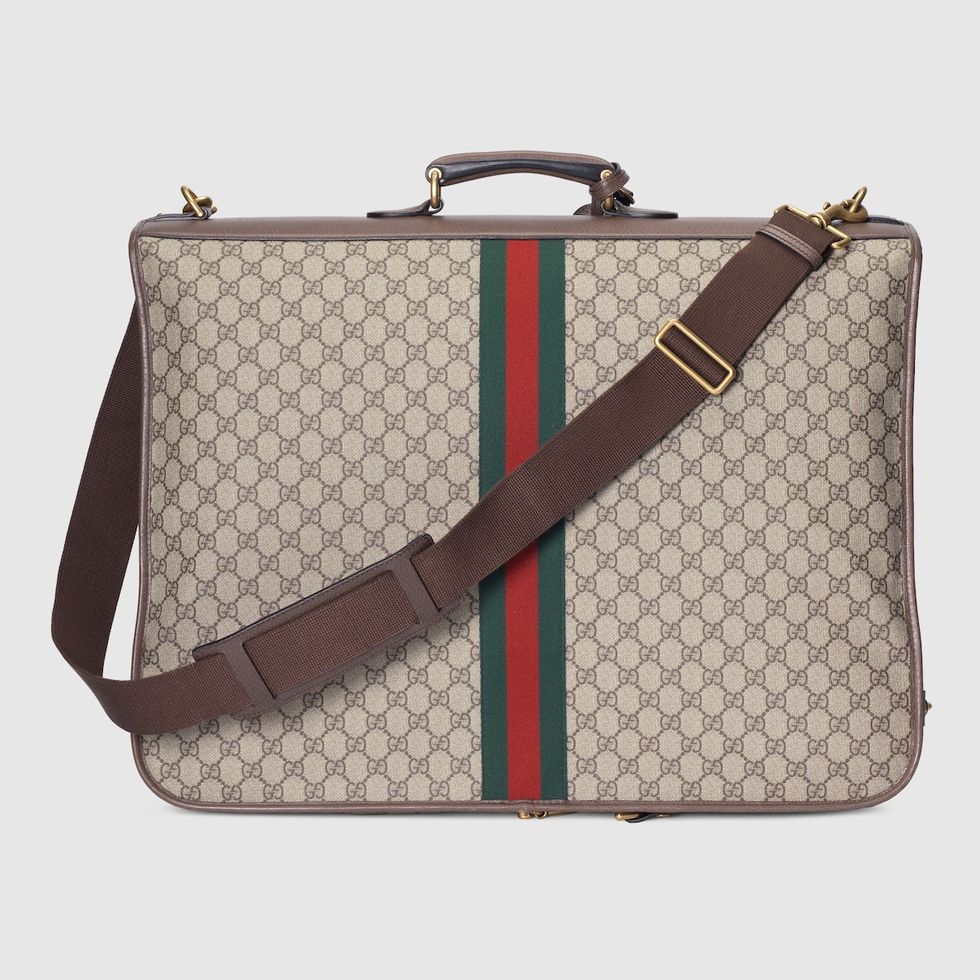
Embrace the bold luxury aesthetic with a Gucci bag covered in the house’s monogram. Containing a big compartment with a hanger and two zip pockets, this garment bag will hold all your essentials.
Dimensions: 21.5" x 16.1" x 6.7"
Materials: Canvas, leather, cotton
.css-p3fpzg{font-family:NewParisTextBook,NewParisTextBook-roboto,NewParisTextBook-local,Georgia,Times,Serif;font-weight:normal;letter-spacing:-0.015rem;margin-bottom:0.625rem;margin-top:0.625rem;}@media(max-width: 48rem){.css-p3fpzg{font-size:2.25rem;line-height:1.1;}}@media(min-width: 48rem){.css-p3fpzg{font-size:2rem;line-height:1.1;}}@media(min-width: 64rem){.css-p3fpzg{font-size:2.625rem;line-height:1.1;}}.css-p3fpzg b,.css-p3fpzg strong{font-family:inherit;font-weight:bold;}.css-p3fpzg em,.css-p3fpzg i{font-style:normal;font-family:NewParisTextItalic,NewParisTextItalic-roboto,NewParisTextItalic-local,Georgia,Times,Serif;} Why trust Harper’s Bazaar ?

For more than 150 years, Harper’s Bazaar has been the preeminent fashion, beauty, and lifestyle resource for women at every age. We cover what’s new and what’s next in fashion by working with the world’s leading authorities in ready-to-wear, footwear, accessories, and more. Every story we publish has been thoroughly researched and vetted by our team of editors and industry experts.
Gaby Keiderling is a freelance writer, working on fashion, lifestyle, travel, and sports features.
The Edit: Fashion
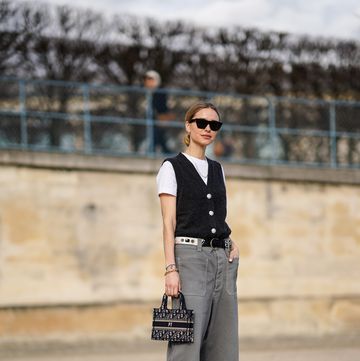
12 Travel Pants for Women on Long Flights
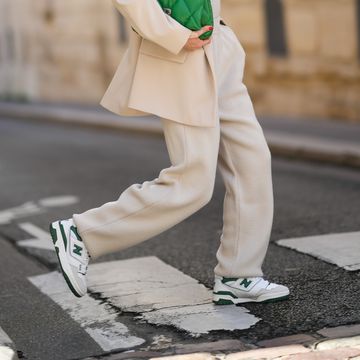
24 Spring Sneakers to Shop for 2024
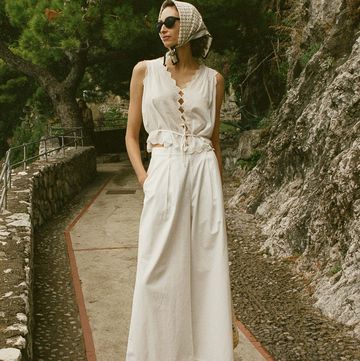
15 Lightweight Pants for Effortless Summer Outfits
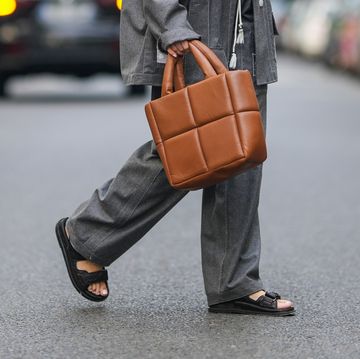
Sandals That Feel as Breezy as Linen Pants

The 10 Best New Balance Shoes

21 Matching Workout Sets for Every Type of Workout
16 Comfortable Sneakers to Wear All Day, Every Day
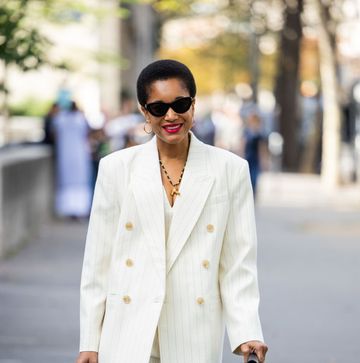
12 Suit Sets That Aren’t Just for the Office

The 20 Best Designer Bucket Bags

7 Ways to Style Carhartt’s Classic $128 Work Pants

5 Sheer Dresses Inspired by Kate Moss
- Vacation Rentals
- Restaurants
- Things to do
- Elektrostal Tourism
- Elektrostal Hotels
- Elektrostal Bed and Breakfast
- Flights to Elektrostal
- Elektrostal Restaurants
- Things to Do in Elektrostal
- Elektrostal Travel Forum
- Elektrostal Photos
- Elektrostal Map
- All Elektrostal Hotels
- Elektrostal Hotel Deals
- Elektrostal Hostels
- Elektrostal Business Hotels
- Elektrostal Family Hotels
- Elektrostal Spa Resorts
- 3-stars Hotels in Elektrostal
- Elektrostal Hotels with Game room
- Elektrostal Hotels with Banquet hall
- Hotels near Electrostal History and Art Museum
- Hotels near Park of Culture and Leisure
- Hotels near Statue of Lenin
- Hotels near Museum and Exhibition Center
- Hotels near Museum of Labor Glory
- Hotels near (ZIA) Zhukovsky International Airport
- Hotels near (VKO) Vnukovo Airport
- Hotels near (DME) Domodedovo Airport
- Dreams Jade Resort & Spa
- Xafira Deluxe Resort & Spa
- Mandalay Bay Resort & Casino
- The LINQ Hotel + Experience
- Bellagio Las Vegas
- Hyatt Ziva Cap Cana
- Isla Bella Beach Resort
- Secrets Akumal Riviera Maya
- Hotel Xcaret Mexico
- Hotel Tapasoli
- Excellence Punta Cana
- Hilton Hawaiian Village Waikiki Beach Resort
- Hotel Chester
- Barcelo Bavaro Palace All Inclusive Resort
- Aruba Ocean Villas
- Popular All-Inclusive Resorts
- Popular Beach Resorts
- Popular Family Resorts
- Popular All-Inclusive Hotels
- Popular Hotels With Waterparks
- Popular Honeymoon Resorts
- Popular Luxury Resorts
- Popular All-Inclusive Family Resorts
- Popular Golf Resorts
- Popular Spa Resorts
- Popular Cheap Resorts
- All Elektrostal Restaurants
- Cafés in Elektrostal
- Chinese Restaurants in Elektrostal
- European Restaurants for Families in Elektrostal
- European Restaurants for Large Groups in Elektrostal
- European Restaurants for Lunch in Elektrostal
- Fast Food Restaurants in Elektrostal
- French Restaurants in Elektrostal
- Italian Restaurants in Elektrostal
- Japanese Restaurants in Elektrostal
- Pizza in Elektrostal
- Russian Restaurants in Elektrostal
- Seafood Restaurants in Elektrostal
- Vegetarian Restaurants in Elektrostal
- GreenLeaders
- Elektrostal
- Things to Do
- Travel Stories
- Rental Cars
- Add a Place
- Travel Forum
- Travelers' Choice
- Help Center
- Europe
- Russia
- Central Russia
- Moscow Oblast
- Elektrostal
- Elektrostal Restaurants
Ratings and reviews
Location and contact.

PEKIN, Elektrostal - Lenina Ave. 40/8 - Restaurant Reviews, Photos & Phone Number - Tripadvisor

IMAGES
VIDEO
COMMENTS
Crafting a crystal clear and correct buyer persona is the key to unlocking the full potential of your luxury brand's marketing campaigns. With a deep understanding of your audience, supported by ...
Buyer personas are an integral part of the inbound philosophy and as such an important tool in the modern luxury marketers toolbox. Great personas should incorporate demographics, geo-targeting, psycho-graphics and other data sources. With accurate personas, a luxury travel marketer can create copy, branding materials, campaign and ...
Marriott has identified two main luxury travel personas. It has characterized the Ritz-Carlton, St. Regis, and JW Marriott as " classic luxury ", while the other five brands are considered purveyors of " distinctive luxury ". "This is largely an indication of style: traditional and business travel-friendly ("classic") vs. modern ...
Luxury Seekers. These travelers value quality over quantity when it comes to their getaways - they prefer luxury hotels and resorts that offer five-star amenities like high-end spa treatments, limousine service, yacht charters, fine dining experiences, lavish shopping opportunities, etc., all while providing a unique experience tailored ...
The luxury traveller expects individual attention privacy and exclusivity. Now more than ever luxury travellers want to feel that they are the only ones around. Think private yachts, private islands, custom tours and private excursions. Often this starts with travel advisors who are there to make guests' trips completely tailored and one-of-a ...
Work with sales, marketing, and management teams to develop the brand's unique luxury persona. This persona includes a number of things: Demographics: age, place of residence, gender, family status, net worth, source of income. Media consumption preferences: typically used devices, apps, social media networks, sources of news and inspiration.
It is critical for luxury travel brands to be present throughout each of these four phases if they want to positively influence their customers' decisions. There are four essential travel phases that matter in the customer journey: Dreaming phase: I-want-to-get-away moments. Planning phase: Time-to-make-a-plan moments.
Great! Now it's time to take all those details and assemble them into a usable buyer persona. First, give your persona a name. It can be whatever you want — Robert the Retiree, Bill the Business Traveler, Lisa the Family Vacation Planner. Just first names like Jennifer, Christina and Jeremy are acceptable as well.
In the last 12 months, these 6.7 million households took 40 million vacations and spent $67.5 billion on leisure travel. Also, in the coming year, luxury travelers intend to spend about $10,500 on ...
Apply this core aspect: Use the understanding of your buyer personas' buying triggers to: Influence your site content. Strengthen your calls-to-action. Improve your pricing strategy. Strong campaign performance comes from ensuring your marketing resonates with your target personas. Create ads and marketing messages that are relevant to your ...
DUBAI - It may seem a little cliche, but there's really nowhere else in the world better for luxury travelers than Dubai.After all, this is the city with a seven-star hotel, a huge shopping mall featuring all the luxury brands, and man-made islands with the most perfect beaches you've ever seen.If you're a luxury traveler, then Dubai is an absolute must-visit.
Given the significance of personalized engagement, this report uncovers travel 'personas', including the smart, well-informed planner (31 %), relaxed nomad - easygoing and flexible (25 %), and deal seeker on a budget (22 %). These personas each have their own influencers, deterrents, and innovations they are most likely to leverage when ...
These attractions can appeal to travelers in each segment of the tourism market. However, the packaging of your offering is also essential, and every element is intangible and must heighten the tourist's experience. Price: Price is a significant factor in the 4Ps of travel and tourism. All tourism products are unique.
The market for luxury travel has always been in demand and growth has been consistent. A report by Amadeus in 2016 revealed that growth in luxury travel slightly exceeded that for overall travel from 2011-2015, with a Compound Annual Growth Rate (CAGR) of 4.5% (4.2% for overall travel). Additionally, over the next 10 years, the growth rate in ...
Luxury Travellers need one thing - luxury. They are ready to spend money to experience high-class facilities and amenities. They can also come under the casual and casual specific hotel guest persona. They want luxurious rooms, which are spacious with even grander bathrooms. They want to experience luxurious restaurants, spas, and swimming pools.
A "Buyer Persona" is defined as the semi fictive representation of your ideal customer, based on market research and data about your actual customers. We know that we cannot be devoted to each individual (potential) tourist and guest, so long as their number is higher. Similarly, we cannot offer the same product or service to all our ...
5 Most Common Travel Personas That You Can Expect To Interact With - Let's take a look at a few common types of hotel guests. The Green Traveller. With the growing emphasis on the global climate ...
Moreover, a luxury traveler will look for a personalization in his interests and the quality of hotels. Perhaps they like classic luxury hotels and opulence, or simple and comfortable luxury, modern hotels, wellness experiences, gastronomic experiences, exceptional locations…. A luxury traveler looks for a personalized experience in all senses.
Persona 1: Family vacation fun and relaxation. Julia is 40 years old, married and mother of two children, 7 and 5 years old. ... Plus the self-identifying groups of Luxury Travelers, Independent Travel ers and Habitual Travelers, who often return to the same place because they like it and that doesn't require planning.
This type of traveller prefers brands that provide an exclusive and personalised service. Moreover, it is very active on social networks, where they share their day to day and trips. As the cultural traveller, the hyper connected traveller travels alone and uses price comparison sites. Nevertheless, they book in advance and chooses dynamic ...
24 APRIL 2024, LONDON: IHG Hotels & Resorts is celebrating the significant achievements of its upper luxury portfolio today following the announcement of three of the industry's most coveted awards selected by leading travel editors. A collective showcase of the crème de la crème of the global hospitality industry, Condé Nast Traveler Hot List, AFAR's Best New Hotels of 2024 and the ...
Hotel Colline de France. Here are the Best of the Best Hotels for 2024 as selected by Tripadvisor readers. 1. Hotel Colline de France - Gramado, Brazil. Winner for three years in a row, this ...
A 2022 survey by American travel company Expedia Group of 11,000 customers found that 90 per cent seek sustainable travel options. Many high-end brands in Nepal have committed themselves to an ...
They Aren't Cheap. Travel. The hottest hotel rooms right now are luxury tents and RVs. They can cost more than $2,700 a night. Brittany Chang. Apr 24, 2024, 11:23 AM PDT. Hyatt and Hilton are ...
Hippies, Hikers and Luxury Travelers All Agree Sedona Is the Place to Be. The city might have a reputation for out-there New Age thinking, but it also welcomes vacationers with world-class hiking ...
Longchamp's iconic nylon and leather trim takes on a garment bag silhouette. The two-tone design exudes sophistication, with practical touches like a top carry handle, built-in hanger, and front ...
Clare Duffy, de CNN Business, habla con Julia Chatterley sobre el nuevo modelo de inteligencia artificial de Microsoft, el cual es capaz de unir una imagen fija de una cara y un clip de audio de ...
Apelsin Hotel, Elektrostal: See 43 traveler reviews, 19 candid photos, and great deals for Apelsin Hotel, ranked #1 of 4 hotels in Elektrostal and rated 4 of 5 at Tripadvisor.
Vecherniy Kosmos: Time travellers, its your choice - See 19 traveler reviews, 4 candid photos, and great deals for Moscow, Russia, at Tripadvisor.
Pekin. Review. Save. Share. 17 reviews #12 of 28 Restaurants in Elektrostal $$ - $$$ Asian. Lenina Ave., 40/8, Elektrostal 144005 Russia +7 495 120-35-45 Website + Add hours Improve this listing. See all (5) Enhance this page - Upload photos! Add a photo.